

For my Family
July, 2014, Online Edition
Text and Art Copyright (C) Rudy Rucker, 2014
Get paperback edition via
Transreal Books.
I took up painting in 1999 while writing a novel about the Flemish master Peter Bruegel the Elder. Quickly I fell in love with the medium. I used acrylics at first, but I’ve come to prefer oils as they seem richer and deeper. My studio is a plastic chair and table in our back yard.
I enjoy the exploratory and non-digital nature of painting, and the luscious mixing of the colors. Sometimes I have a specific scenario in mind, other times I don’t think very much about what I’m doing, I just paint and see what comes out.
First I get a rough version of a painting, and then I’ll polish and tweak it through several iterations. I’m never in a rush to finish. I like exploring these better worlds.
My pictures are realistic in that they contain recognizable objects, but fantastic in their use of heightened colors, cartoony simplifications, and odd scenarios. Some of the pictures seem to tell a story. The stories may relate to my novels, or they may be free-floating parables—ambiguous, with their precise meanings unknown.
The paintings are arranged in the order that I painted them. Notes on the individual pictures are collected in the back of the book. And I have a website where it’s possible to buy prints and originals, see:
www.rudyrucker.com/paintings.
Rudy Rucker, Los Gatos, California, July 1, 2014
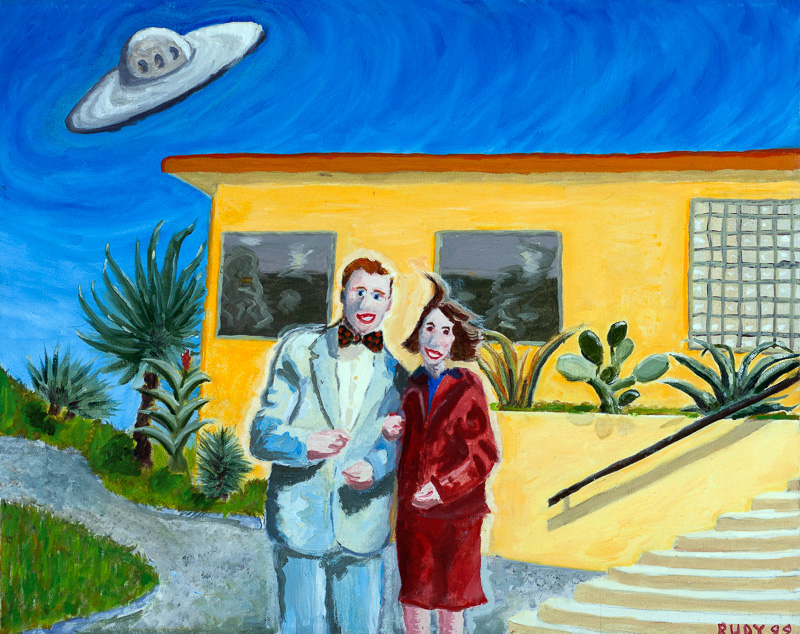
Oil on canvas, 20" x 16", Oct, 1999.
I started painting in 1999 because I was working on a novel about the life of the painter Peter Bruegel. I wanted to understand from the inside how it felt to paint. And I've always thought it might be fun to find an alternate creative outlet besides writing. My wife Sylvia has been a painter from way back. We signed up together for an evening painting class sponsored by the San Jose Art Museum. We learned to use oil paints, and I stuck with them for a few years. My first painting was based on a photo of my parents, taken on a rare trip of theirs to Florida in the early 1950s. I added a UFO---and discovered a personal style. Note that my mother's hair is pointing upwards towards the saucer. I used to call this picture The Immaculate Conception, and say that the saucer impregnated my mother via information-rays, as surely I'm too special a person to be born of normal man and woman! But now I don't bother saying that. I'm more like my parents all the time.
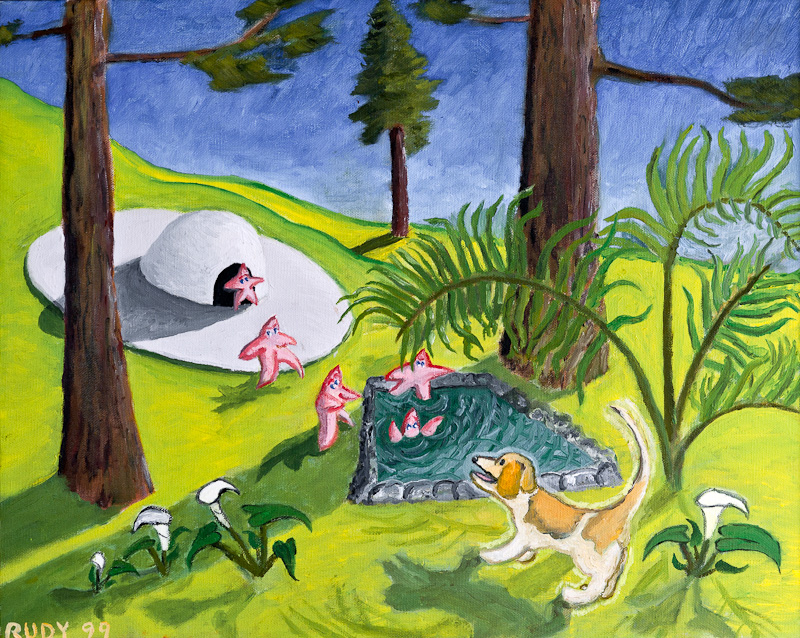
Oil on canvas, 20"x16", April, 1999.
This early painting remains one of my favorites. Beginner's luck. It shows my beloved dog Arf (who appears in four of my novels: The Hollow Earth, Saucer Wisdom, Frek and the Elixir, and As Above So Below). He used to drink out of a certain fountain in Los Gatos every day. I sketched him there and added a UFO. When I made the aliens look like starfish I was thinking of H. P. Lovecraft's obsession with echinoderm-like aliens. But my niece Stella thought of a cuter explanation for their appearance: the aliens are the stars from the sky!
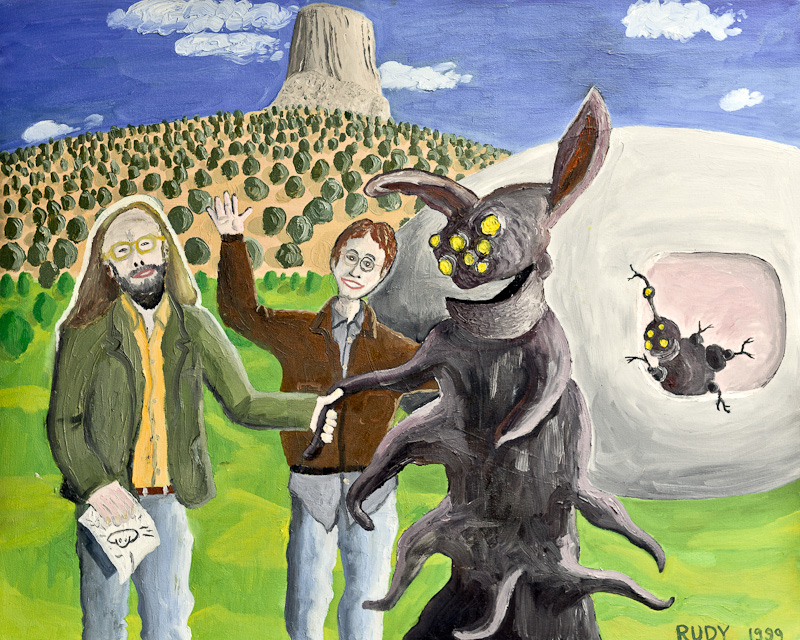
Oil on canvas, 30" x 24", June, 1999.
In 1999 I published a millennial novel Saucer Wisdom. It was marketed as a non-fiction work of futurology. To complicate things, one of the characters is "Rudy Rucker." This painting shows my character Frank Shook, my character Rudy Rucker, and a Mandelbrot-set-like alien near the Devil's Butte in Montana—a saucerian locale I visited for research.
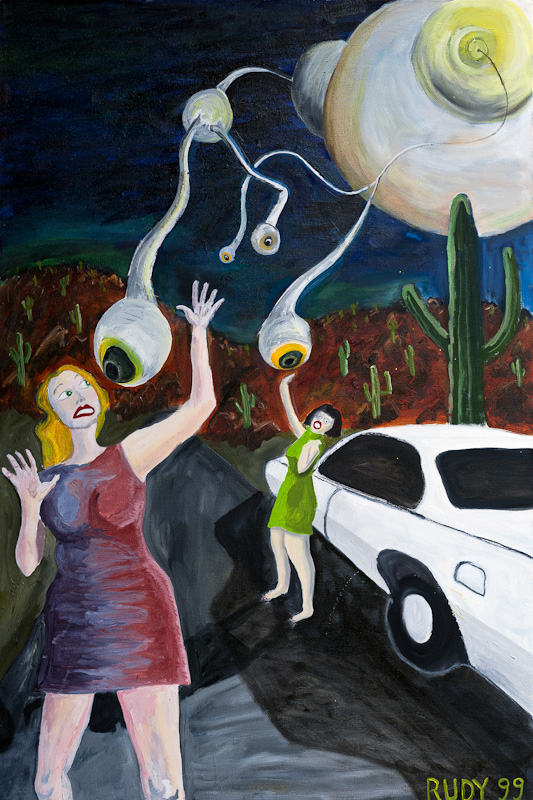
Oil on canvas, 24" x36", October, 1999.
Sylvia served as the artist's model for the women under attack; I took two photos of her in the Mojave desert pretending to be seeing a saucer. A few years ago I wrote a short story "As Above, So Below," that's in my Complete Stories collection. The story is about a UFO that is a giant multidimensional fractal of the kind called a "Mandelbrot set." This story was also produced as a one-act play in Fort Worth, Texas.
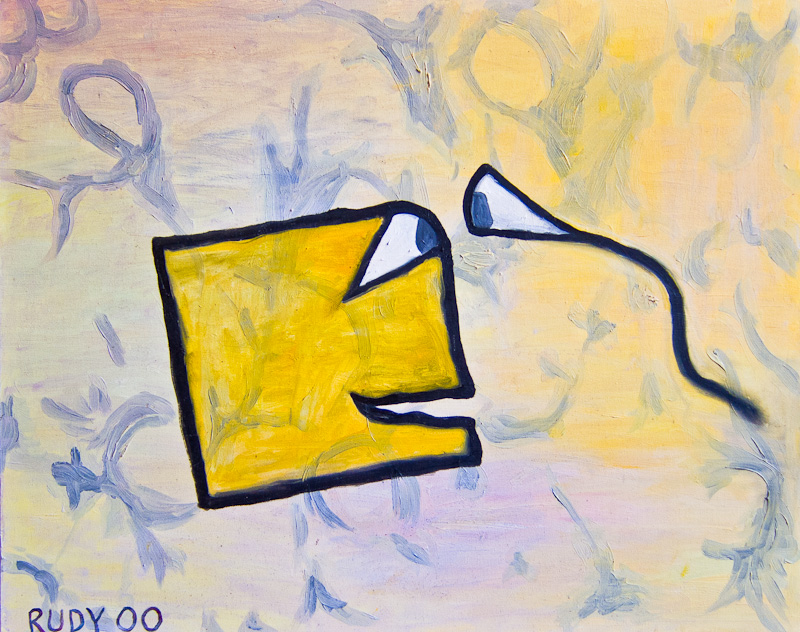
Oil on canvas, 30"x24", May, 2000.
This is A Square, the hero of Edwin Abbott's novel Flatland. His wife is a line segment. She's beating her tail, that's why it's blurred. I got the underlying Flatland space pattern from some leaf shadows that were falling onto my canvas as I painted in the back yard.
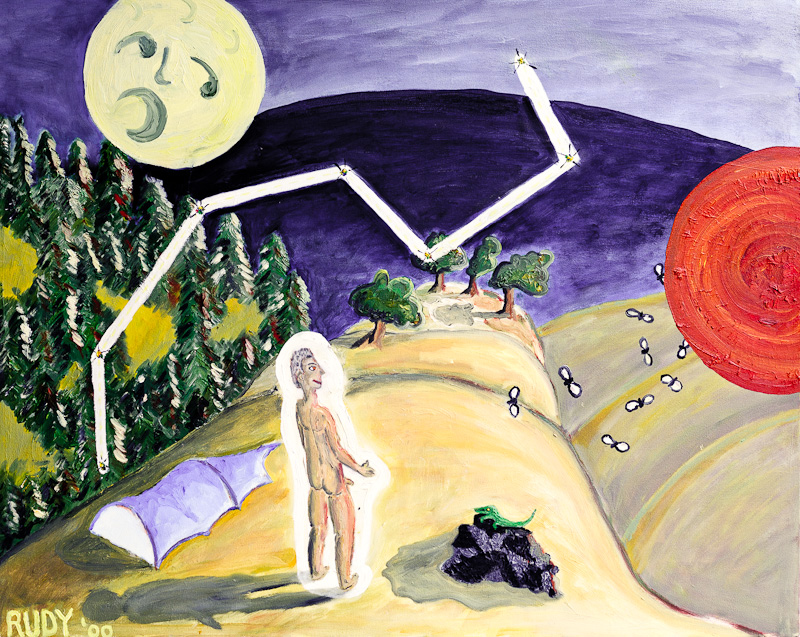
Oil on canvas, 30" x 24", August, 2000.
In 2000, I went camping alone near Kirk Flats in Big Sur. The second night I was standing there naked watching the sun go down and the moon come up. I could feel the Earth turning like a big wheel, and soon I saw the Big Dipper in the sky. I had some problems with flies biting me and I saw a lizard on a rock, so they're in the picture too.
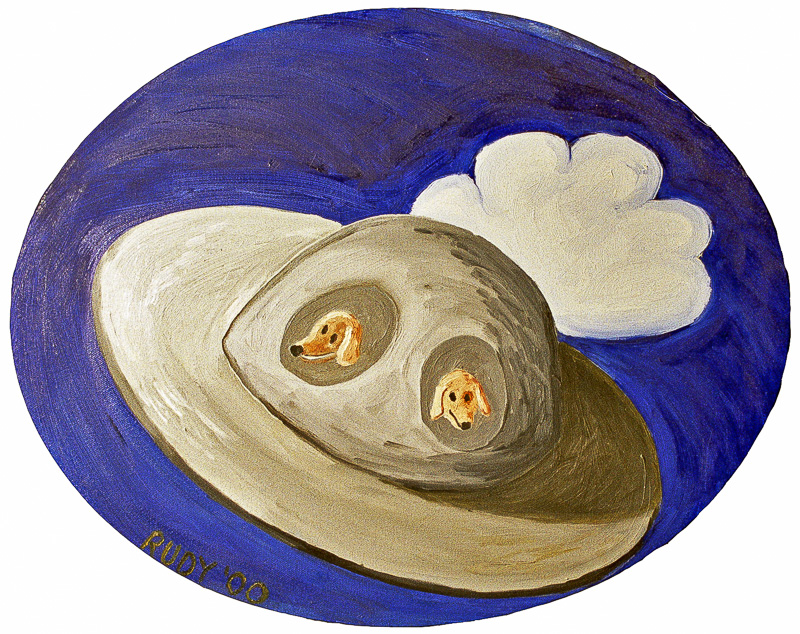
Acrylic on canvas, 20" x 16", Sept 2000.
This is a simple little painting that I made for my daughter Isabel. Two dogs in a UFO! This was one of the first paintings I did in acrylic paint. The dogs are modeled on our old family pet Arf, whom I also painted into 2: Arf and the Saucer, 10: Stun City, and 19: The Hollow Earth. Here's a description of Arf from my novel, The Hollow Earth: "He had the noble profile and the feathery legs of a retriever. His legs and ruff were white, but his head and body had the tawny coloring of a collie. I'd grown up talking to him like a person. He had a way of moving his eyebrows and his feathery tail so expressively that I often felt he understood me."
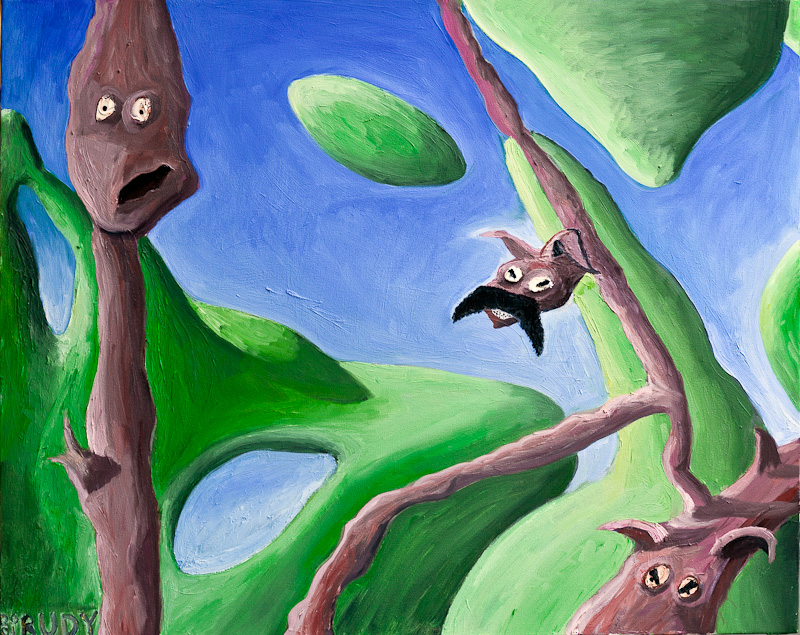
Oil on canvas, 30" x 24", February 2001.
I painted this to help imagine a scene in my novel Spaceland, where my character goes beyond four-dimensional space and into infinite dimensional Hilbert space. I like how smooth the shapes came out. That creature with the mustache is Drabk the Sharak of Okbra, which is a name I drew from Kee Dewdney's book, The Planiverse—with Kee's permission. Here's some of the text in my novel: "Thanks to some oddity of the fourth dimension, many of the hills seemed to float up in the sky. Conversely, there were holes in the ground holding patches of blue sky. Weaving from hill to floating hill were the thick, brownish-purple stalks of enormous vines."
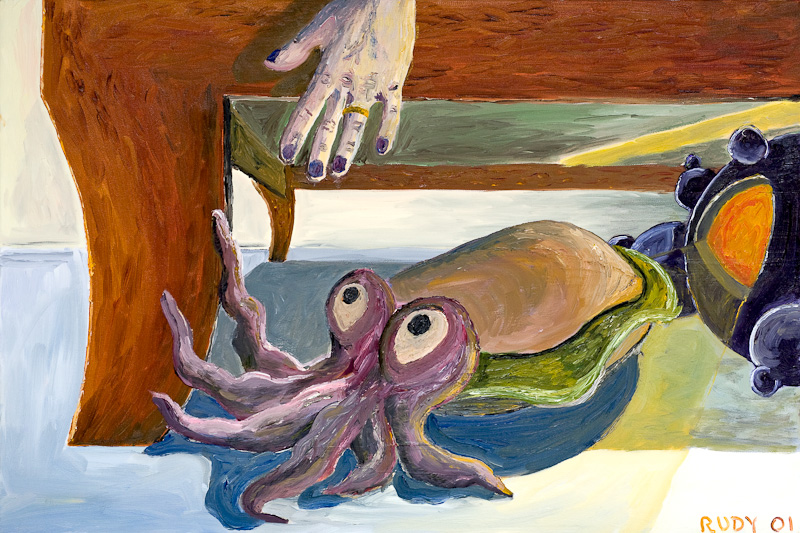
Oil on canvas, 30" x 20", May, 2001.
In the first chapter of my novel Frek and the Elixir, the young hero Frek discovers a UFO under his bed with an alien cuttlefish as passenger. (Actually that's my hand in the picture, not Frek's.) I got the glowing look of the saucer door from an oven door in Hieronymus Bosch's The Last Judgment in Vienna. Here's the passage where Frek sees the UFO: "A bright triangle of yellow-orange light glowed in its side. The triangle was a door with a thing coming out: a tiny form dark against the light, growing bigger, moving forward, its shape coming clear as it came. It was a flattish lump with a cluster of arms or legs sticking out the front end. It had two shining eyes—a cuttlefish. The cuttlefish gazed up at Frek with large, kind, wise eyes."
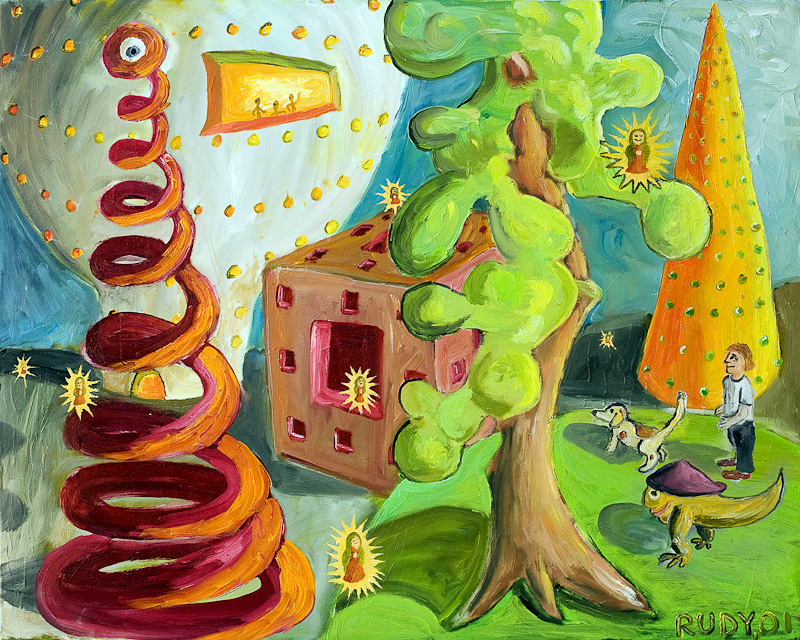
Oil on canvas, 30" x 24", December, 2001.
This image illustrates the second chapter of my far future SF novel Frek and the Elixir. It's a biotech world in which the buildings are grown. Next to Frek are his faithful dog Arf and his "grulloo" friend Gibby. They've just arrived at a town called Stun City. I painted in a bunch of Virgins of Guadalupe into the picture as well, even though they don't figure in the novel. I've always thought these religious icons look somehow science-fictional: a little figure floating in a spiky glowing ball. Here's a bit from the text: "The town lay spread out before them, a lush parkland of house-trees and aircorals, with its famous central cluster of enormous, odd-shaped buildings. The huge NuBioCom puffball had just turned on its lights; sending bright beams out across Stun City, as if reaching for its citizens. The windows were aligned one above the other, forming ribbons like the stripes on a gourd. A bit closer than the puffball glowed the Kritterworks cube. Four sides of the cube were solid, and the two end-walls were cored out with great and small tunnels. Frek could see a big central gallery and at least eight smaller galleries running the length of the cube. The Stun City structure that interested Frek the most of all was the legendary Toonsmithy— a giant beanstalk, trained into the shape of a corkscrew that spiraled up into the sky."
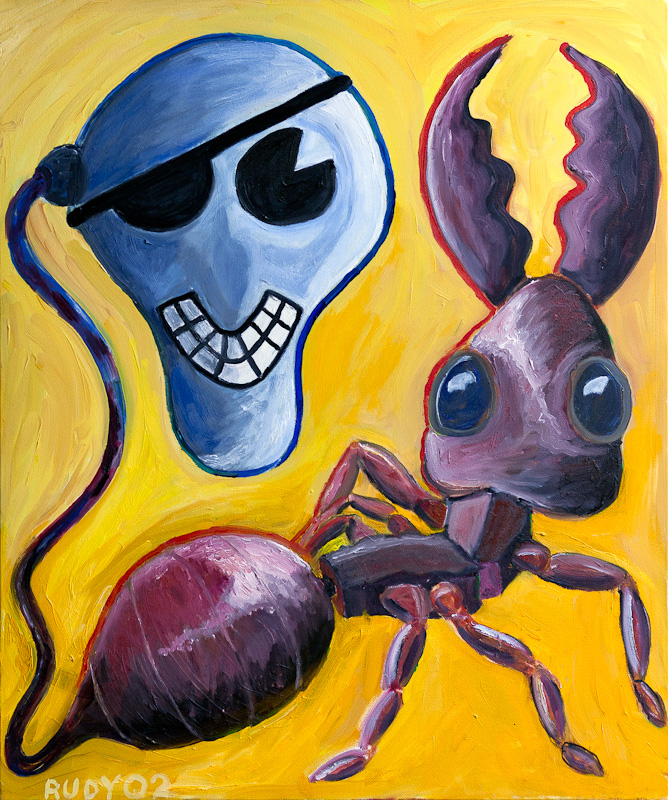
Oil on canvas, 20 x 24, March, 2002.
This is my (unused) design for the cover for my Silicon Valley SF thriller novel, The Hacker and the Ants. I like having the hacker be a skull, a pirate, and a light bulb—and that he's wired into the ant. In my novel an evil computer hacker creates an ant-like virus which destroys television. My character rides a virtual ant through cyberspace to an encounter with the hacker.
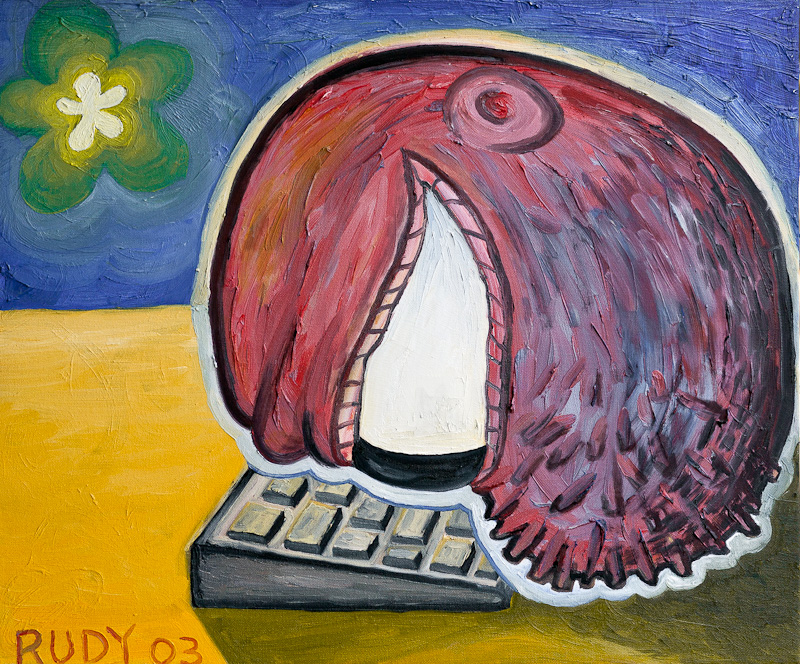
Oil on canvas, 24" x 20", March, 2003.
This is an homage to Philip Guston, who sometimes painted eye-heads like this starting at empty bottles. In a way these were self-portraits. My Guston-style self-portrait shows me focused on a computer keyboard, which is how I while a way a great deal of my waking time.
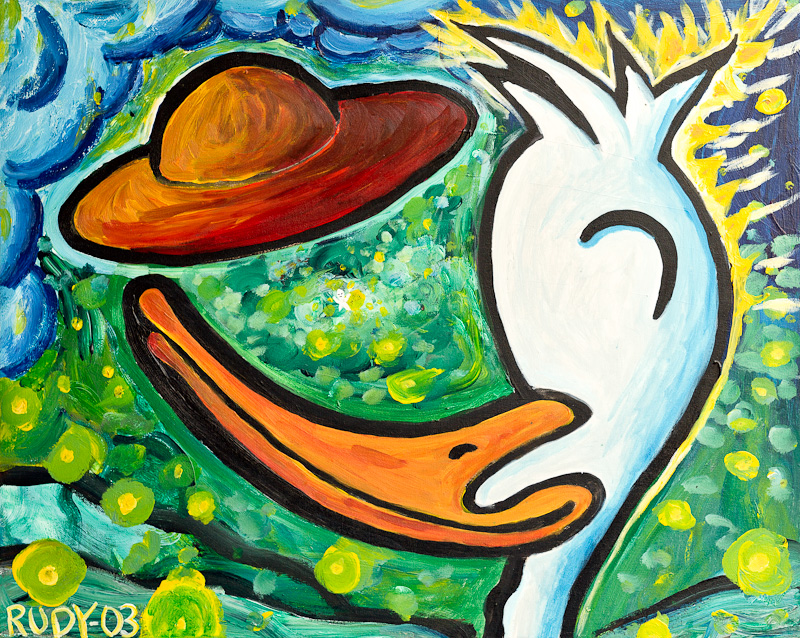
Acrylic on canvas, 30" x 24", July, 2003.
This was my first painting with acrylics. I like how fast I can work with acrylic paint, and how easy it is to clean up, and you can in fact use mediums with the acrylic paint to give it more of oil's transparency and workability. This image was inspired by a frame of a Carl Barks comic book. Naturally I put in a UFO and, if you look closely, a tiny snowflake-like alien in the middle. Sylvia had the idea of giving my duck a Vietnamese name, reminiscent of all the friendly Vietnamese students that she and I have taught here in Silicon Valley. I ended up putting Da Nha Duc into my novel Frek and the Elixir as a cartoon character, with his nephews Huy, Lui, and Duy, "throwing back his shoulders and curving his beak in triumph."
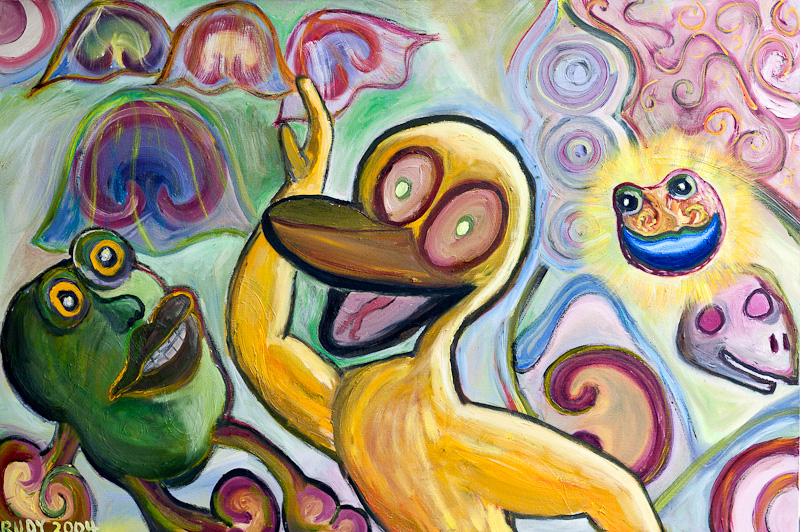
Oil on canvas, 36" x 24", October, 2004.
This is a kind of alien nightclub scene. I was thinking about the other-worldly hangout La Hampa that appears in my novel Mathematicians in Love. Also of the classic Toulouse-Lautrec poster, Moulin Rouge. That's a star frog in the limo on the right. The jellyfish are based on Belousov-Zhabotinsky scrolls, which are one of my favorite types of cellular-automata-based computer graphics.
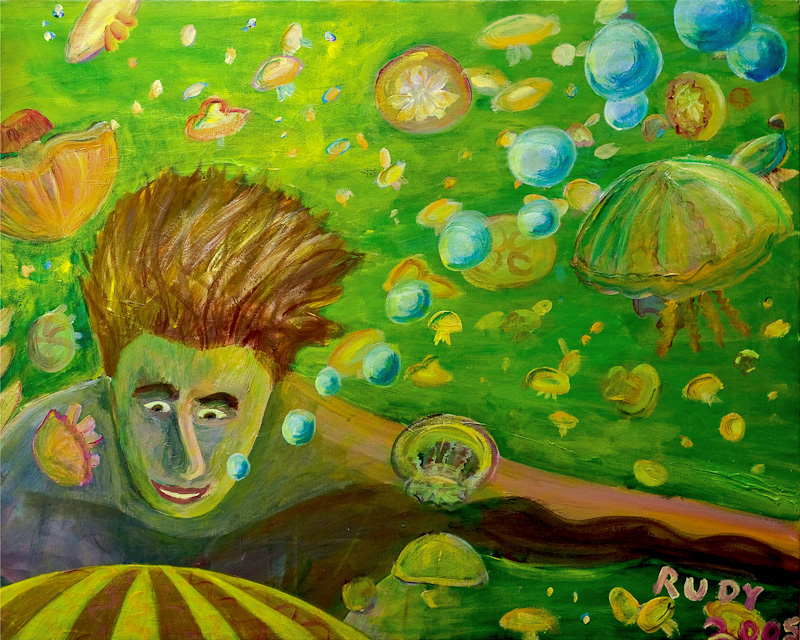
Acrylic on canvas, 30" x 24", June, 2005.
This is inspired by a trip to Jellyfish Lake in Micronesia near Palau; some of my fellow divers took an underwater photo of me in this very pose. I put this scene into my novel Mathematicians in Love, where the big jellyfish just under the diver is a kind of god. Here's a passage describing this scene: "I dove down to about twenty feet, looking for the big one. My visual field held only sunlit yellow-green water and jellyfish, everywhere and at every angle. Just then I felt an upwelling as something huge moved towards the surface. Without even slowing down, the giant jellyfish engulfed me. Each of her gestures was ideally formed and laden with meaning; each gesture was a novel, a theorem, a cosmic work of art."
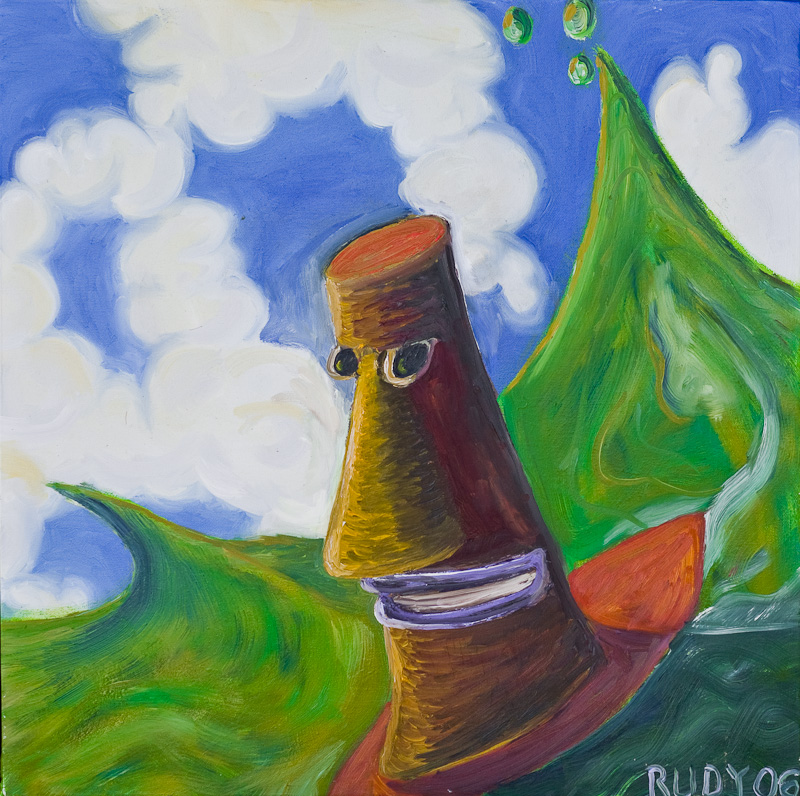
Oil on canvas, 24" x 24", June 2006.
I copied the sky for this picture from the beautiful spring sky overhead, then painted in the waves and the tiki. The surfin' tikis appear in a story I wrote with Marc Laidlaw, "The Perfect Wave." They also appear in my novel Postsingular where I have some giant aliens who look like Easter Island moai statues. Here's a short passage where one of them appears to the main character Thuy: "Thuy thought she saw a live moai peering at her over Jayjay's shoulder—huge, cave-browed, luminous, a tiki god with a pursed mouth that was almost a smile."
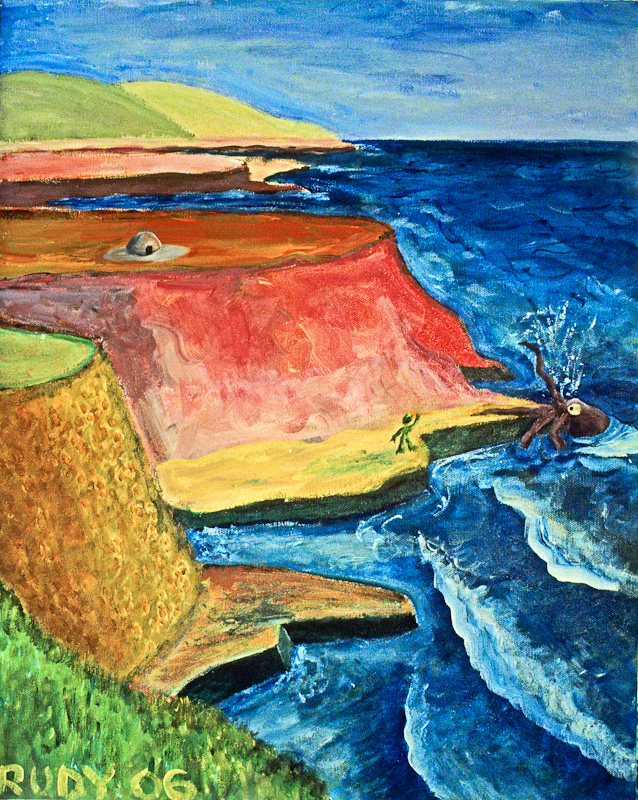
Acrylic on canvas, 16 x 20, July 2006.
My wife and I saw a Monet show in San Francisco and I got excited about painting en plein air. I painted this on a cliff near Davenport, California. Later I added in a UFO, an alien, and a giant squid. Perhaps this was overkill, as it's a pretty strong landscape on its own.
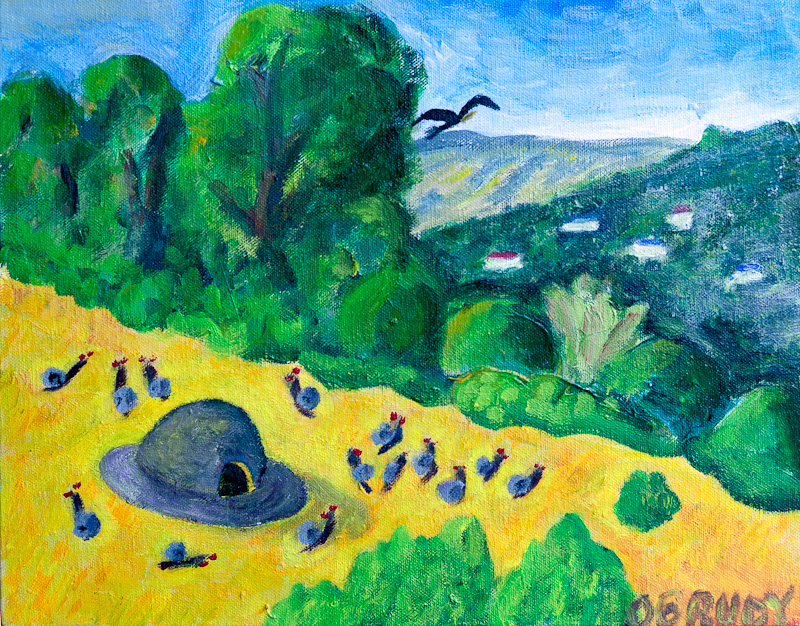
Acrylic on canvas, 14" x 11", July 2006.
I painted this en plein air on a 105 degree August afternoon on Saint Joseph Hill above Los Gatos, California, sitting on the ground with ants crawling into my underwear and biting me. The empty field had stakes from a former vineyard, but when I painted them in, they looked confusing. So I made the stakes into alien snails and added—of course—a flying saucer. In this case, I think the saucer makes the picture.
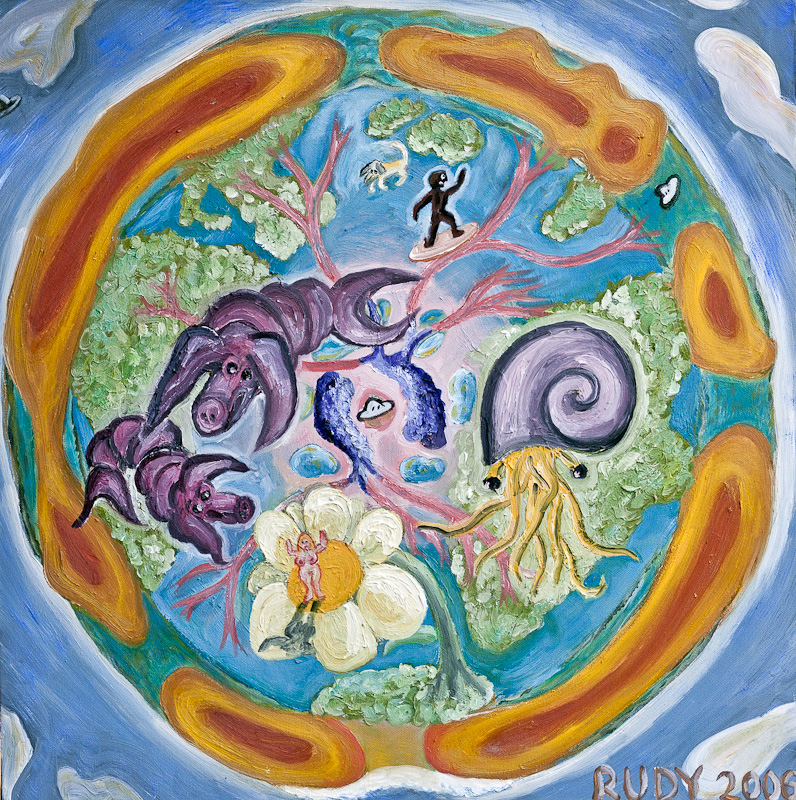
Oil on canvas, 24" x 24", September 2006.
We might suppose the Earth to be hollow like a tennis ball, with the inside filled with jungles, floating lakes, and a mysterious pink light emanating from the center. Also to found are shrigs (= shrimp + pigs), flying nautiluses, and the Great Old Ones that resemble giant sea cucumbers. The painting illustrates my adventure tale The Hollow Earth, supposedly based on an account by Mason Algiers Reynolds, a 19th Century traveler to the Earth's interior. From the novel: "All lines of sight near the Earth's center were warped and distorted, surrounding the center's blobs of blue with weird halos and mirages. Earth's interior was illuminated by the branching pink streamers of light that stretched from the core to the inner surface of the great planetary rind we'd fallen through."
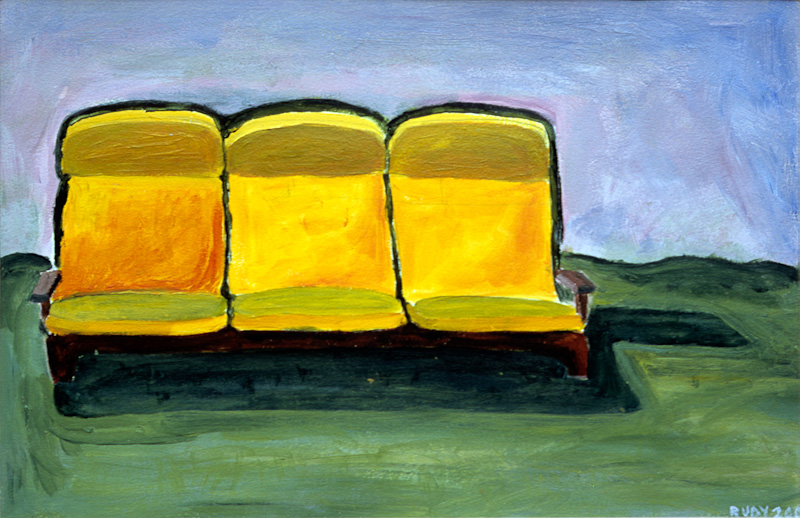
Acrylic on paper, 22½" x 14½", June, 2007.
In June, 2007, my wife and I went to a painting workshop in Caunes, a small village in the southwest of France. Our teacher was the artist Glen Moriwaki. It was great working with him; he brought my art to a new level. This was the first painting I did in Caunes; a yellow lawn-couch on the grass outside our group studio. So as to make it easier to bring the paintings home, I worked mostly with acrylic on paper at the workshop. I like the smoothness of the paper painting surface, but when you're done it's a drag to have to frame the thing. The nice thing about canvases is that I can paint on the edges, and then it doesn't really need a frame.
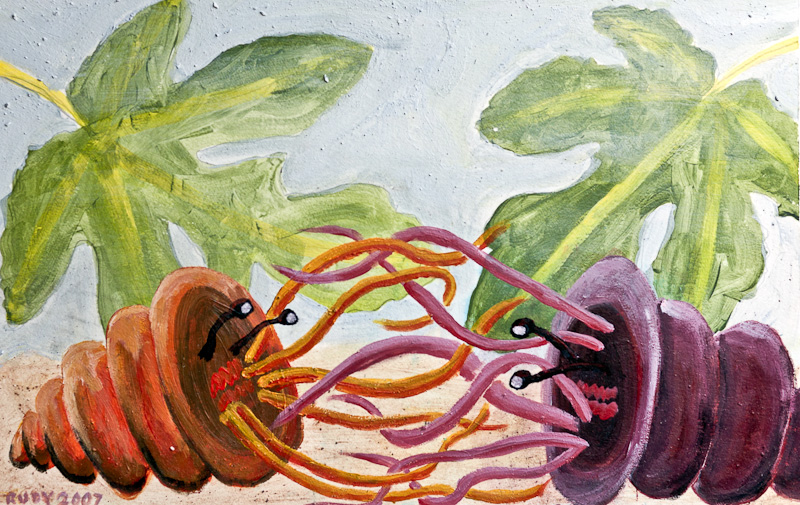
Acrylic on paper, 22½" x 14", June, 2007.
In Caunes, some trees like chestnuts were blooming in long branching flowers. I wanted to paint the leaves and flowers. To simplify things, I traced the shapes of the leaves onto my paper. I set the flowers into two small pots facing each other. And then I had the idea of making the flowers be the tentacles of creatures like cephalopods or hermit crabs. As I painted them, the creatures became deeply entwined, reaching into each others' stuff, like bickering, inseparable partners.
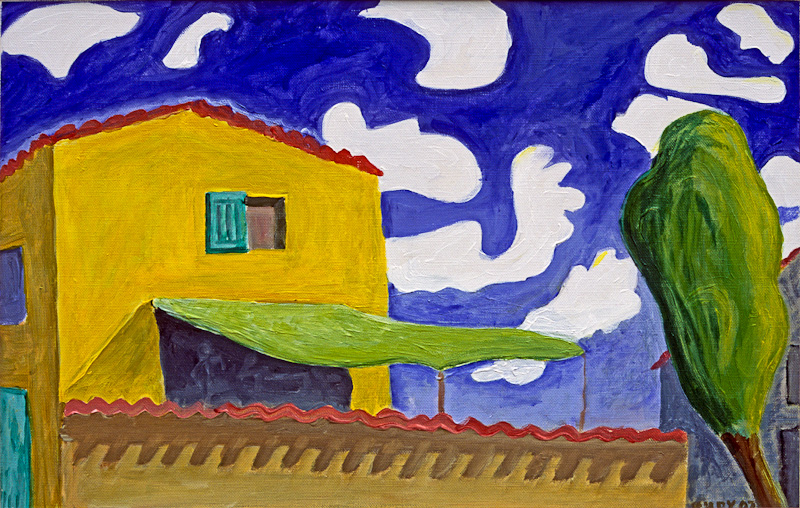
Acrylic on paper, 21½" x 13½", June, 2007.
Our teacher Glen Moriwaki took our class on an outing to the ancient walled town of Minerve. As I was walking around looking for something to sketch for a painting, this awning caught my eye. This scene had the added virtue of being in front of a comfortable bench---which is a good way for an old man like me to pick his subject. I sketched it in pencil, took photos, and filled in the painting back in the studio, simplifying the scene considerably. This picture was featured in a poster for a group show we had at the Live Worms gallery in April, 2008. Someone wanted to buy it, but I gave it to my daughter instead.
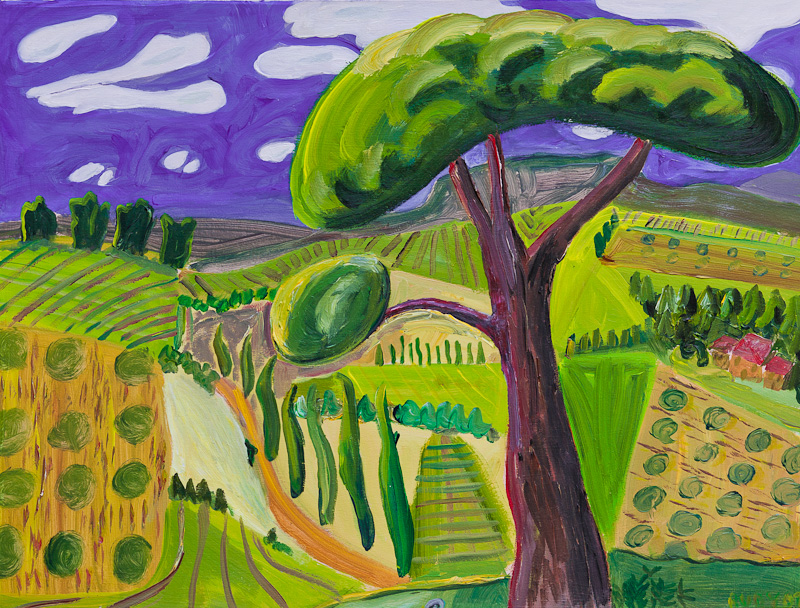
Acrylic on paper, 23" x 18", June, 2007.
Another landscape painting from the South of France, one of my favorites. I took some photos at this spot overlooking Caunes, did a pencil sketch, and painted it back in the studio. Before starting, I primed the paper with some gesso that I'd tinted pink, which gives the whole picture a nice warm quality. The style of this one is inspired by Wayne Thiebaud's late paintings of the fields and rivers in the delta region near Sacramento, California. I was also influenced by Kevin Brown, who was painting next to me in the studio every day. Glen said this painting of mine demonstrates that I could in principle let go of my science-fictional imagery and produce landscapes that are fantastic and dreamy without any additional props, and he's right. But now and then I still like to paint SF things anyway.
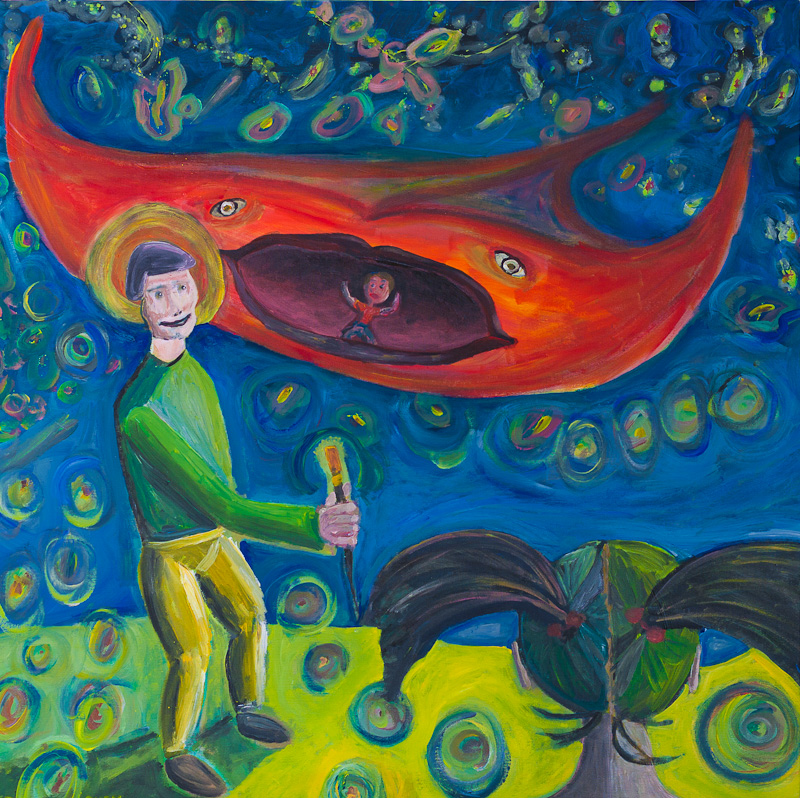
Acrylic on canvas, 38" x 38", June, 2007.
This is the biggest picture I've done so far. I painted it with the canvas still unstretched, stapled to a wall in the studio in Caunes. I was just getting started on my novel Hylozoic, which features a newlywed couple called Jayjay and Thuy. "Hylozoic" is a word referring to the philosophical doctrine that everything is alive: rocks, atoms, stars. The scattered globs of light in this painting are there to represent the notion that in a hylozoic world the very air currents are alive. My character Jayjay has been getting painting lessons from no less a master than Hieronymus Bosch (so of course the picture has to be a triptych.) And that's the back of his wife Thuy's head in the front; she has long pigtails. Duxie the Hrull, a flying manta ray, is about to take them for a ride. But never mind about that.. The main thing here is the colors. It was tough bringing this big unstretched canvas back on the airplane from France; I rolled it up inside some foam rubber and managed to talk the stewardesses into letting me park it in a little closet that they had for their coats.
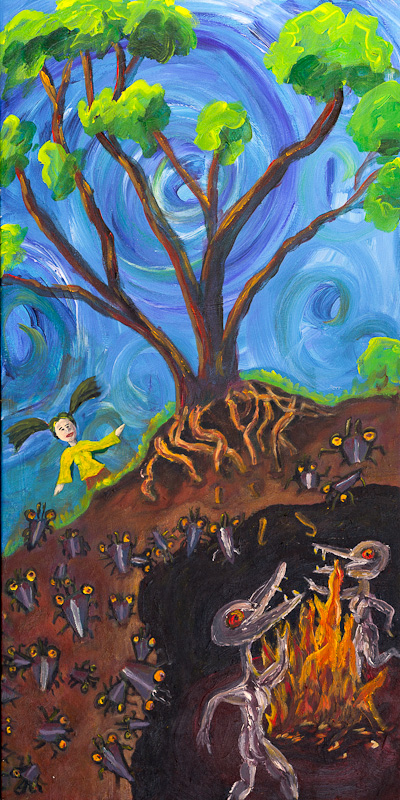
Acrylic on canvas, 19" x 38", August, 2007.
This painting grew out of an en plein air session on St. Joseph's Hill with my painter friend Vernon Head. There's a big oak tree growing at the edge of a drop-off; although it looks a bit unstable, I've been visiting it for twenty years. I like the tree a lot, and I like how I can see some of the roots exposed in the gully wall. I filled the sky with Zhabotinsky scrolls and got the tree done pretty quickly, but then the dirt wall was looking dull. So I covered it with little critters; I was thinking of them as nanomachines, which infest the Earth in my novel Postsingular, which precedes my novel Hylozoic (the central panel of the triptych). Those birds dancing around the fire underground are sinister subdimensional beings called subbies. In Postsingular, they actually try to eat my character Thuy; you can see her uneasily looking down at them.
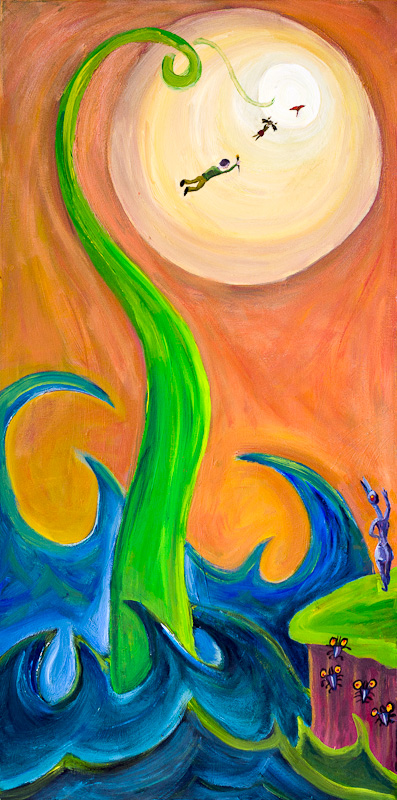
Acrylic on canvas, 19" x 38", September, 2007.
The triptych developed over four months along with my plans for my pair of novels: Postsingular and Hylozoic. I've always been fascinated by the fairy tale, "Jack and the Beanstalk." It's a powerful, archetypal notion: a seed that grows a beanstalk that you can climb to heaven. Given that I planned to write about actually infinite levels of the universe, an endless beanstalk seemed like a good way to get there. I got the composition for this panel from The Ascent of the Blessed, which is a panel in a lesser-known Bosch triptych, depicting souls flying up to a circular disk of white light. You can see Jayjay, Thuy, and Duxie the Hrull way up at the top. And one of the subbies at the bottom is waving good-bye. After painting this picture, I knew I wanted a scene like this in my novel Hylozoic: my characters flying up an endless beanstalk that they find growing out of the subdimensions.
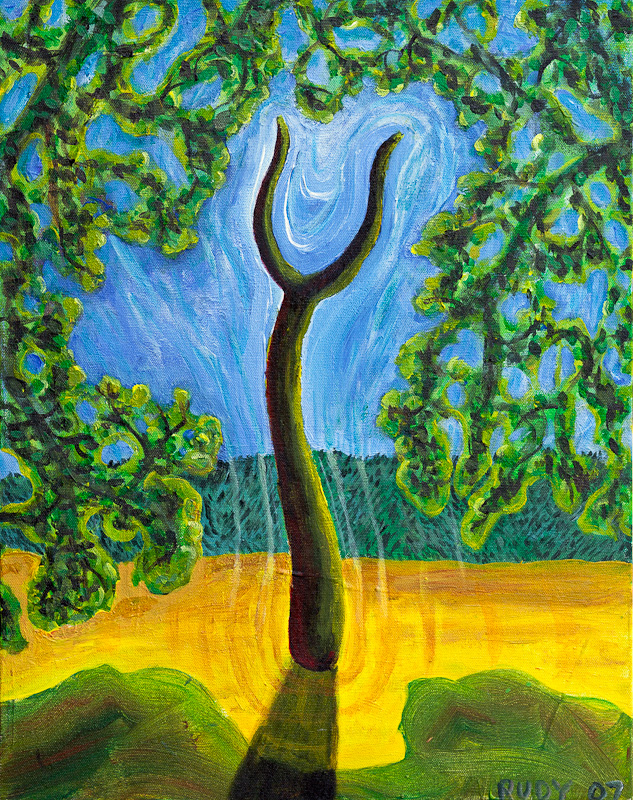
Acrylic on canvas, 16" x 20", July, 2007.
After the trip to France, I was more enthused than ever about en plein air painting. Vernon Head is an outdoor painter, too, so we started going on outings around Los Gatos, not just sketching but taking paints and easels along. This is a field on St. Joseph's Hill; we were up here on a very hot August day, so it was very much a matter of finding a shady spot to paint from. The landscape seemed a little too simple to me, so I went ahead and put in a character who was just about to appear in my novel Hylozoic: a god-like talking pitchfork named Groovy. When I painted this picture, I was thinking that the pitchfork was going to be evil, but as wrote about him more, I learned he was a pretty good guy. A Kentucky hillbilly, basically.
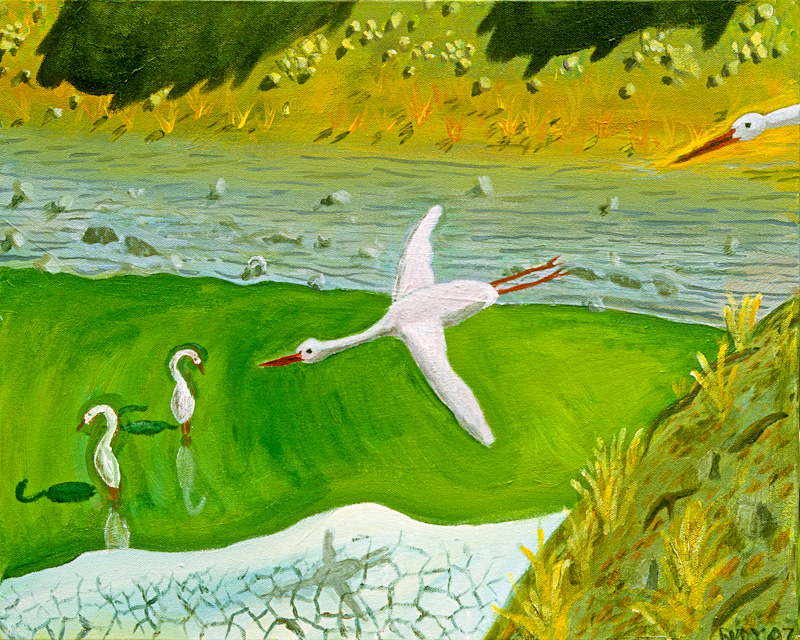
Acrylic on canvas, 20" x 16", August, 2007.
Another blazing hot summer day painting en plein air with Vernon Head. I wanted a scene with water, and I'd found a likely inlet off Lexington Reservoir near Los Gatos. When we got there it was early afternoon, and the only shade we could find was far up in a gully, quite an awkward spot to sit. The annually dwindling water supply of the reservoir etches the steep gravelly sides with horizontal lines like bathtub rings. Some white egrets were hanging out here, and I did see one land, although I didn't actually paint him in till I was back home.
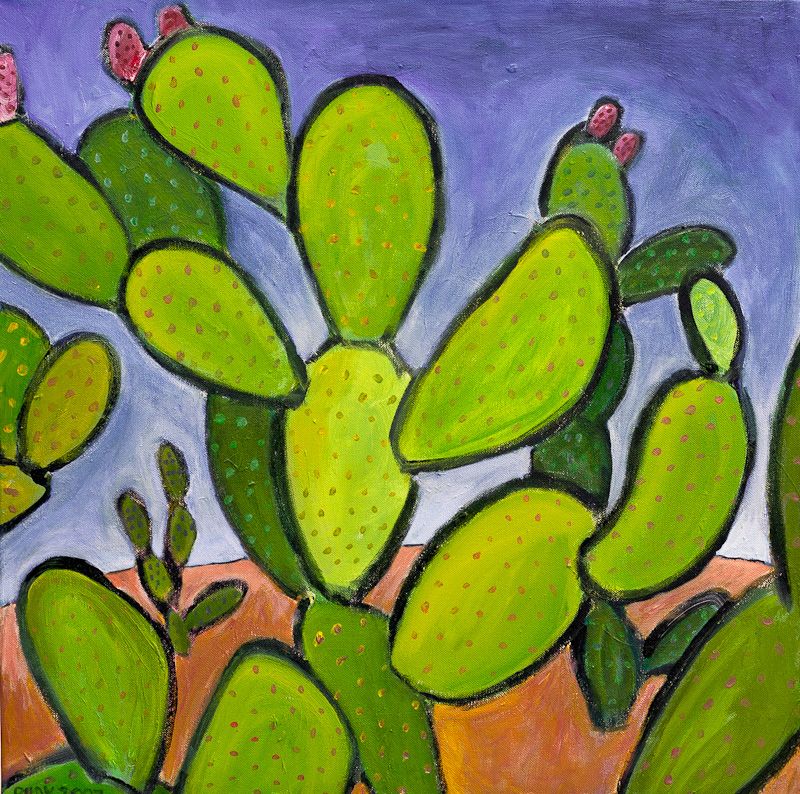
Acrylic on canvas, 24" x 24" September, 2007.
I love the shapes of prickly pear cactus. I spotted a big stand of them up near the Sacred Heart Jesuit Center that stands on a hill over Los Gatos. Vernon and I went up there and I set to work.
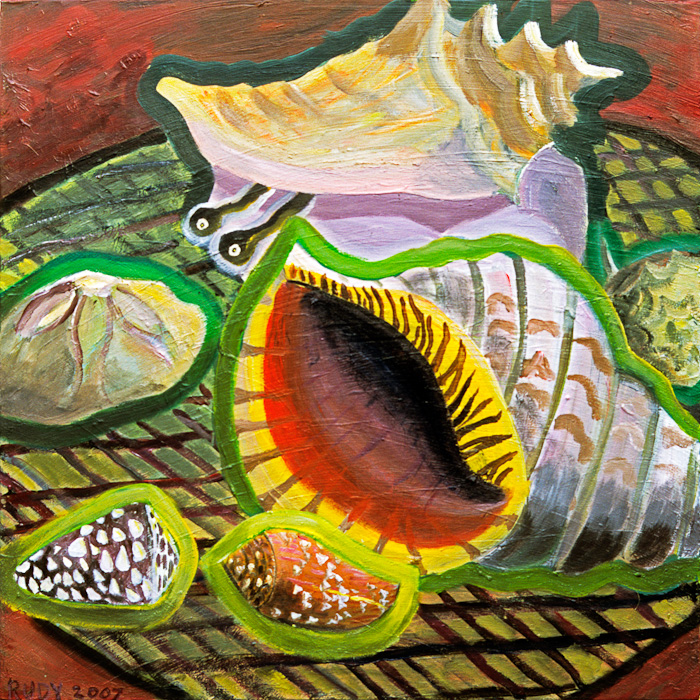
Acrylic on canvas, 30" x 30", October, 2007.
When I was at Glen Moriwaki's workshop in Caunes, I met the artist Kevin Brown. He was a good influence on my painting; as he works very rapidly and freely, often finishing a large painting in a few hours—and just as often going back and totally changing the painting a few hours later. Kevin owns and runs the Live Worms gallery in the North Beach area of San Francisco, which he rents out to emerging artists who want to stage a show of their own. As I'd accumulated quite a few paintings, and I wanted to do something special for the launch of my new novel Postsingular, I got my publisher to help me rent Live Worms for a combined art show and book release party. To round out my set of pictures, I painted a still-life of a bunch of seashells that I had around the house.
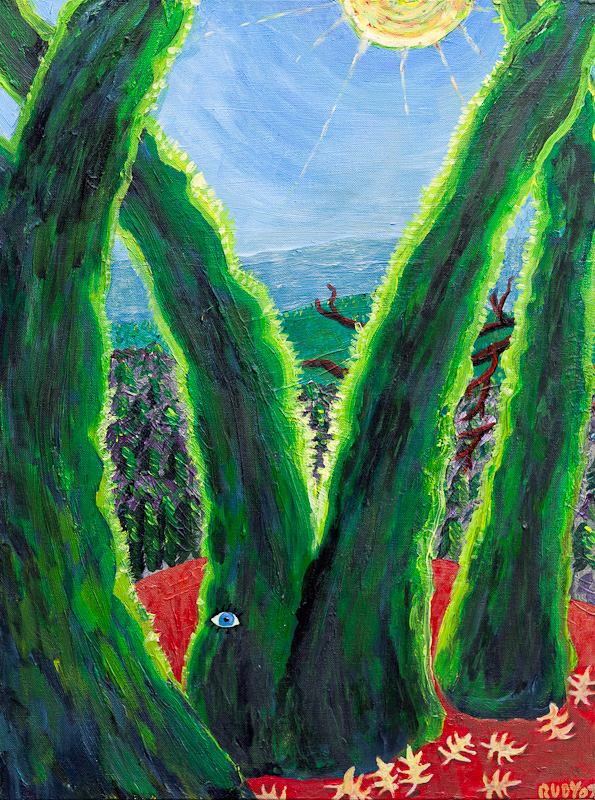
Acrylic on canvas, 18" x 24", November, 2007.
I got into an en plein air thing again in the sunny winter of 2007. I wore a paint stained overcoat and wedged my paints into a knapsack and strapped a canvas to that. It was great to be all covered in paint clothes with a knapsack. I looked like a bum. People looked askance. On a ridge in the Castle Rock park above Los Gatos and Saratoga I found some trees that were completely covered with fronds of moss. The sun was going down in the west over the Pacific Ocean, edging the mossy trees with brilliant yellow-green. The tree's a little like a woman's legs, too, very fertile. To pep up the picture, I added an eye. I like to wrap my paintings around, painting on the edges so I don't have to frame them. I put another eye on the left edge, though you can't see it in this image. It was beautiful here. I was thinking of a drawing by Hieronymus Bosch where he sketches an eye on the ground and an ear on a tree.
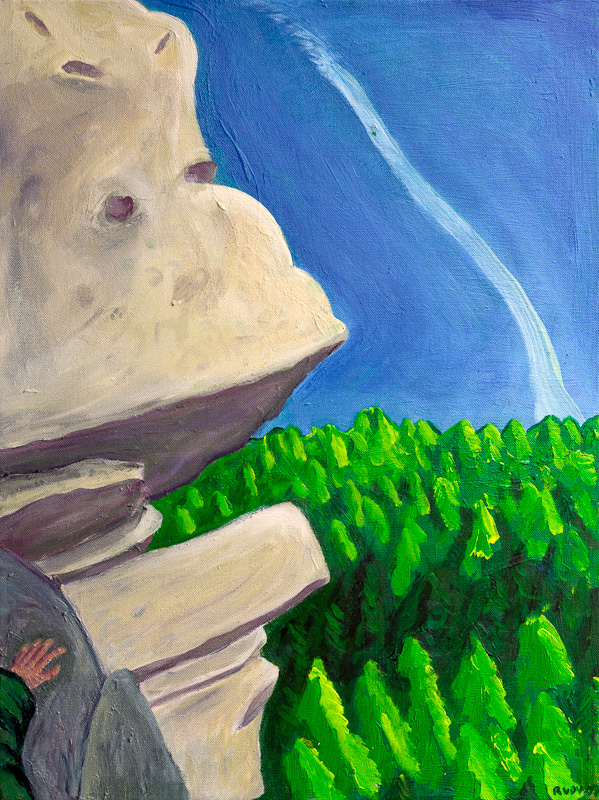
Acrylic on canvas, 18" x 24", December, 2007.
Like 31: Mossy Trees, Giant's Head is a painting I started outdoors in Castle Rock Park near Saratoga, California. This particular rock is called California Ridge. I circled around on a narrow ledge to get to this vantage point. I was somewhat worried about falling off; there was a hundred foot drop to the ground. I painted my hand in there, like clutching at the rock to show that I was scared. The rock itself reminded me of the profile of Homer Simpson. There were a lot of little lichen patches on it; I just tried to suggest those with some spots of color. That white line in the sky is a jet contrail. The green of the trees was really lovely, it felt good being alone up here on the ledge. I didn't have room to stay very clean and I got a lot of paint on myself.
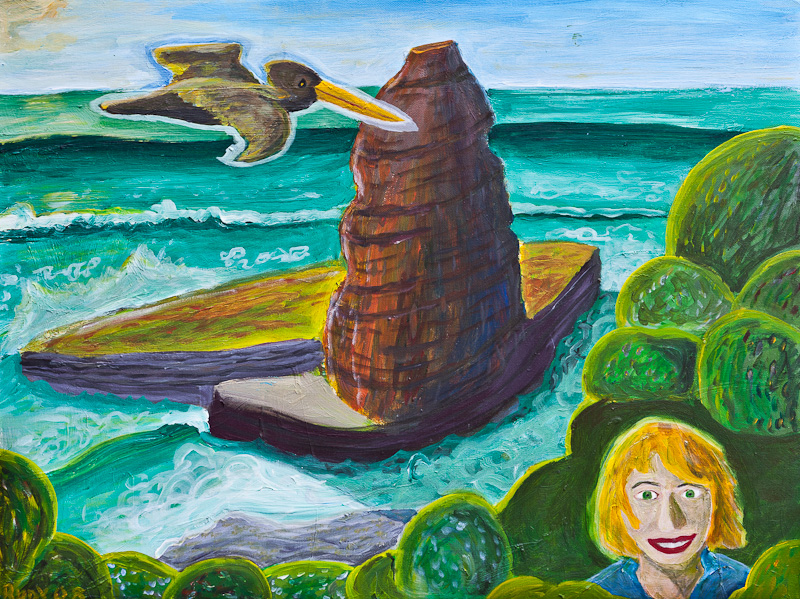
Acrylic on canvas, 24" x 18", January, 2008.
My wife Sylvia was out of town for a week visiting our daughter in New York, and I took my knapsack of paints and a canvas out to a cliff overlooking Four Mile Beach north of Santa Cruz, California. This spire of rock was part of a natural bridge many years ago. I often walk along the beach to this spot; it's usually deserted and very beautiful. You don't see any sign of human activity in any direction. This was the first time I'd gotten onto the cliff right above the rock. It was a very windy day, and I found a depression in the cliff, a little grassy dell, and I settled in there. I particularly wanted to get the shape of the long, breaking dark wave near the horizon. A pelican flew past and I got a digital photo of him. I wished Sylvia were there with me. At home, I printed out a large image of the pelican I'd seen, also an image of Sylvia, and I slid those images around on the canvas until the composition looked right. And then I outlined those spots and painted copies of the images. I think of the woman as the muse. When I go out alone in nature, that's who I'm hoping to hear from.
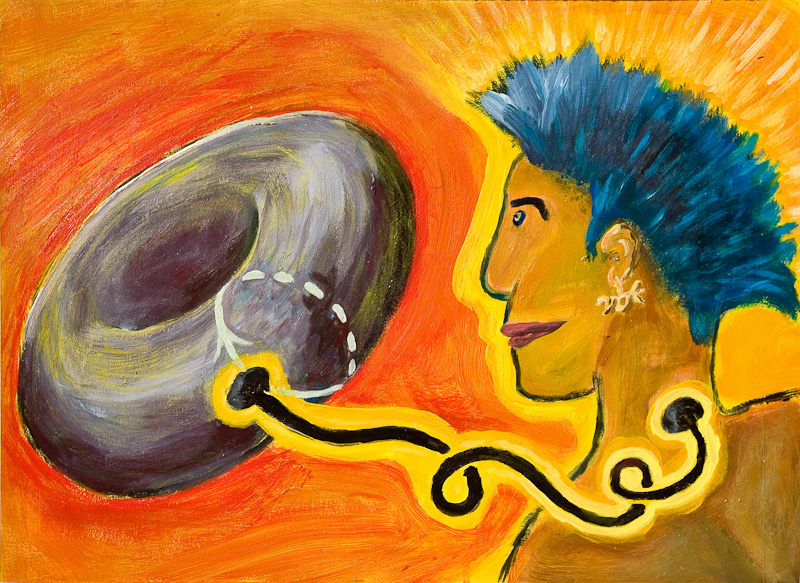
Acrylic on paper, 17" x 13", April, 2008.
In April of 2008, I arranged for a small press, E-Reads, to reprint two of my early science fiction novels, Spacetime Donuts and 35: The Sex Sphere. As part of the deal, they agreed to let me design the covers. Spacetime Donuts is about a somewhat punk-like young mathematician who finds a way to shrink down so small that he wraps around the scale axis and gets big. Scale turns out to be circular, and spacetime is in some sense like a donut. I wrote this novel in 1979, and it can be argued that this was one of the very first cyberpunk science-fiction novels. The characters in the book plug their brains into computers, which is why I have that wire coming out of his neck. He's wearing an earring that's a variation on the W.A.S.T.E. symbol in Thomas Pynchon's novel The Crying of Lot 49. As it turns out, the book's plot resembles this symbol. I had fun making this image really pop with cadmium red and cadmium yellow.
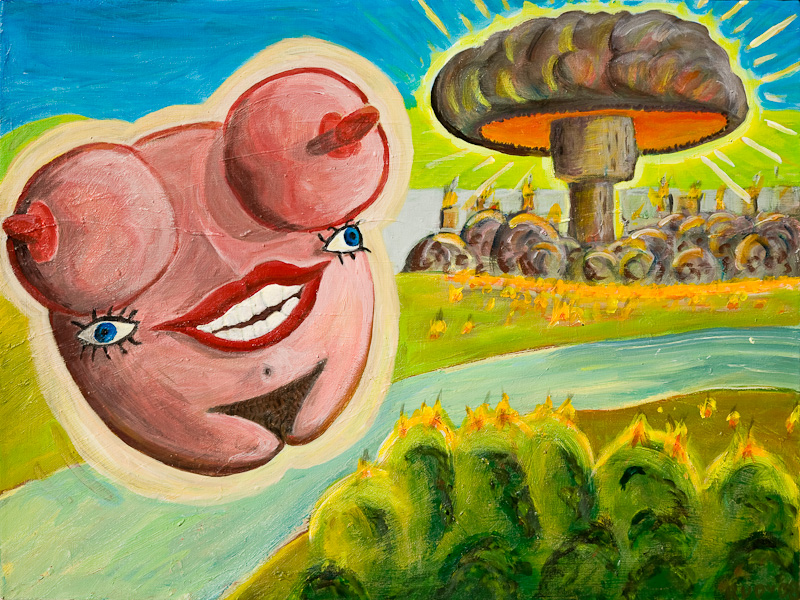
Acrylic on canvas, 14" x 18", April, 2008.
My novel, The Sex Sphere, is about a being from the fourth dimension named Babs. Her intersection with our 3D space looks like parts of a woman, squeezed together and rounded off. She manipulates some of the characters into setting off a terrorist A-bomb in Florence, Italy. You can see the mushroom cloud in the background. I liked painting this, as it's so intense and cartoony and surreal. I think the sex sphere looks a little scary. Originally this painting was going to be a landscape looking out over Silicon Valley. I went up on St. Joseph's Hill with a canvas and paints and started the picture there with Vernon Head. Vernon knows my working habits by now, and he knew something weird was going to show up in the foreground. For awhile I wasn't sure what it should be, but when I realized I needed a cover image for the new edition of The Sex Sphere, I was ready to go.
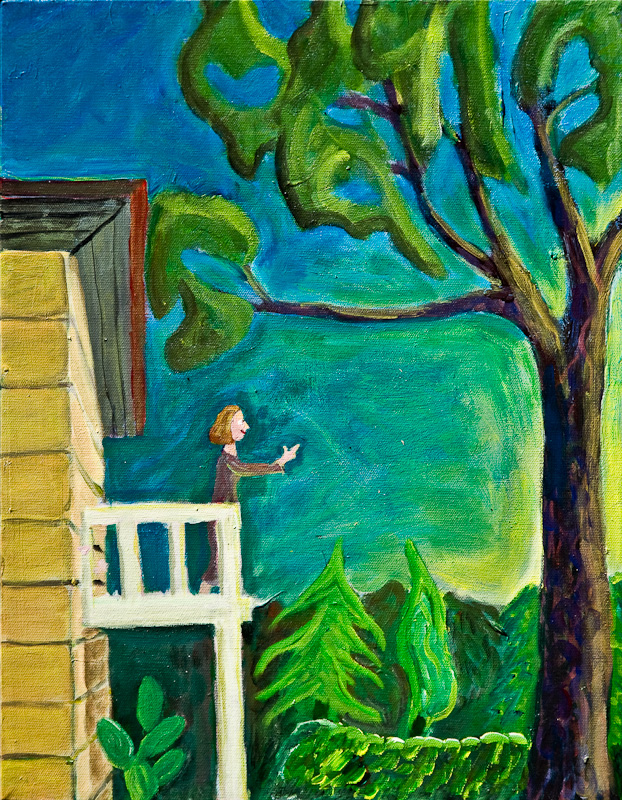
Acrylic on canvas, 14" x 18", May, 2008.
In the morning, the sun comes up behind our house and slants across the yard, coating the trees with warm light. Sylvia calls it "the lamp," as in "Is the lamp on yet?" This is a painting of her standing on the back porch greeting the dawn. I redid the face about twenty times to get the right look, although it still doesn't look like my wife. We're so highly tuned to recognizing faces that the tiniest smidgen of paint changes everything.
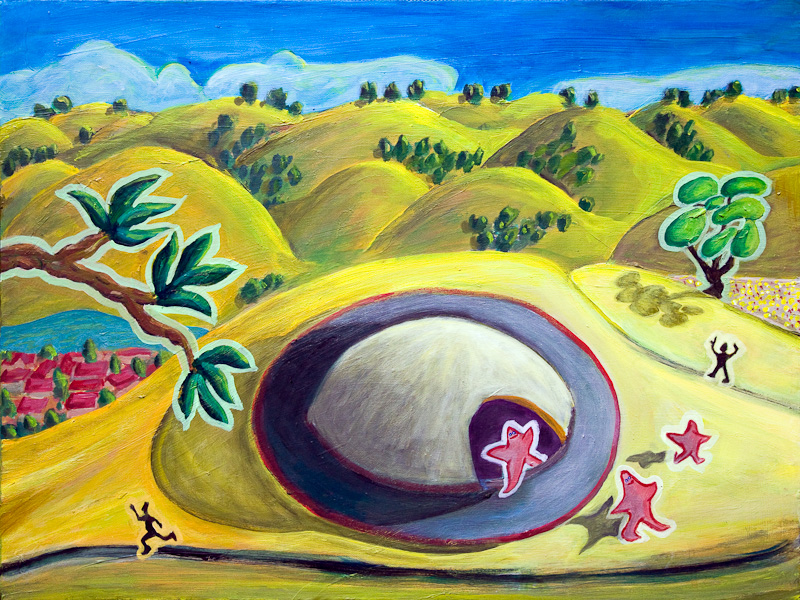
Acrylic on canvas, 24" x 20", May, 2008.
I painted this in Montgomery Hill park in east San Jose, next to Evergreen Valley Community College. The park is named after aviation pioneer John Montgomery who died when his glider, The Evergreen, crashed here in 1911. I added a UFO to liven up the picture, with some star-shaped aliens like in my early painting, 2: Arf and the Saucer.
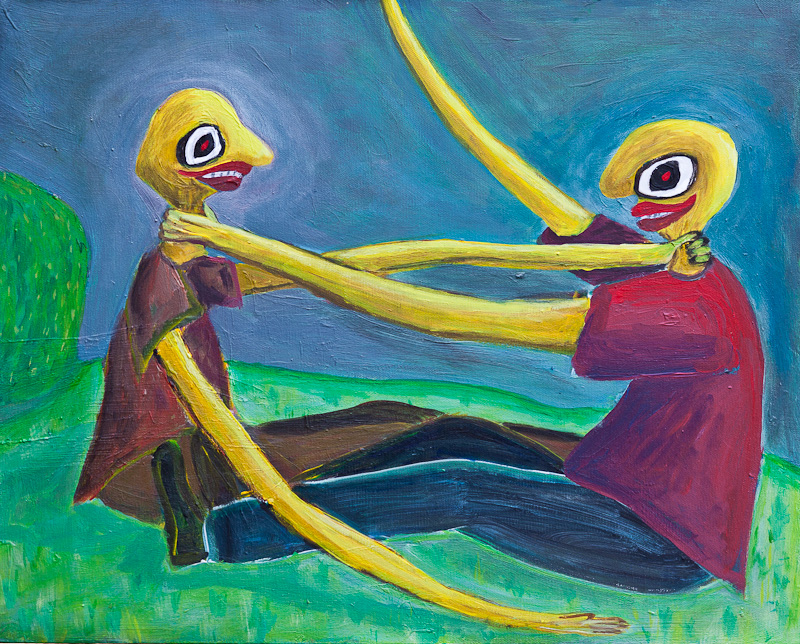
Acrylic on canvas, 20" x 16", July, 2008.
This is an image inspired by collaborating on a science-fiction story with my friend and fellow author, Bruce Sterling. We quarreled a lot about this particular story, called "Colliding Branes," but it turned out well and we sold it to Isaac Asimov's SF Magazine. Thinking back on the experience, I thought it would be funny to paint two long-armed men choking each other. Actually this painting started out as an en plein air portrait of a different friend painting with me on St. Joseph's Hill near Los Gatos, California. But then it diverged into the cartoony mode. I was feeling negative when I painted this picture, as I was recovering from a blood vessel bursting in my brain at the start of July, 2008—see picture 40: Cerebral Hemorrhage.
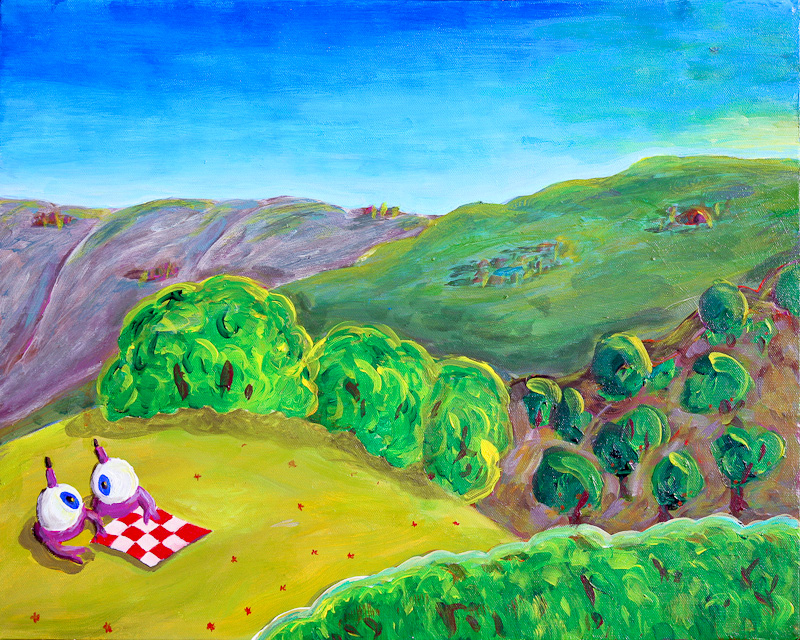
Acrylic on canvas, 20" x 16", August, 2008.
Another en plein air painting on St. Joseph's Hill in Los Gatos, California. My earlier work, 18: Summer Day, was painted at almost the same spot. Here again, once I had the landscape, I wanted to liven it up, so I thought of two cute little eyeball-shaped aliens having a nice picnic together. I sketched in some towns on the hillsides, and used gloss medium to layer on some different colors.
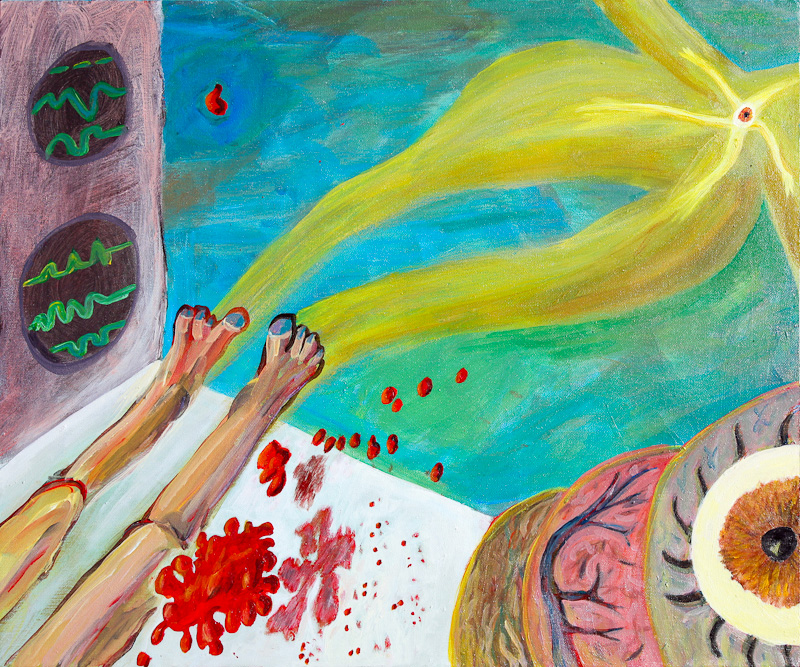
Acrylic on canvas, 24" x 20", August, 2008.
This is a picture of me in the hospital at the start of July, 2008. It's supposed to show how I felt when I nearly died. I like the 3D blob of blood and its shadow on the sheet, also the way the guy's soul is flowing out through the soles of his feet…with the lobes of his brain piled up on the right like a compost heap, with a terrified, watchful eye on top, this eye twinned with the eye of the soul in that starfish shape. Spooky, but somewhat uplifting.
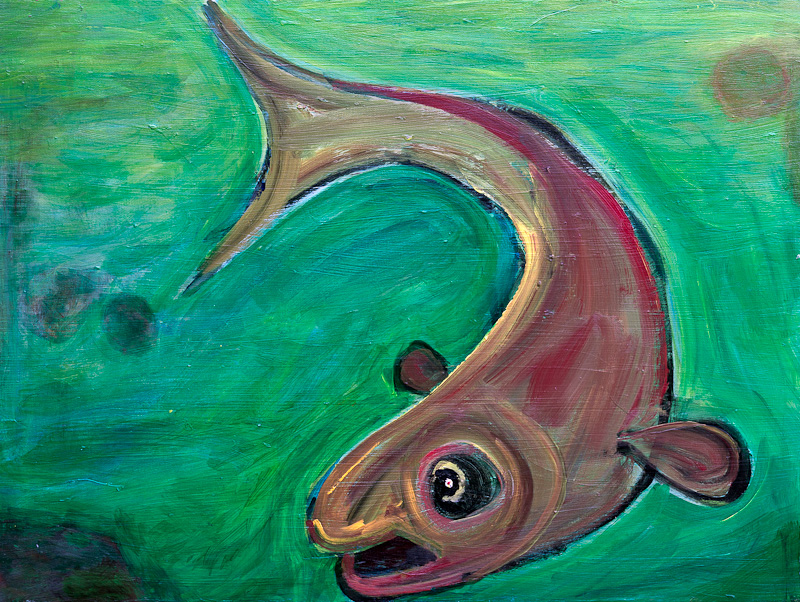
Acrylic on canvas, 24" x 18", September, 2008.
I used to edit a science fiction webzine called Flurb, and my friend Michael Blumlein sent me a kind of magic fish story called "The Big One," and the magic fish got into my head to the point where I painted him. A technical painting issue that interested me here was to get transparency effects, that is, glazes and veils, when you're using the somewhat dead and opaque medium of acrylic paint.
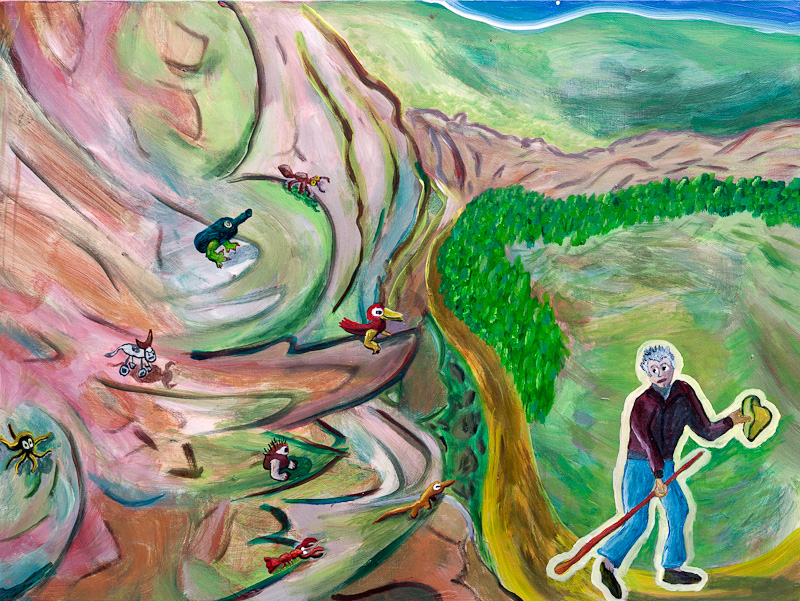
Acrylic on canvas, 24" x 18", September, 2008.
This painting is loosely inspired by Hieronymus Bosch's The Pedlar. I made the background in an abstract-expressionist fashion by simply painting shapes to match the shadows of leaves that happened to lie on my canvas, and then fashioned it into a mountain scene and added the Wanderer. To fill it out, I put some creepy critters into those rocks on the left, perhaps they're memories from the Wanderer's past. For me, The Wanderer represents my own life's journey, with me at a somewhat confusing bend in the road, and the future entirely uncertain. I was still recovering from having a vein burst in my brain at the start of July. I was wondering whether I was near my life's end, or whether I was starting a new phase.
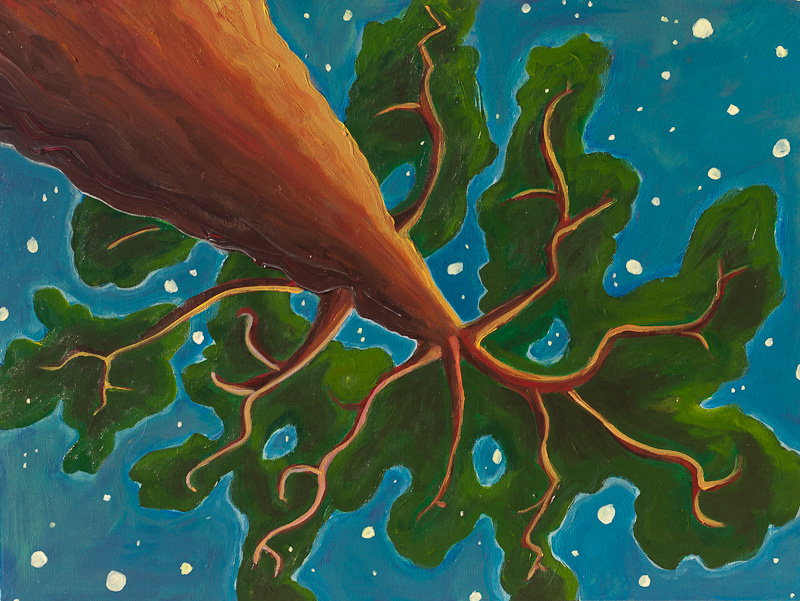
Acrylic on canvas, 24" x 18", September, 2008.
Georgia is my first daughter's name, but this painting is inspired by Georgia O'Keeffe's The Lawrence Tree. She painted her picture around 1929, while visiting the former ranch of author D. H. Lawrence near Taos, New Mexico. Describing that time, O'Keeffe wrote, "There was a long weathered carpenter's bench under the tall tree in front of the little old house that Lawrence had lived in there. I often lay on that bench looking up into the tree…past the trunk and up into the branches. It was particularly fine at night with the stars above the tree." In some books and prints, "The Lawrence Tree" is shown with the trunk at the lower right, but a number of scholars feel that O'Keeffe wanted the trunk to be at the upper left, with the tree disconcertingly growing down, as I've arranged it in my version.
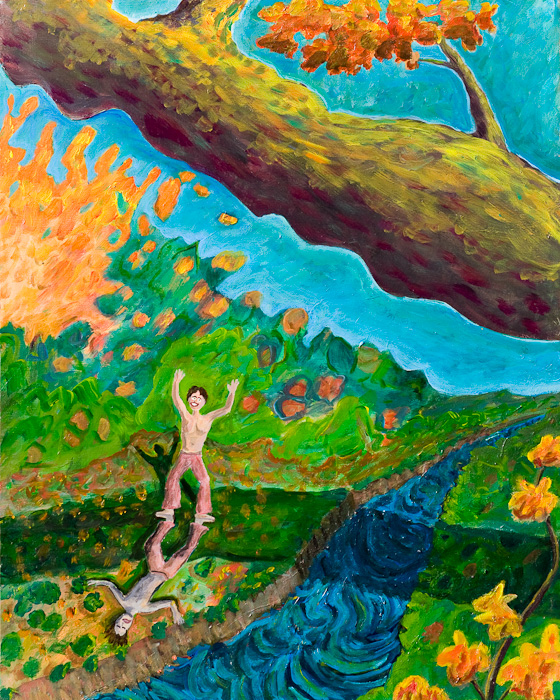
Acrylic on canvas. 24" by 30". October, 2008.
This picture was inspired by Ambrose Bierce's, "An Occurrence at Owl Creek Bridge," a tale about a guy who thinks that he's survived being hung...until auugh, he realizes different. For me, the significance of this relates to my trip to the hospital at the start of July, 2008.. By the time I painted this picture, I'd learned that I'd completely recovered, and that I wasn't going to have another brain-vein pop. But I was thinking that in a different branch of the universe, I died. The picture shows a fork in time, with me, happily, entering the live fork. Note, however, that the season is autumn.
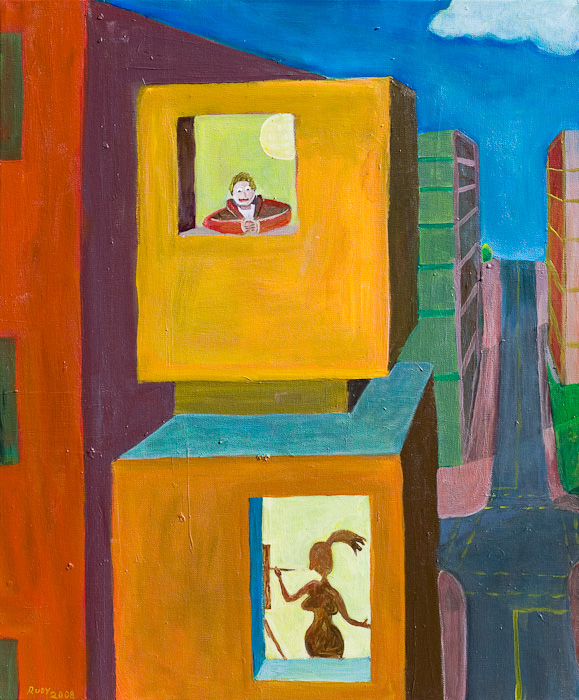
Acrylic on canvas. 20" by 24". October, 2008.
I started this one as a pattern of rectangles. The shapes reminded me of buildings, so that's what I went for. The steep city street is inspired by Wayne Thiebaud. And the idea of Romeo and Juliet appealed to me—my wife and I had just seen a ballet version of it. I like having the woman be in silhouette with a ponytail, and she's painting a picture. Romeo seems somehow to have the moon inside his room with him.
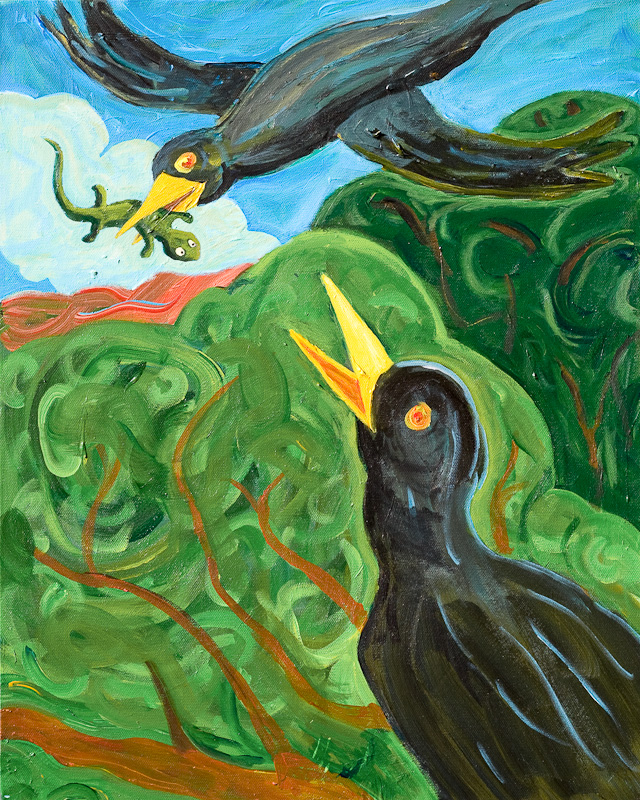
Acrylic on canvas. 16" by 20". November, 2008.
A lot of noisy crows gather in the trees near our house. I love them and their cawing. I think I'd like to be a crow. There's an inhuman, predatory side to birds as well—after all, they're probably descended from dinosaurs. These two are about to share a lizard. I like the anxious look in the poor lizard's eyes. I put a pattern of nested scrolls into the tree foliage.
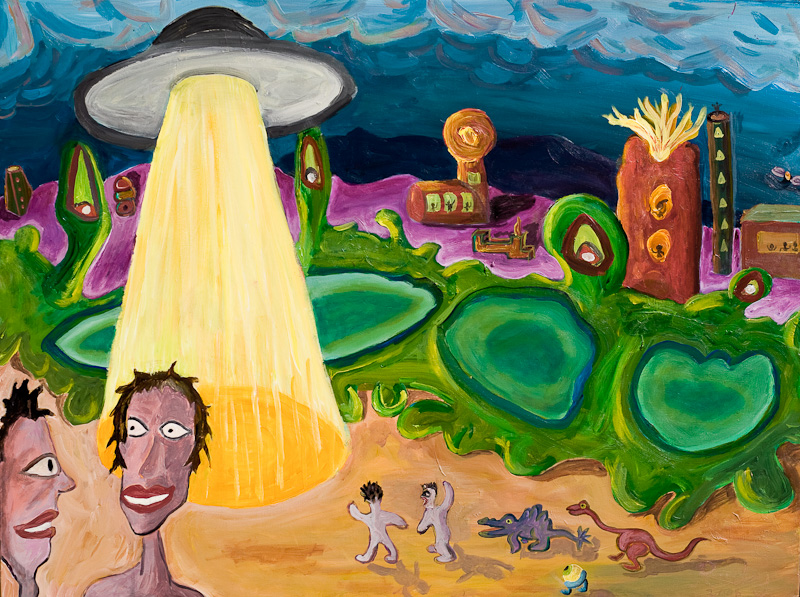
Acrylic on canvas. 40" by 30". December, 2008.
I wanted to do a big science-fictional painting. In the title, I'm using "Mars" in the generic SF sense of "a strange alien planet." I started out with an abstract pattern created by using up the paint remaining on my palette from my previous painting. The first thing I got was a big yellow triangle, which seemed like a beam emanating from a flying saucer. That green band started as a line of foliage, and became a hive creature with multiple eyes and mouths. The very last thing I added was the group of little people and critters watching the saucer land. It represents a new order. I thought of the pair of people in front as newly elected President Obama and his wife at the Inauguration! Welcome to Mars, indeed.
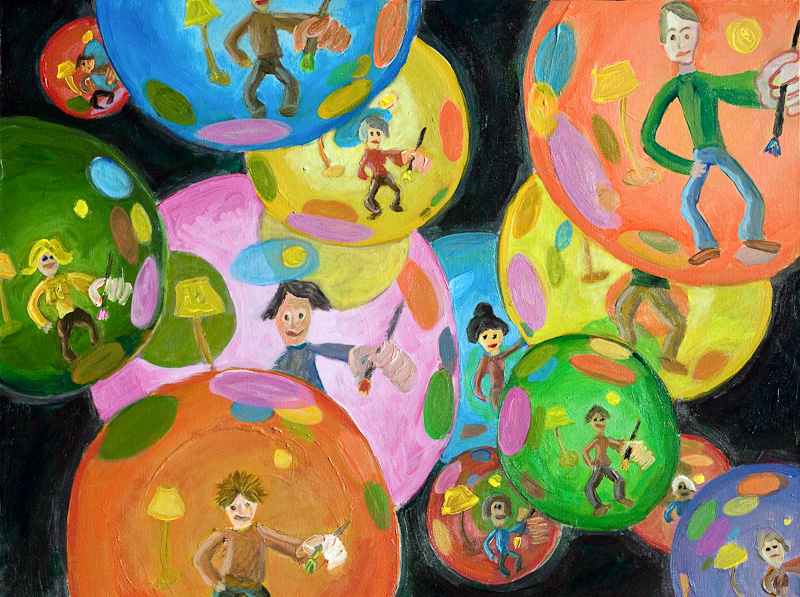
Acrylic on canvas. 24" by 18". January, 2009.
I started this painting before Christmas—we were hanging up some glass ornaments and I was thinking about the reflections in them. I remember reading somewhere that a good exercise for a painter is to practice drawing circles—and then spheres. I didn't actually look at all that many mirror balls to paint this, it's more that I thought about them a lot, although I did keep one reflective ball next to my easel so I could figure out how my hand with the brush would look. It seemed more interesting to have all thirteen artists be different. Cory Doctorow used this image as one of the alternate covers for his collection With a Little Help From My Friends.
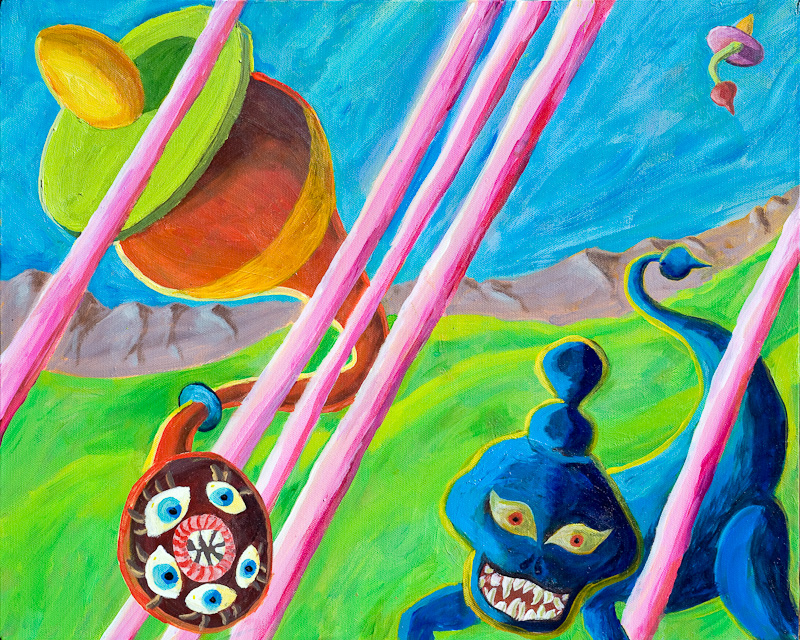
Acrylic on canvas. 20" by 16". February, 2009.
I was working on a novel called Jim and the Flims, about a man who finds a way to get to an afterworld beside our own reality. And this world is inhabited by the so-called "flims." I wanted to see what they looked like. To start with, I took some leftover paint from 48: Thirteen Worlds and painted a landscape in the shape of some shadows that were falling on my canvas. The straight lines are shadows of telephone wires; they indicate this is a portal zone. I call the menacing beast at the lower right a "yuel." When I was in Louisville in January, 2009, I'd imagined seeing something like this in the woods, with a Tibetan demon look. The other two beings are modeled on what the cartoonist Jim Woodring calls "jivas." Jivas appear, for instance, in his book The Portable Frank. For him they're a bit like free-floating souls, or paintbrushes. They're villains in my novel.
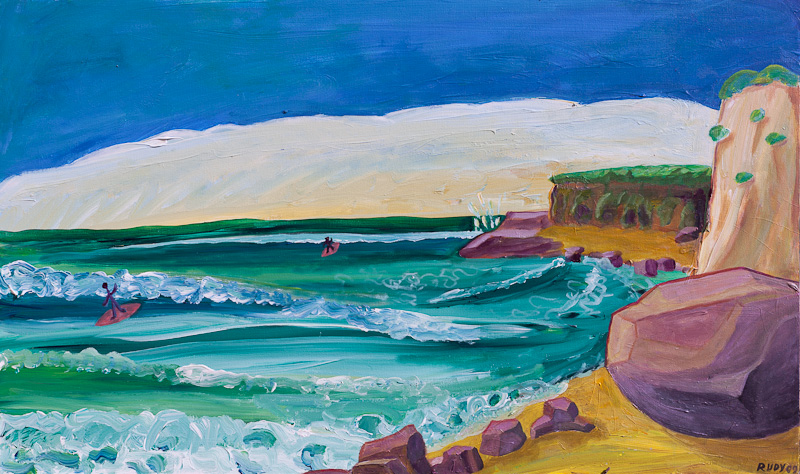
Acrylic on canvas. 30" by 24". February, 2009.
I was out at Four Mile Beach on Route 1 north of Santa Cruz. I brought a big canvas there and my paint kit for an en plein air session.. The only other people around were surfers; they thought it was nice that I was painting them. This was a clear day before a big storm moved in. The waves came out well—I did that part in under an hour, right there on the beach. I reworked the cliffs and rocks at home. I like this picture a lot. Sometimes the easy ones are the best.
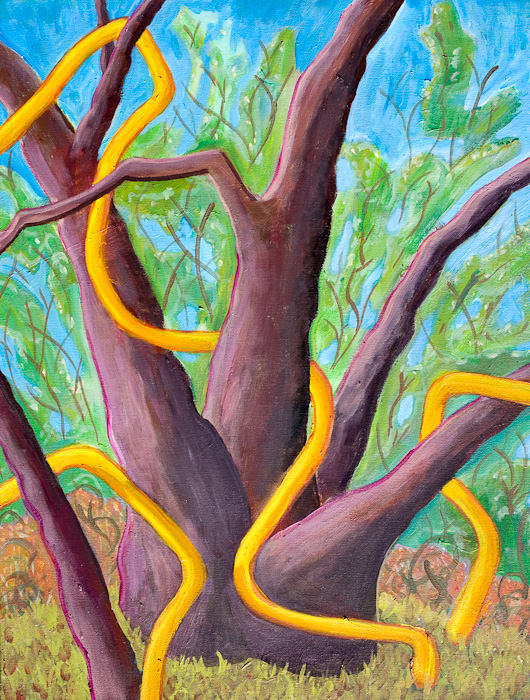
Acrylic on canvas. 18" by 24". March, 2009.
I took a picture of this spot a month earlier, when it was raining a lot, and I was struck by the contrast between the snaky pale vine and the damp bark of the branching tree. And I loved the 3D curve of the vine. I went back a week or ten days later, and it wasn't so rainy anymore, so the contrast wasn't so high. I had my paint kit with me and I started this picture on the spot. I noticed two more vines I could put in the picture. The picture seems symbolic of something---but I'm not sure of what.
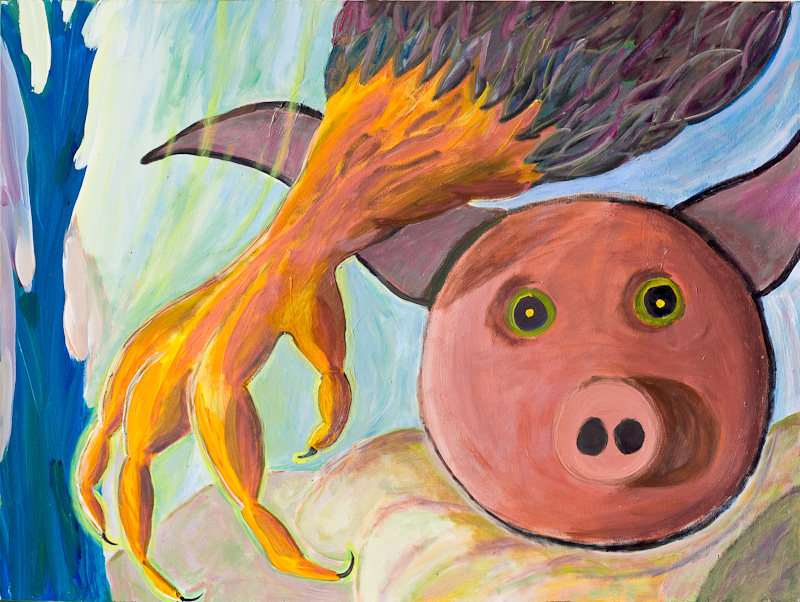
Acrylic on canvas. 40 " by 30 ". March, 2009.
I had a big canvas and I wanted to do something flashy. I started out with random blotches of paints, and then I started seeing some images. At first I had the picture rotated 180 degrees from this, and the claw was fire, and the red disk was a setting sun. But that looked dull. So I turned it the other way, made the claw…and added a pig snout and ears. Pig Surprise! Another reason for the title is that I went to Big Sur a week before painting this, and my daughter Isabel was teasing me, and said I was going to Pig Sur. Yet another interpretation might be that I was working on my income tax return while painting this—a docile citizen facing the Eagle.
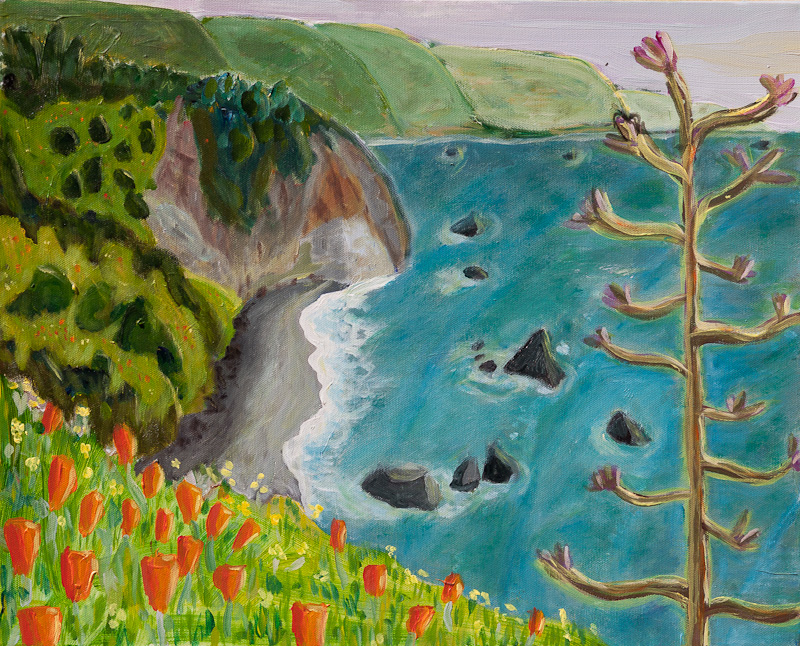
Acrylic on canvas. 20" by 16". April, 2009.
I started this on my birthday at a rustic old motel, Lucia Lodge in Big Sur, about 30 miles south of the hamlet of Big Sur proper. I was perched in a meadow of poppies at the edge of a cliff, just like the painting shows. That's a century plant on the right, a fitting thing to paint on one's birthday.
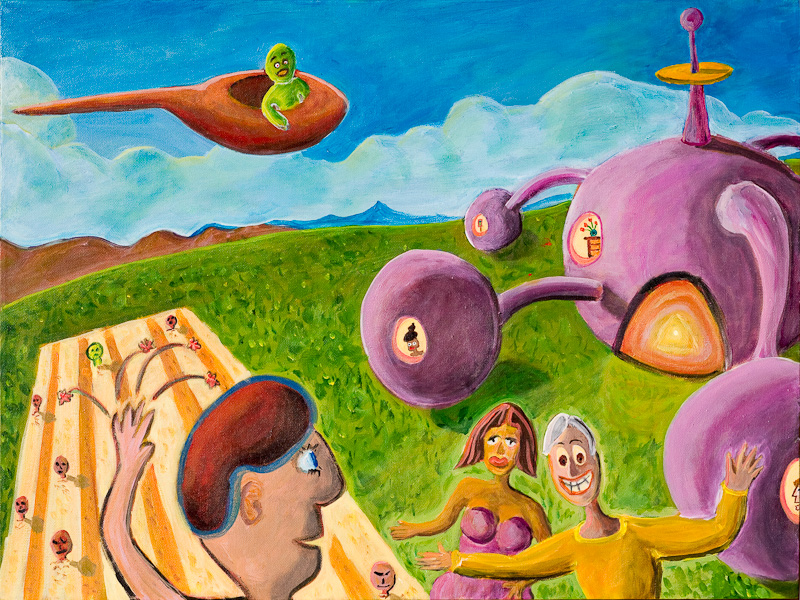
Acrylic on canvas. 24" by 18". April, 2009.
In working on my novel, Jim and the Flims, I wanted to get an image of another world called Flimsy. And this was the picture I came up with. My original inspiration was van Gogh's painting, The Sower—I started with a man sowing seeds into a field. Two people are greeting him, they just came out of that interdimensional tunnel visible in the house-like structure made of lavender spheres. The kicker is that the sower is casting baby-seeds into the field, and we see human heads growing up—and the head of one green alien.
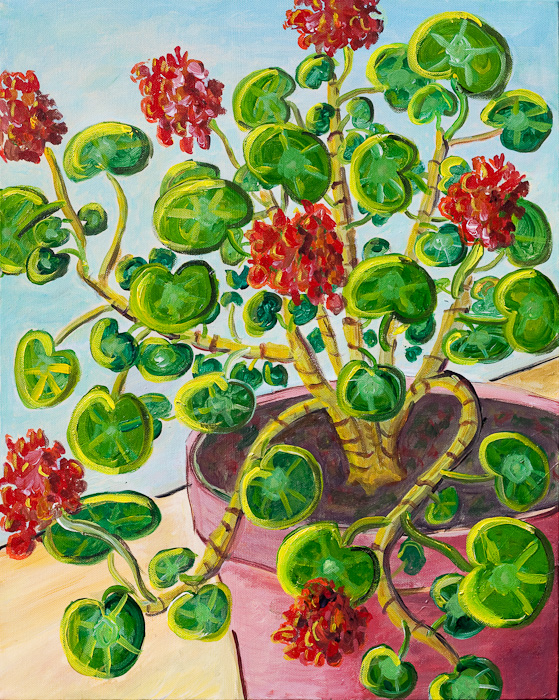
Acrylic on canvas. 16" by 20". April, 2009.
I wanted to paint a still-life for a change, and I ended up combining aspects of two potted geraniums in my back yard. At some point, I always have to stop looking at the object and start making things up, otherwise I'd never finish. With this geranium I did have something extra in mind, that is, I was working on a kind of urban fantasy/SF novel called Jim and the Flims, and my characters were about to make their way to the castle of the King of Flimsy. And I had the idea that the castle could look like a giant geranium. Those leaves are thick, you see, with rooms in them, and the flims are buzzing around them like gnats, only too small to see in the painting—but in 57: The Abduction I came back to paint the details.
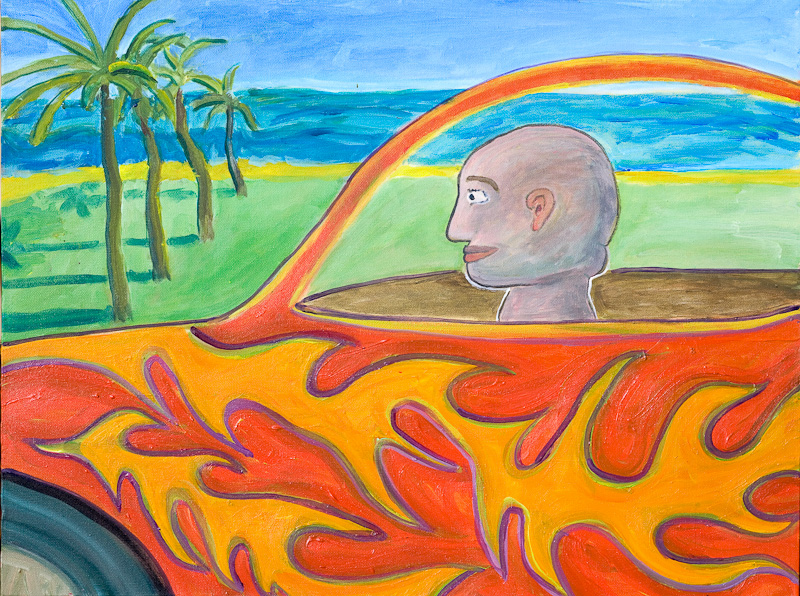
Acrylic on canvas. 24" by 18". May, 2009.
I've been fascinated by cars with flames ever since I was a kid poring over my big brother's hot rod magazines. In 1973 I had a fairly generic white Ford that I painted some flames on myself. It was an amateur job—but it was fun. I happened to go to a car show in Southern California in May, 2009, and I got the idea to paint one. It's hard to pin down the mood of the guy in the car. A little sad and lonely, but calm. In a loose sense, the guy represents me—he has flashy flames on the outside, but inside, he's on his own, as we always are.
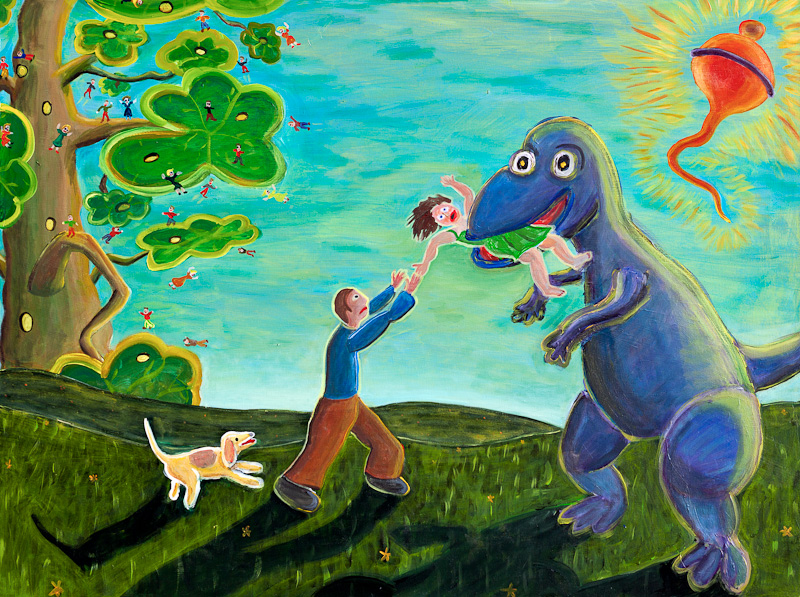
Acrylic on canvas. 40" by 30". June, 2009.
I painted this scene to help visualize a chapter in my novel, Jim and the Flims. In the background we have a giant geranium plant that's being used as a castle by a race of flying people. In the foreground, a man's girlfriend is being abducted by an alien who's taken on the shape of a dinosaur. The sun is a glowing alien being known as a "jiva" and shaped like a beet. On the left is my old dog, Arf. Of course?
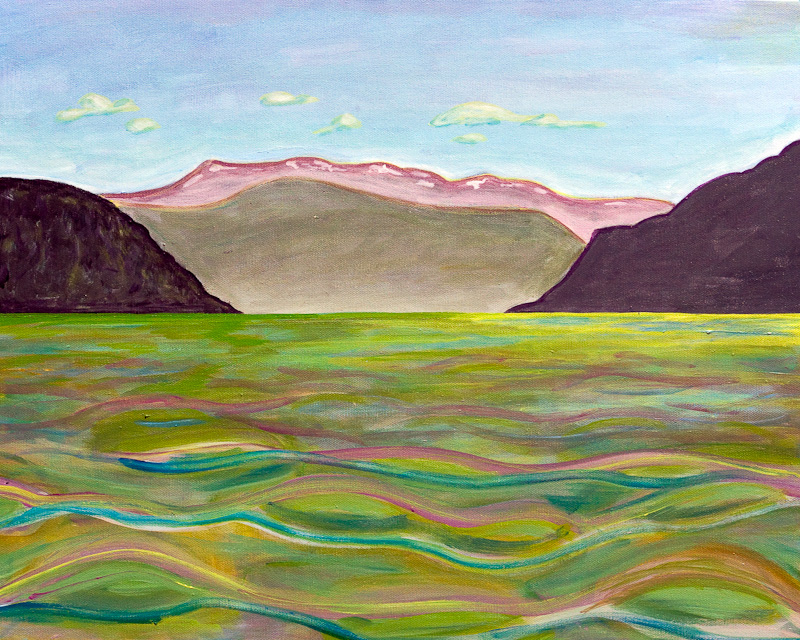
Acrylic on canvas. 20" by 16". July, 2009.
On a trip to Norway, I was struck by views of the fjord, as seen from Balestrand, a town where painters used to gather. I like the theatrical way that the mountains on either side of the fjord frame the view.\\
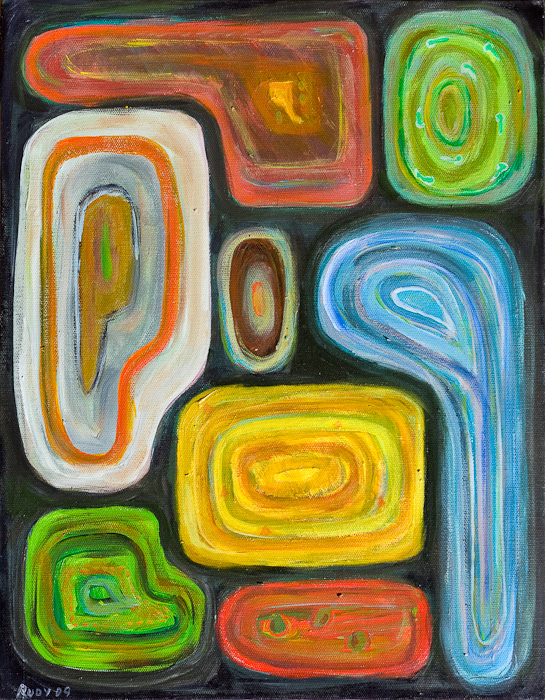
Acrylic on canvas. 14" by 18". July, 2009.
In fairy tales and science fiction stories, people often encounter magic doors to other worlds. Here I started with a kind of grid that's based on the reflection patterns in water. And then I filled in a lot of little "doors," arranging them so that the whole pattern makes a door in itself.
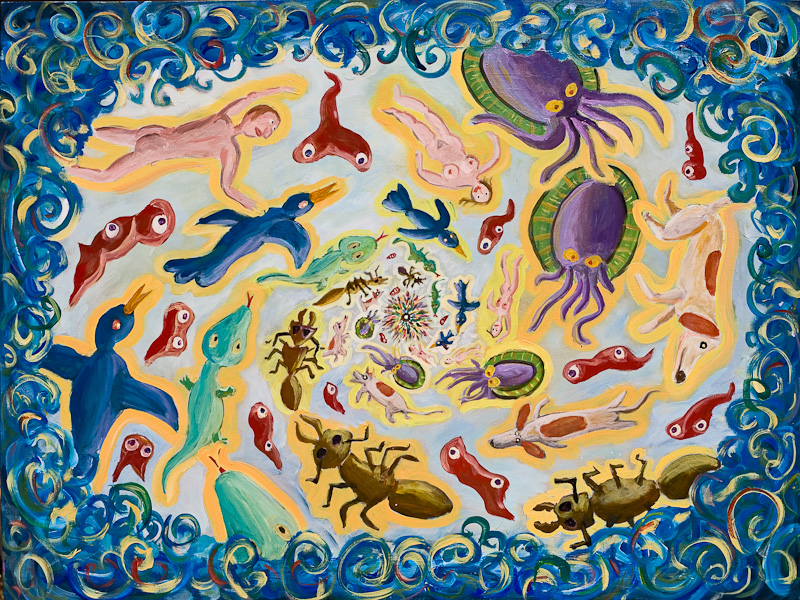
Acrylic on canvas. 40" by 30". August, 2009.
This picture has to do with my mental image of Flimsy, an afterworld that I describe in my novel Jim and the Flims. I wanted to fit an endless world into a finite volume—that Flimsy (the afterworld) is inside each electron. I turned to M. C. Escher's engraving, Smaller and Smaller I, as an example of how to fit infinity into a nutshell. He has things shrink as they approach the middle. I started with six streams of beings: humans, cuttlefish, dogs, ants, lizards, and birds. And then I filled in the blanks with globby beings designed to fit the extra spaces.
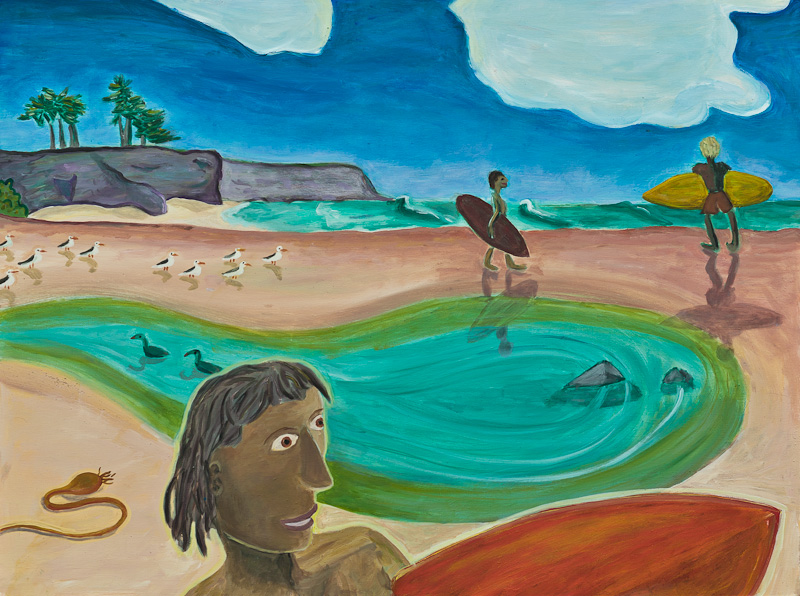
Acrylic on canvas. 40" by 30". October, 2009.
I trekked down to Four Mile Beach north of Santa Cruz with Vernon and started this one en plein air, getting the composition, and finding some of the colors. Some of the surfers at Four Mile noticed me working on this canvas—and they approved. The “surf pilgrim” in the foreground looks determined. At home, I dialed up the colors to match my memories, which tend to be brighter than reality. It was a big canvas to carry to the beach. A certain amount of blowing sand got stuck to the paint, which is nice, as it adds physical texture and a you-are-there quality. My mother was a painter, and she liked to do this, too.
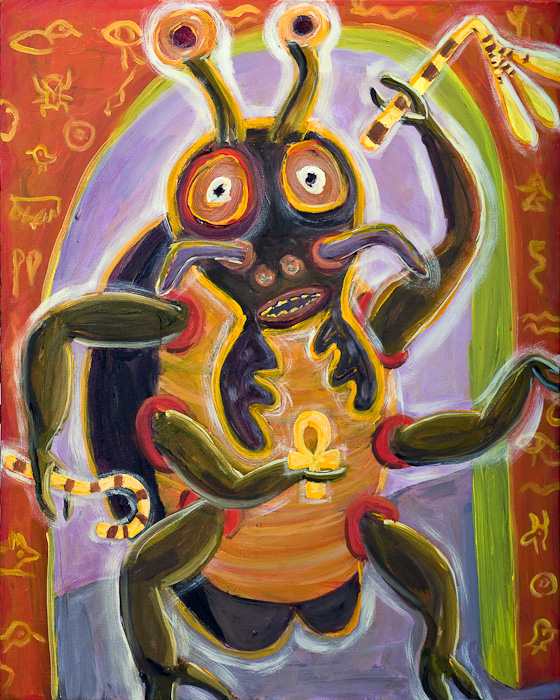
Acrylic on canvas. 16" by 20". February, 2010.
When I painted this, I was nearing the final stages of my novel Jim and the Flims. In my story, the characters have stolen the ancient gold sarcophagus of the pharaoh Amenhotep. And Amenhotep's ghost has emerged from the casket in the form of a menacing, unhappy scarab beetle holding an ankh, a crook, and a flail. In my designs of the hieroglyphs on the walls, I was influenced by my daughter Isabel's graphic novel, Unfurling.
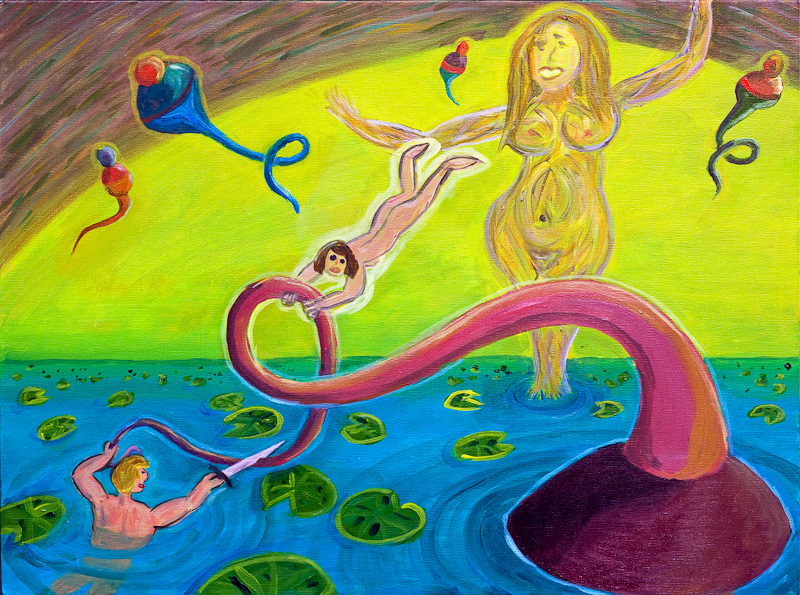
Acrylic on canvas. 24" by 18". February, 2010.
I considered calling this painting Unknown Legend, as it's not very obvious what the story is here. I painted this is a previsualization of the second-to-last chapter of my novel Jim and the Flims, just before writing the chapter. Those flying beet thingies are called "jivas." As I mentioned in my comment on picture 46: The Flims, I got that word from the artist and cartoonist Jim Woodring. The tall figure in back is the goddess of Flimsy, she's made of mist. And in front, that's my hero Jim and his wife Val. I was surprised to see that jiva not putting up more of a fight in my picture, and this affected the way that I wrote the chapter.
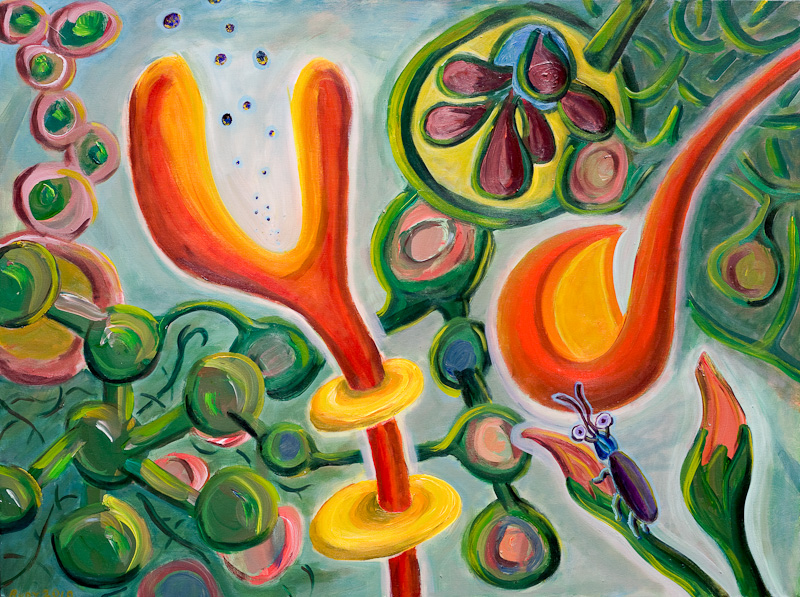
Acrylic on canvas. 40" by 30". March, 2010.
I think this picture might be the dream of the somewhat ordinary flower at the lower right corner, or maybe it's the dream of the bug. The picture arose fairly spontaneously. The first thing that went in were those two big red shapes, the fork and the hook. I combined the paint left over from my previous picture, 63: At the Core of the World, and filled in the background. And then I kept on adding stuff to make it jungly.
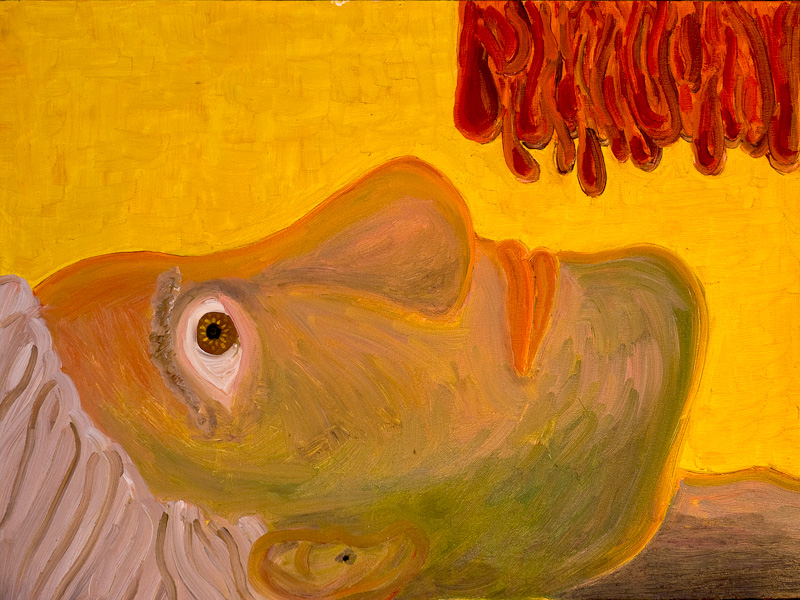
Oil on Canvas. 24" by 18". March, 2010.
I was having some pains in my chest, and I went in for a series of heart exams. Ultimately I had a relatively minor procedure done—some stents. At the start of the process, I was very anxious, and I painted a picture of myself lying on an examining table—with a curtain of blood overhead. I had been wanting to return to painting with oil instead of acrylic paints, and I made the switch with Heart Exam. Looking through my old tubes of oil paint, I found an oddball tube of metallic gold paint. I used that whole tube on this painting, covering the canvas with an underlayer of gold paint, and leaving the gold exposed for the empty part of the background. It gives the picture a nice icon-like quality.
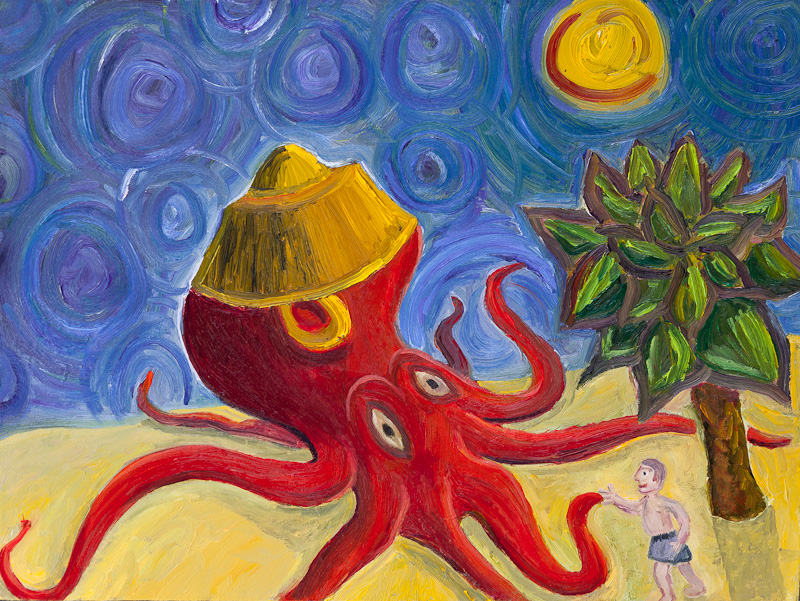
Oil on canvas. 24" by 18". March, 2010.
This particular picture emerged almost at random, I was simply fooling around with shapes and colors until I found something that I liked: a giant octopus in a silly hat that might be a washtub or a lampshade. At this time I was still waiting to have that procedure done on my heart. After I'd been working on this picture for a couple of days, I suddenly realized that the red octopus was in fact a symbol of my heart with its arteries. My subconscious thoughts become manifest when I'm painting! Somehow doing this painting made me less anxious, and in the end, getting my heart fixed wasn't a big deal. In this painting and in picture 65: Heart Exam, I was using an alla prima technique—this is the practice of finishing a picture while it's still wet, as opposed to letting it dry and then applying successive layers. With oils, the paint stays quite wet for two or three days, so you can stretch out an alla prima session.
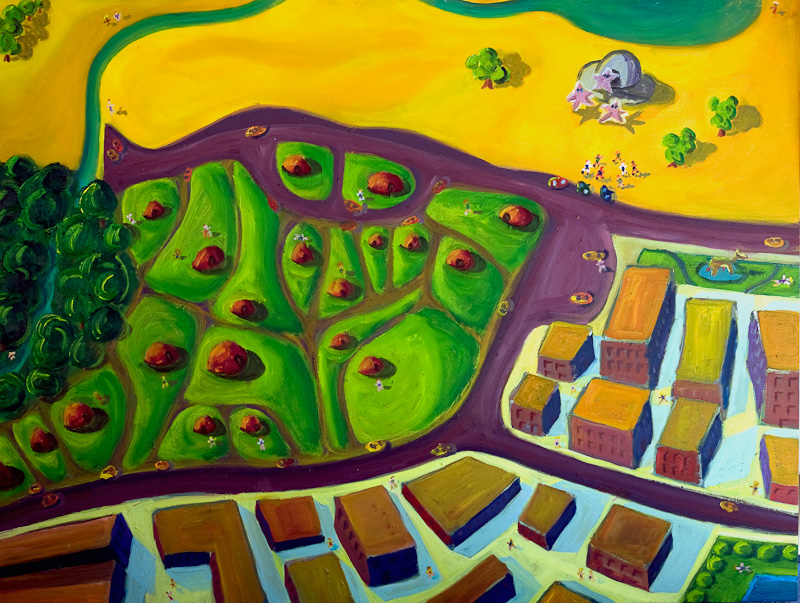
Oil on canvas. 40" by 30". April, 2010.
When I first started this painting, I was thinking about Aboriginal art that paintings I'd seen in Australia, paintings in which the artists would depict their home area in fairly abstract terms. But then, after I started, I went to a show of Wayne Thiebaud's paintings, and got drawn into his style of making colorful landscapes that border between being realistic and abstract. When I was almost done with my painting, I felt that it still looked a little empty, so I added a UFO with starfish aliens in the same style that I'd used before in 2: Arf and the Saucer and in 37: Montgomery Hill. Maybe the UFO is a little too large for the perspective; the hope is that the viewer will understand that the aliens are of a giant size.
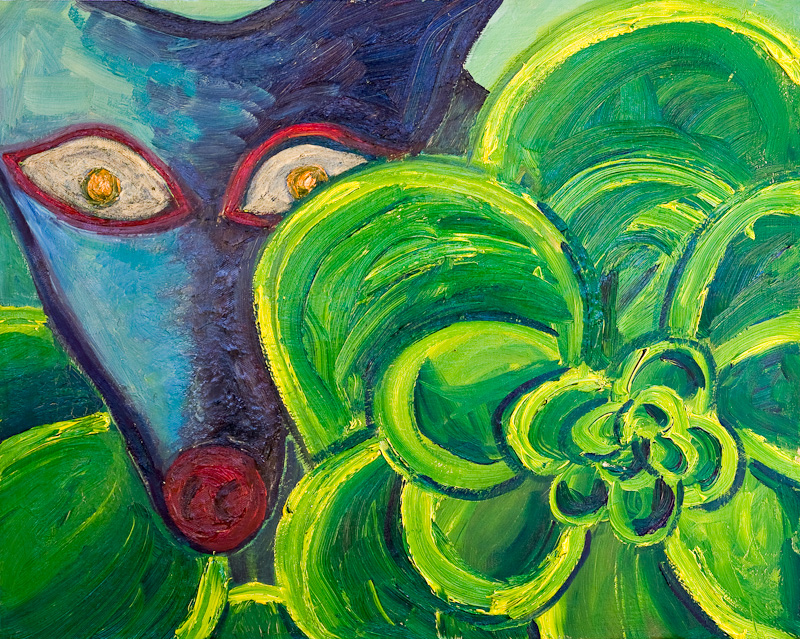
Oil on canvas. 20" by 16". April, 2010.
This was a fairly quick painting. I started by painting a "hen and chicks" cactus that was growing in our garden. And then, to liven it up, I put a wolf-like figure in the background. To give his eyes more impact, I glazed on a thin coat of metallic gold paint.
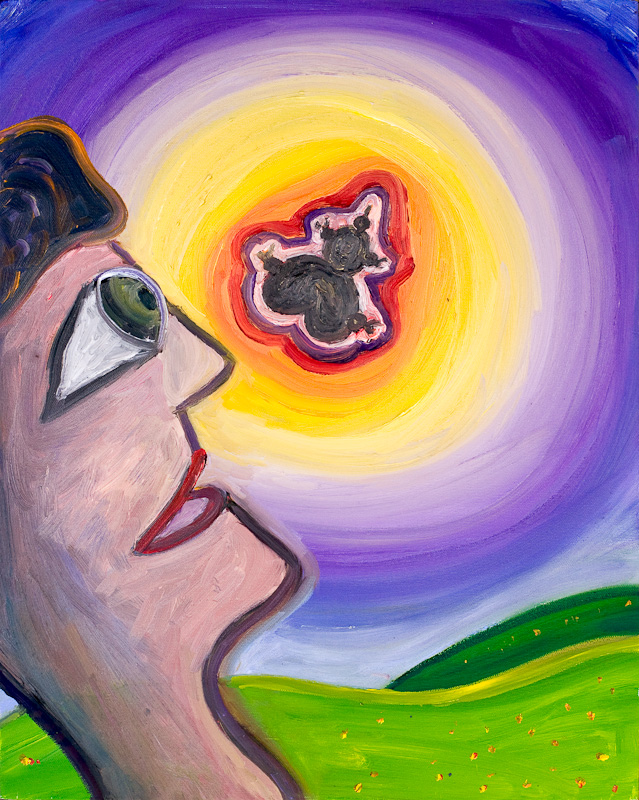
Oil on canvas. 16" by 20". May, 2010.
This is an image of a guy seeing a vintage fractal in the sky, an object known as the Mandelbrot set. When I painted this, I'd just come back to fractals after a twenty-year hiatus, and I was creating extremely gnarly images. I was thinking about fractals all the time, seeing them in my dreams, and seeing them when I closed my eyes. I made videos, art prints, T-shirts, and a blog post at tinyurl.com/rudyfractals. At the same time I was thinking about a made-up word of mine, fnoor, which first appeared in my novel, The Hacker and the Ants. Fnoor is meant to be an old-time graphics-hacker term for incredible weirdness on your screen, a kind of image that the early programmer Bill Gosper used to term "seething dog barf." I was writing a science fiction story with the working title, "Fnoor," in which the characters see some fnoor-like aspect of the natural world that suggests that (a) the world is a type of computation and (b) they can learn how to tweak this computation to improve their lot.
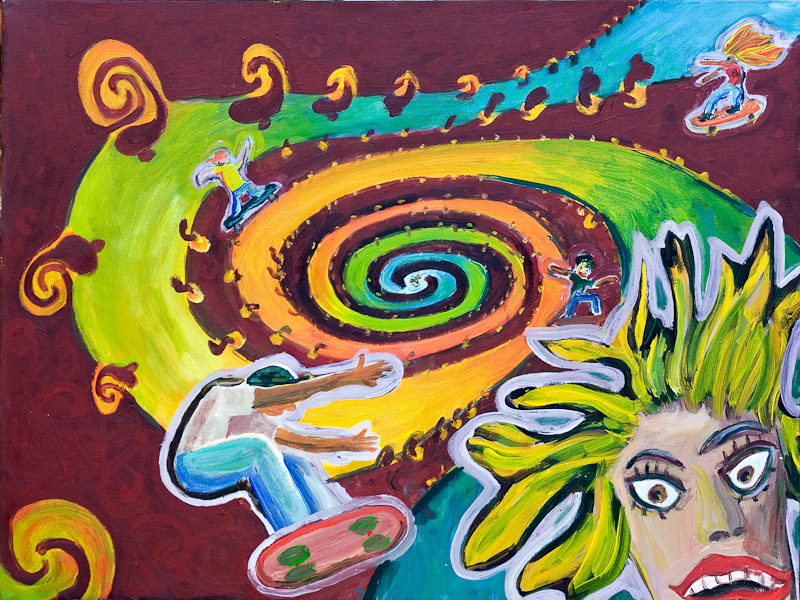
Acrylic on canvas. 24" by 18". May, 2010.
As I mentioned in the note on 69: He Sees the Fnoor, I was working with higher-order fractals during this time period, and I found a really nice double spiral that came from a cubic Mandelbrot set. I saved off a high-res image of it, and started selling the image online as a print and as a skater T-shirt with the caption "Seek the Gnarl." And then I decided to do a painting of this fractal, quixotic effort though it is to paint an infinitely complex object. Once the painting of the fractal was done to my satisfaction, the image needed pepping up, so I put in five thrill-crazed skaters.
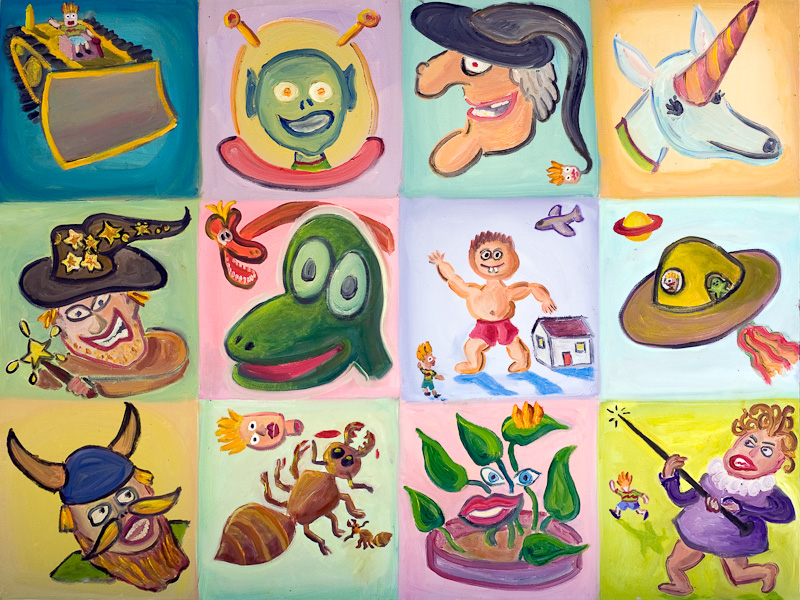
Oil on canvas. 40" by 30". June, 2010.
My friend Terry Bisson talked me into making illustrations for an illustrated version of his collection of off-kilter stories, Billy's Book. There were thirteen stories in the book, and to speed things up, I divided a large canvas into twelve squares, and did a Billy picture in each square. (The thirteenth picture is a detail of my Fractal Skate Posse painting.) Billy has yellow hair and a green shirt, and traces of him can be found in each picture.
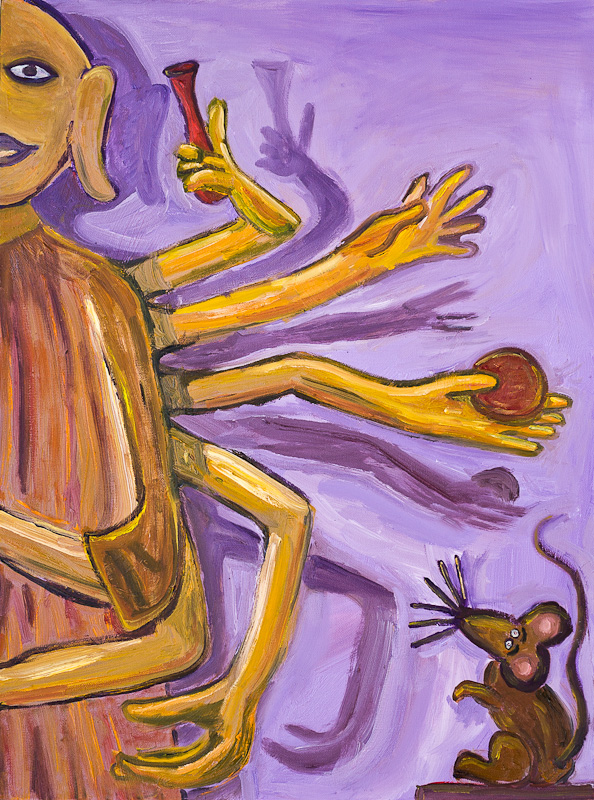
Oil on canvas. 18" by 24". July, 2010.
I took a photograph of an interesting statue of a twelve-armed Buddha in a small Asian art museum in Pasadena, California. The somewhat sinister pattern of the arms and shadows interested me. So when I got home, I painted the image, and I added a mouse to give the picture a bit of a narrative quality, that is, a story-telling flavor.
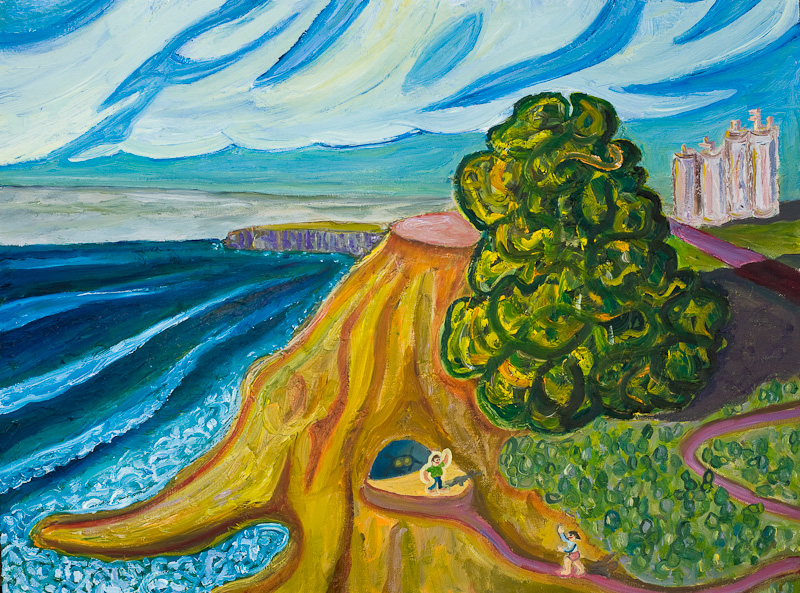
Oil on canvas. 24" by 18". July, 2010.
This one started as an en plein air painting atop a cliff in Davenport, California. I was there with Sylvia and Vernon. It was a windy day, so I didn't work on the picture for very long at the site. I was struck by a little sea cave in the side of the cliff and by the towers of a shut-down cement plant to the right. Back home I worked on the painting for another week, adding a man, a woman, and a shadowy crab-like shape inside the cave. I like that the cliff shape looks a little like the head of an elephant.
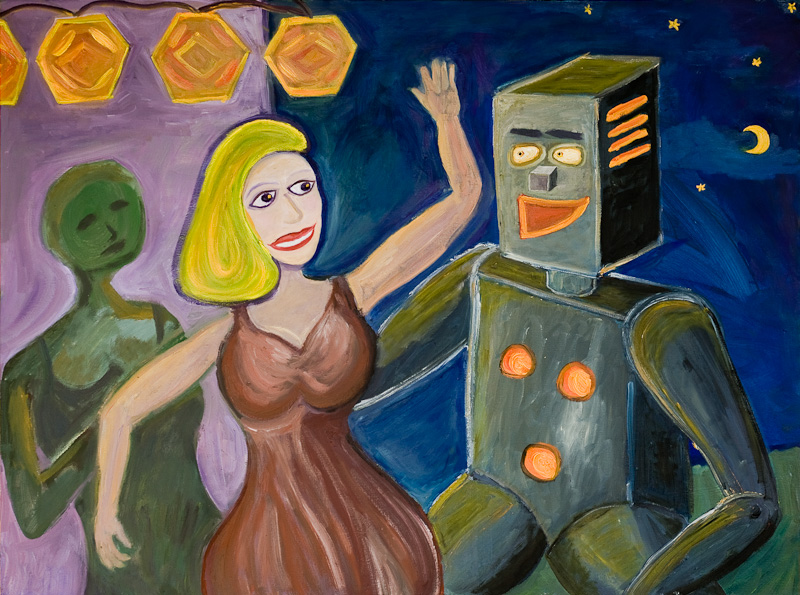
Oil on canvas. 40" by 30". August, 2010.
I was going for a kind of French Impressionist look with this one, thinking of a garden party. Another inspiration was that I'd recently seen the Mel Brooks theater production of Young Frankenstein. But I went for a robot or mechanical man rather than a Frankenstein's monster. I like how he's glowing from the inside. In a way, this painting is an image of Sylvia and me, on a car-trip we took to the French Riviera in 1966, the year before we were married.
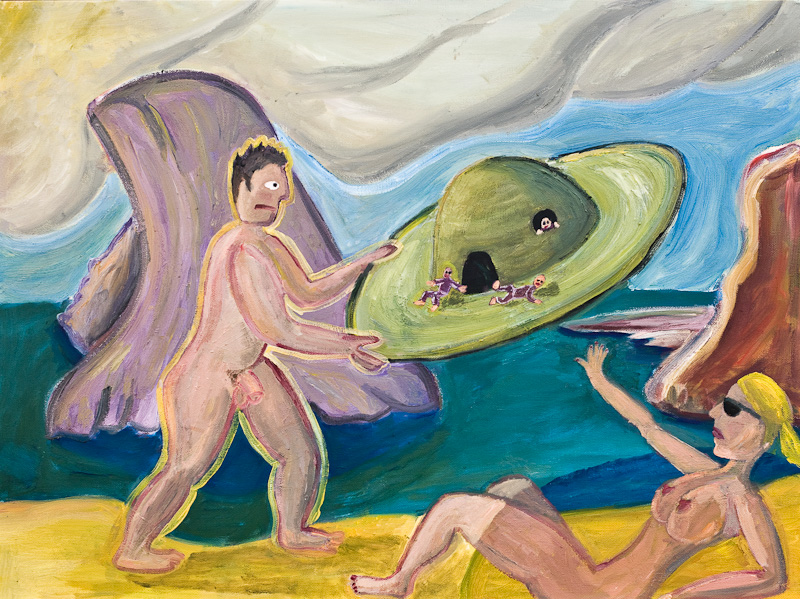
Oil on canvas. 24" by 18". August, 2010.
I started this one during an en plein air painting session on a pocket beach near Davenport with Vernon Head. I had the rocks and the water, and I added the UFO, modeling its shape on the lid of my water bottle. And at home I put in the two nudes, to liven things up. The scale of the flying saucer didn't look quite right, and it was unclear how far away it was, so I had the guy take hold of it, thereby shrinking it and bringing it into the foreground. I have it casting a shadow like a beach umbrella onto the California woman to further anchor its position. And finally I had the idea that the guy is shaking the UFO, and two of the little aliens inside are falling out.
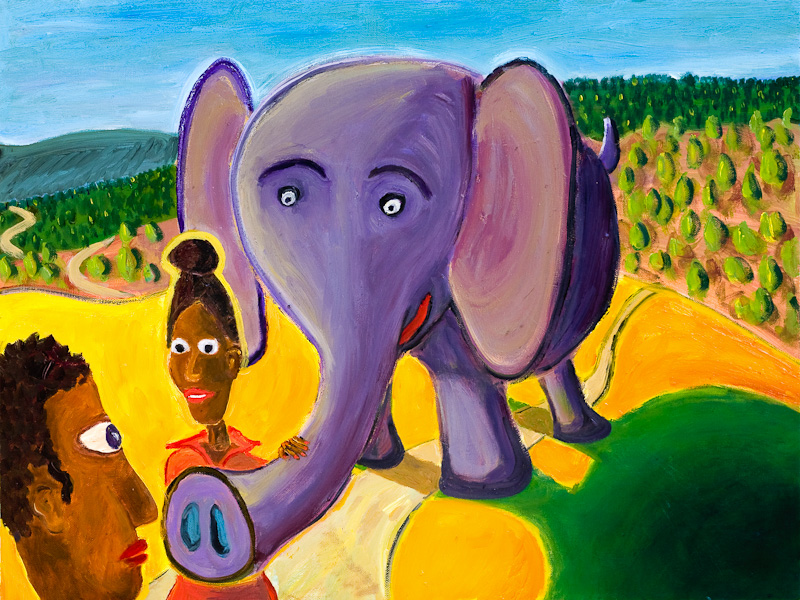
Oil on canvas. 24" by 18". September, 2010.
This picture began as a landscape painting in a hot, dusty park near Cupertino, California. In the park, I was thinking about Hannibal crossing the Alps with his elephants, but I didn't actually put in the elephant until I got back home. The landscape seemed like it needed something big to pep it up. And, as I added layer after later to the picture, I came up with a somewhat mysterious encounter between a woman leading the elephant, and a man she meets. The title is a bit of a joke, as in, "I met a nice woman, but she has a pet." I was also thinking of someone who carries a lot of personal baggage. But ultimately, I'm getting at something more general, mythic, and imprecise. An encounter.
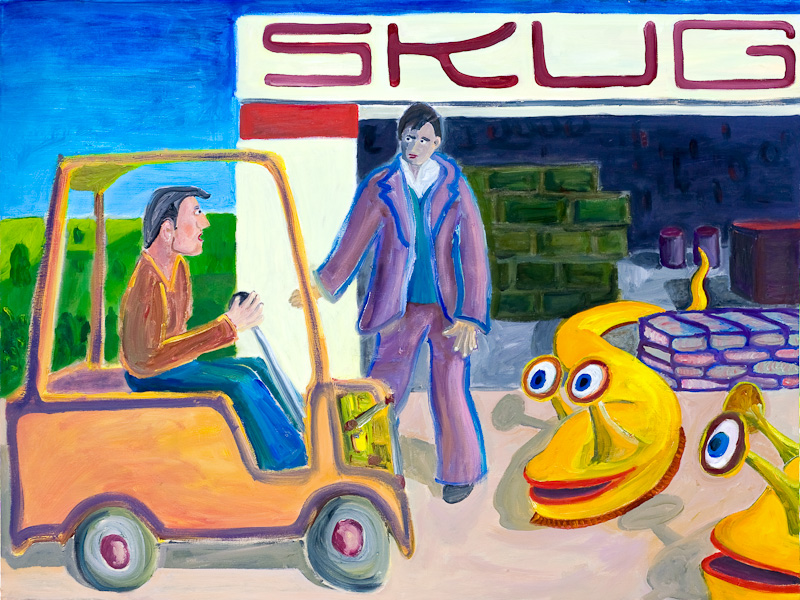
Oil on canvas. 40" by 30". October, 2010.
I made this painting while gearing up for a novel involving the computer pioneer Alan Turing, the beatniks, and some shape-shifting beings called skugs. I got the word "skug" from my non-identical twin granddaughters, aged three. When I visited my son's house in Berkeley, I always liked to open up his worm farm and study the action with the twins. We found a lot of slugs in there, and we marveled at them. The girls tended to say "skug" rather than "slug," and I decided I liked the sound of this word so much that I'd use it for some odd beings in my novel. I was supposing that Turing would carry out some biochemical experiments leading to the creation of the skugs. Here we see Turing outside the Los Gatos Rural Supply Hardware garage, with two skugs backing him up. Alan is meeting a handsome man who may well become his lover. Unless the skugs eat the guy.
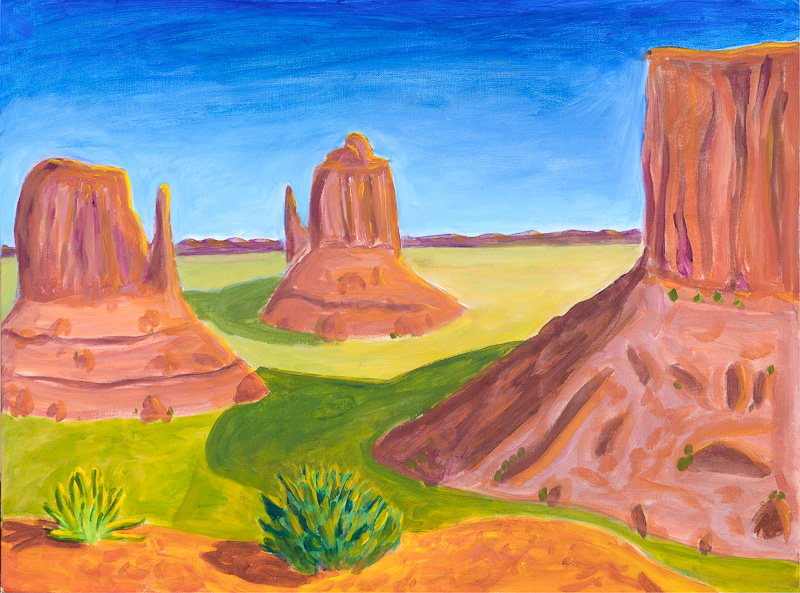
Acrylic on canvas. 24" by 18". January, 2011.
I started this en plein air at Monument Valley in September, 2010, and finished it at home a few months later. Those rock formations on the left are called the Mittens. This is an amazing place, with a strong spiritual vibe. The day after I painted this, I got up before dawn and hiked down into the valley, around the mitten on the left, and back up—which took about four hours.
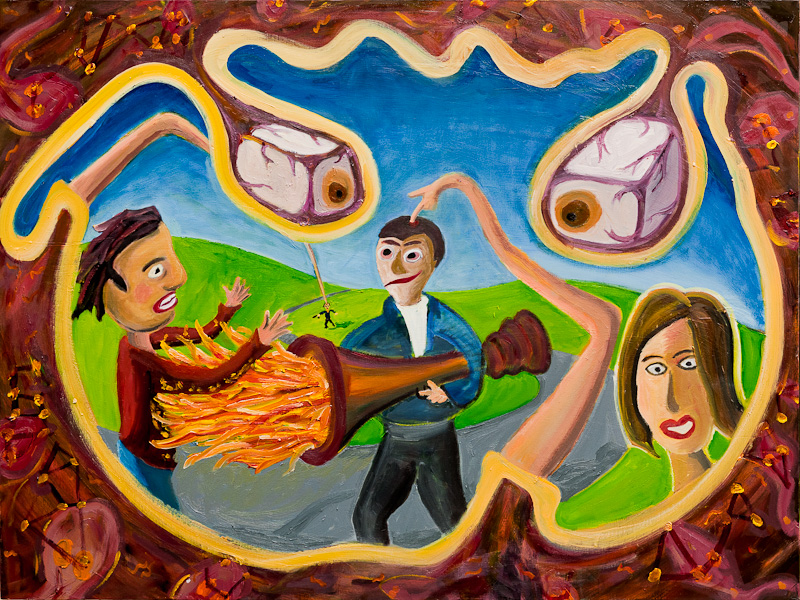
Oil on canvas. 40" by 30". March, 2011.
In this painting I wanted to create a rendition of an extreme first-person point of view…in which we see the dim zone around a person's actual visual field. The person in question is the Alan Turing character in my novel The Turing Chronicles. He has become a mutant known as a "skugger," and he has the ability to stretch his limbs like the cartoon character Plastic Man. He is traveling across the West with two friends, a man and a woman. In this scene, Turing's cohort is being attacked by secret police, one of whom bears a flame-thrower. Turing is responding by sticking his fingers into their heads, perhaps to kill them, or perhaps to convert them into skuggers as well. We can see Turing's arms extending from the bottom edge of his visual field. Even though it's not quite logical, I painted in his eyes as well because they make the composition better.
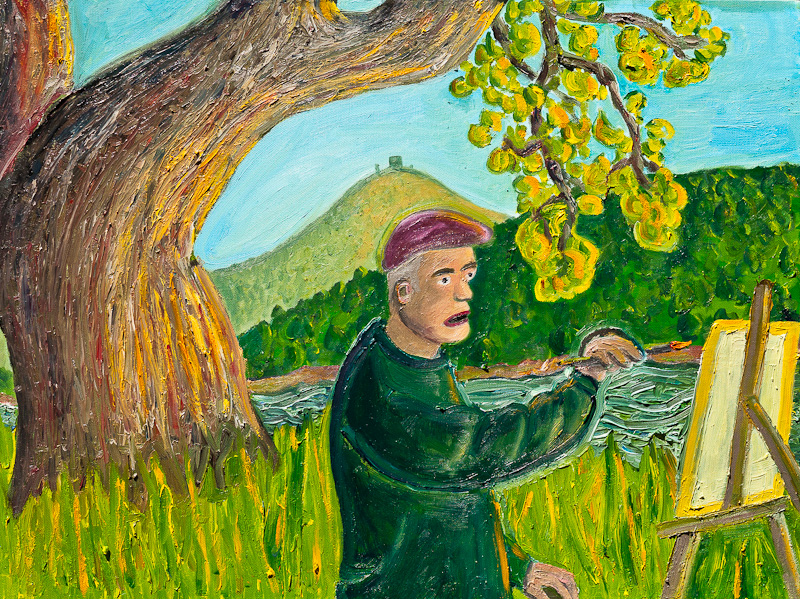
Oil on canvas. 24" by 18". June, 2011.
Vernon Head and I were painting en plein air in the Almaden Quicksilver Park south of San Jose near the Guadalupe Reservoir. I was about to get my left hip joint replaced, due to arthritis, but I led Vernon up to a nice oak I admired on a hilltop. I framed my picture to include the reservoir, Vernon, the oak, and Mount Umunhum in the background. "Umunhum" is an Ohlone word meaning "home of the hummingbird." The box on top is a leftover from an Air Force radar station, and it's due to come down…someday. I layered on my paint thicker than usual, using my palette knife to imitate the grooves of the bark on the tree, the waves in the water, and the long stalks of grass.
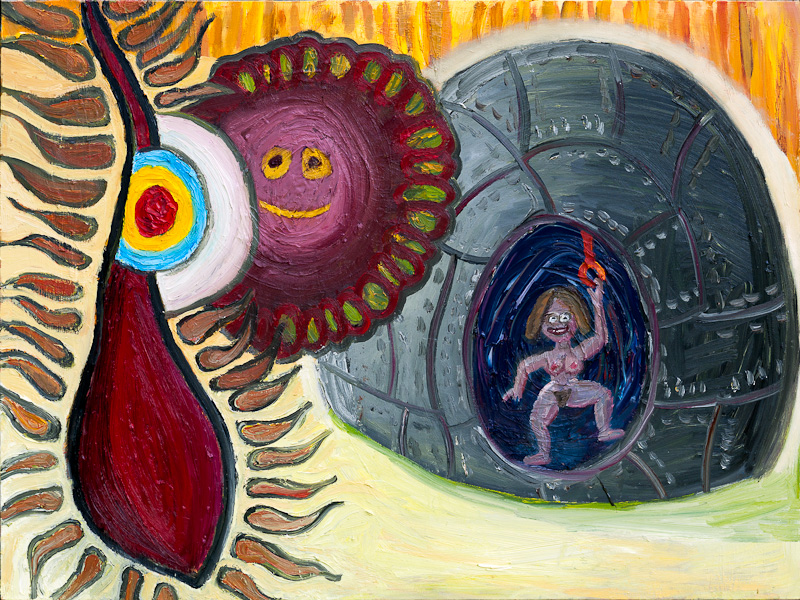
Oil on canvas. 40" by 30". July, 2011.
This painting has to do with my novel, The Turing Chronicles. In the last chapter, my hero, Alan Turing gets inside a nuclear weapon called a V-bomb. I figured this lies beyond the A-bomb and the H-bomb. Also, I occasionally use "V-bomb" as a nickname for Sylvia. Turing is in there tweaking the bomb until the last minute. And due to Turing's efforts, the bomb explodes in an odd fashion: it makes a fireball that shrinks, rather than growing—and then the bomb explosion tears a hole in space and disappears into another dimension or into another level of reality. The early nuclear devices really were hut-sized metal constructs, as shown on the right. Somehow I ended up putting a naked woman inside the bomb instead of Turing. In the middle we have a kind of sunflower/fireball with a zonked face on it. And on the left, a small explosion-ball disappears into a vaginal rent. The woman seems to be pulling a cord that sets the bomb off in the first place. I like the picture because, as with some of Bruegel's paintings, it seems to illustrate a detailed parable whose precise meaning is forever a mystery.
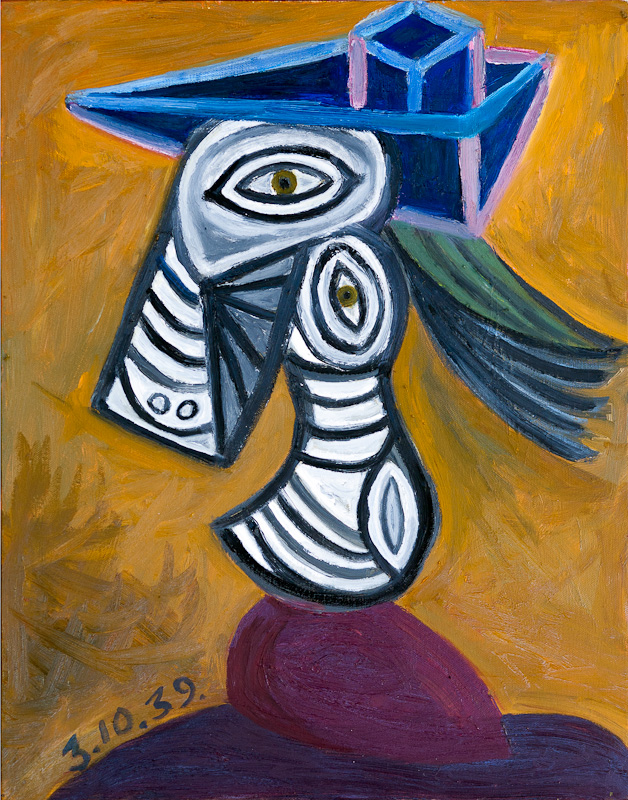
Oil on canvas. 18" by 24". July, 2011.
Imagined news story: "A 1939 Picasso painting, Woman in Blue Hat, which was stolen from the Picasso show at the DeYoung Museum in San Francisco, has now been located in the home of an ex-professor who styles himself as a painter and a writer." Software theft that is. I liked this painting so much after seeing it at the show, I painted a copy as a kind of homage—and to learn a little more about how Picasso did it. The more I worked on this painting, the more little things I saw. I missed quite a few of the master's tricks, but eventually I was happy with how my version looked—it had become mine. Stolen.
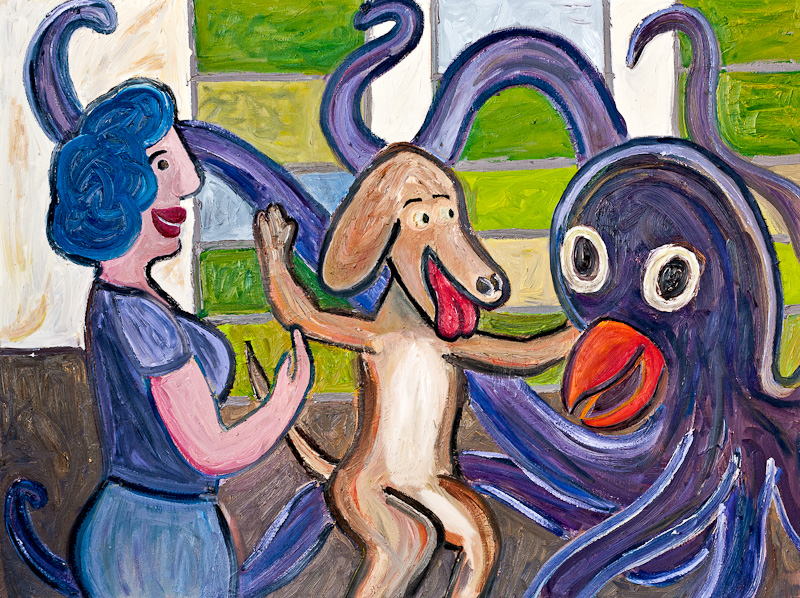
Oil on canvas. 40" by 30". August, 2011.
This is one of those pictures that is a bit like an unknown parable. I started out with a set of pebble-glass windows that I like, making a background grid of green and yellow rectangles. I put three characters in front of the windows, happy to be getting together in the daytime: a woman, a dog, and an octopus. I feel like these three friends are people I know. Indeed, I might be the dog in the middle, bringing the two others together—I've mentioned that I used to have a dog who looked a lot like that, Arf. When I told Vernon about the theme of my new picture, he said, laughing, "Ah, yes, the three fundamental elements of any successful painting: a woman, a dog, and an octopus." My other artist friend Paul Mavrides had suggested that I try using an impasto medium to build up more of a texture on my pictures and I did this here, with a nice effect.
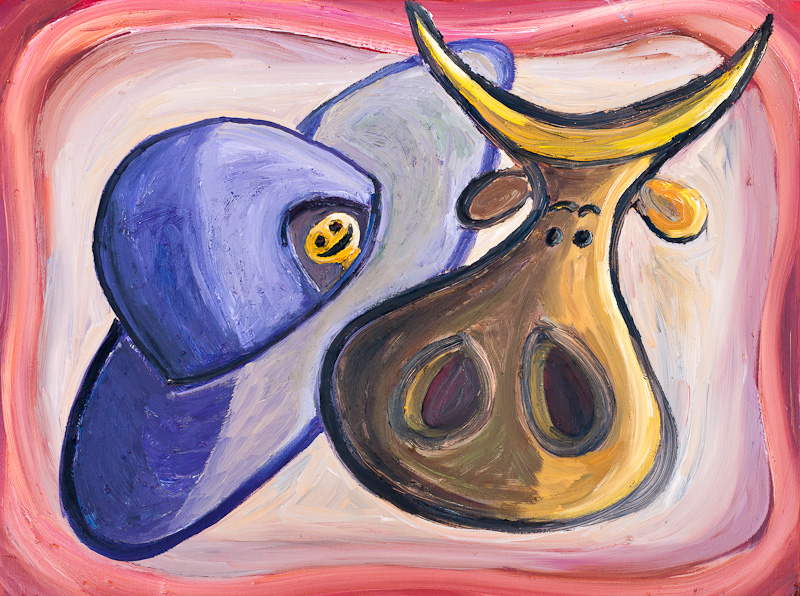
Oil on canvas. 24" by 18". August, 2011.
I like to use certain simple images when I'm scribbling a drawing for my children or grandchildren. Over the years, I've honed my favorites down to clean, cartoony icons—such as the "Cow and UFO" shown in this painting. Back to basics!
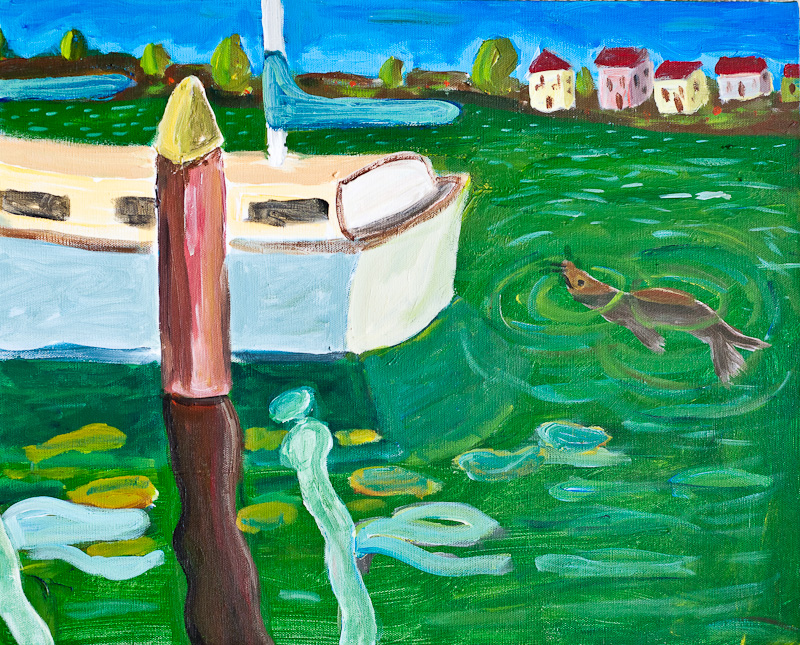
Acrylic on canvas. 20" by 16". September, 2011.
Vernon and I went to Santa Cruz Harbor for a painting session. The waters were full of life—apparantly a school of mackerel had swum in, and the pelicans and seals were there feeding. I liked how this cute baby seal seemed to hover so weightlessly in the very clear water. I started this painting on the spot, and finished it at home, working with some photographs I'd taken. It had been awhile since I used acrylics, and I was pleasantly surprised by how quickly I was done.
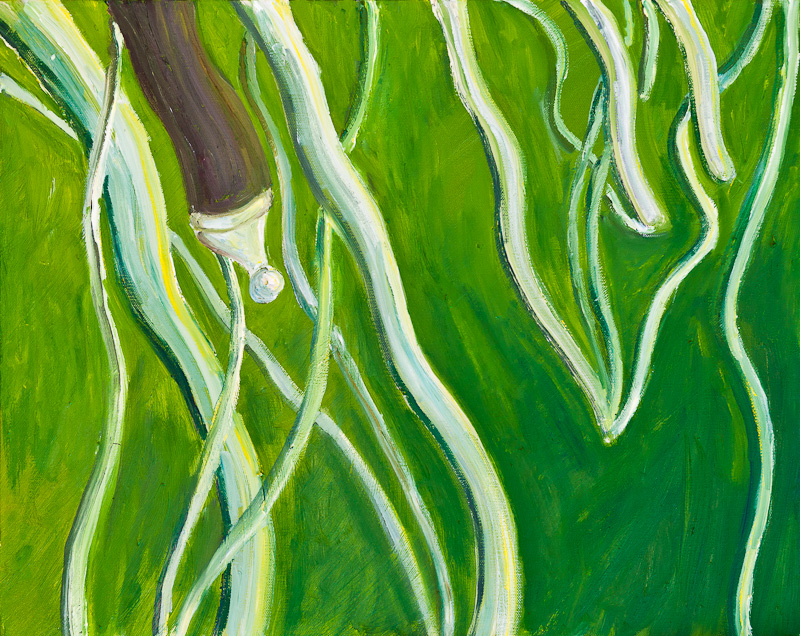
Oil on canvas. 20" by 16". September, 2011.
The reflections of sailboat rigging fascinate me. I took some photos for this painting during the same session where I started 85: Santa Cruz Harbor. Back home I copied one of the photos for an oil painting. I put on quite a few layers, and used a gel impasto medium to emphasize the brush strokes on the masts and lines.
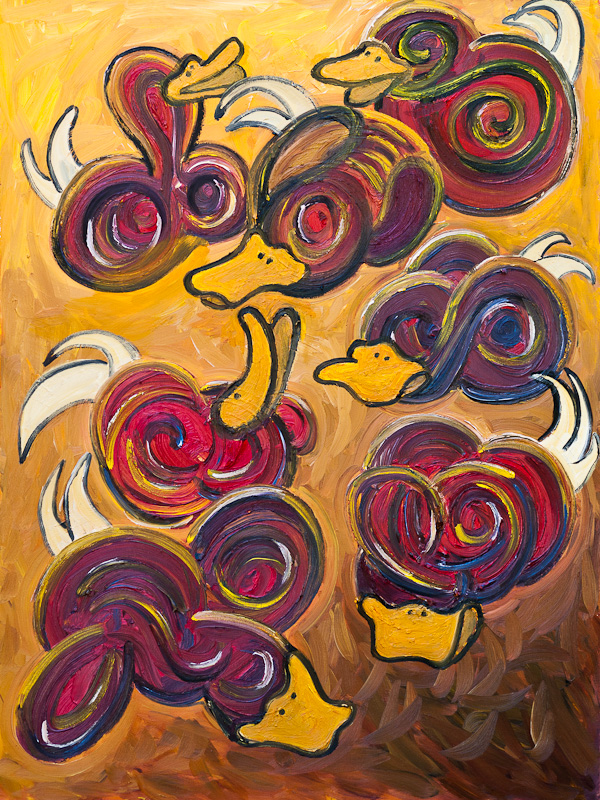
Oil on canvas. 30" by 40". October, 2011.
I started with an abstract painting with seven globs. I made efforts to make the globs look different from each other, and to have intricate, three-dimensional forms. And then I started thinking of the globs as cross-sections of four-dimensional creatures. And then I realized they should be loosely based on the master cartoonist Carl Barks’s drawings of Donald Duck, as if they were rotating in and out of our space. Four-dimensional ducks. A way to move my pop surrealism style towards abstraction.
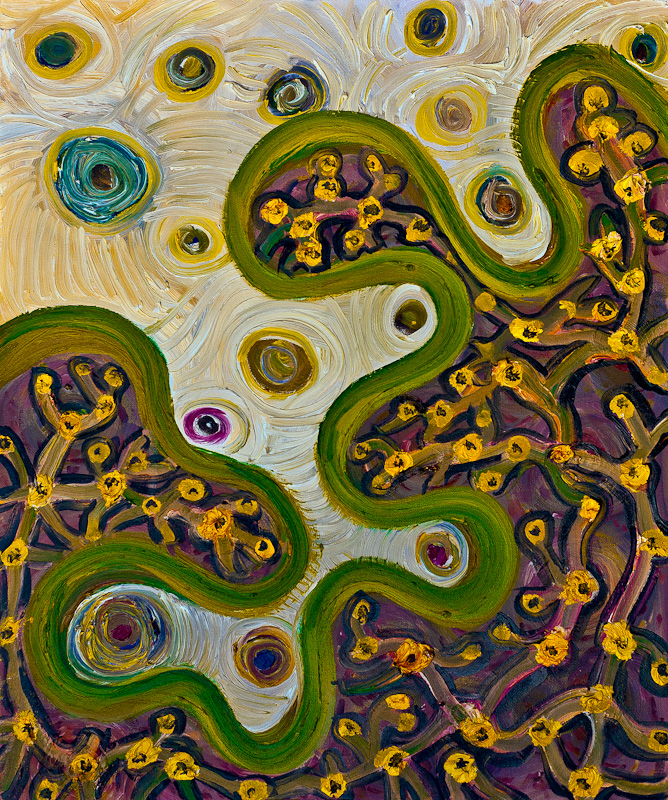
Oil on canvas. 20" by 24". November, 2011.
This is a fairly abstract picture. I started it with that squiggly green line. And then I had the idea of making the lower part be like the surface of some jungly world, with the upper part being like the sky above. The yellow network might be a kind of planetary mind, or perhaps it’s the nervous system of a blog-creature. I used an impasto medium on this picture in order to get a lot of surface texture.
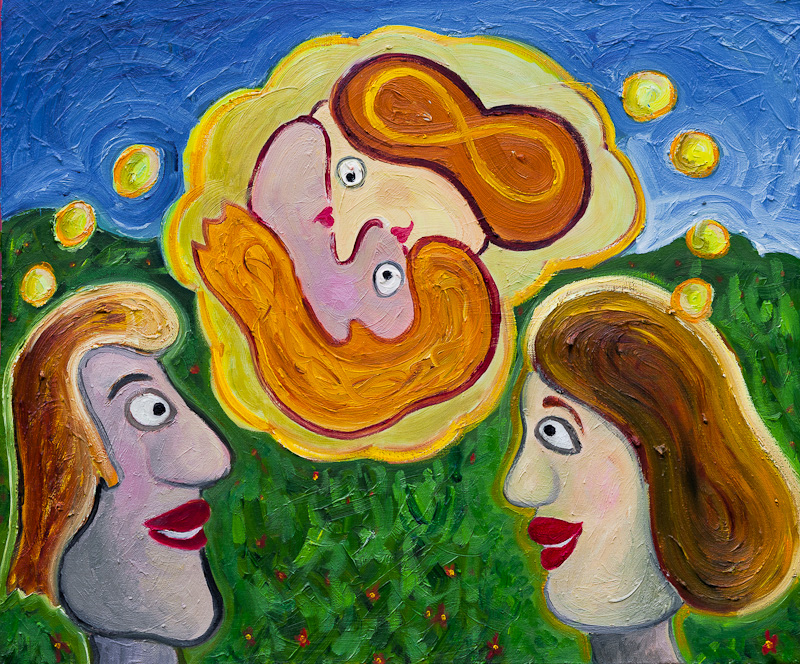
Oil on canvas. 20" by 24". January, 2012.
The idea is that these two lovers are in a nearly telepathic state, sharing a single thought balloon. And in the thought, they’re merged like a yin-yang symbol. Her 1940s bob acquires an infinity symbol, and their lips form a pair of little hearts. An early Valentine’s Day picture!
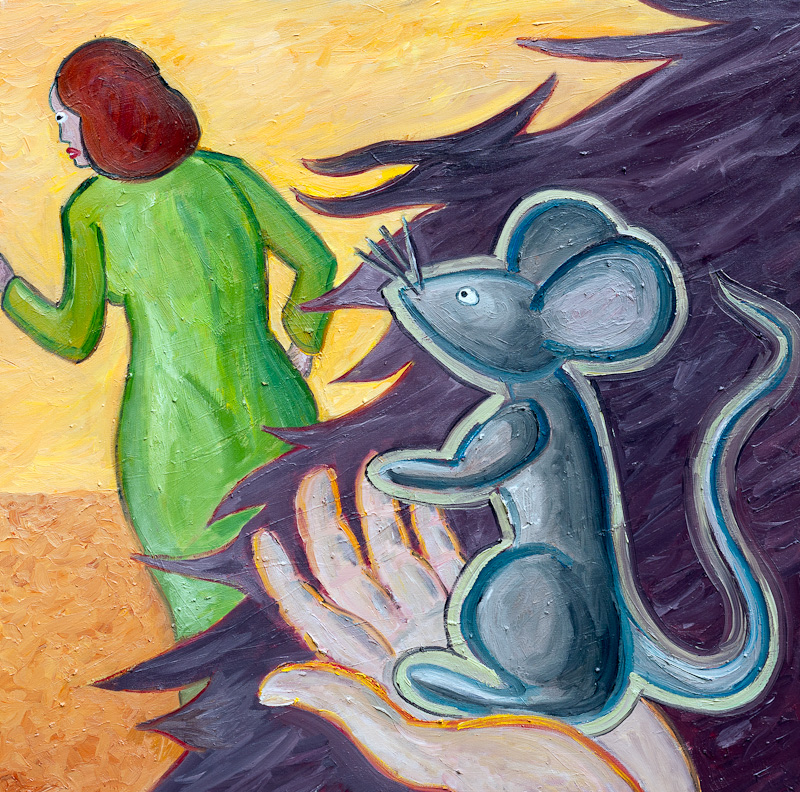
Oil on canvas. 30" by 30". February, 2011.
Loulou is the somewhat mysterious woman in green, Skungy is the rat, and the guy holding the rat is named Morton Plant. At present this is like an illustration of an unknown proverb or a forgotten fable. I don’t entirely know what’s going on. But I do have some ideas, as this is meant to be a previsualization of a scene in my next novel, The Big Aha. Loulou is luring Morton and his helper-rat Skungy to follow her. The composition was inspired by a Joan Brown painting The End of the Affair.
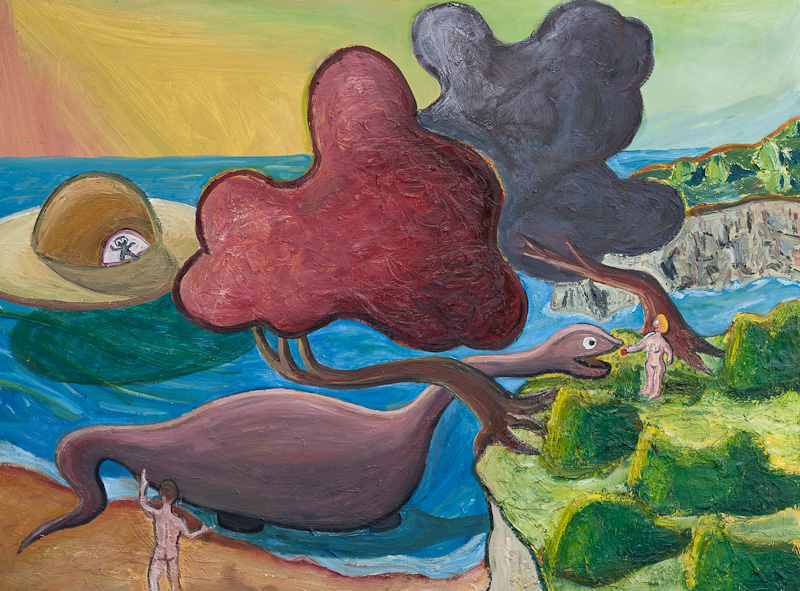
Oil on canvas. 40" by 30". May, 2011.
My frequent partner in art, Vernon Head, went out for an en plein air painting session with me on the bank of a stream that runs into the south end of Lexington Reservoir near Los Gatos. It was a lovely spring day, and we daubed away. The one thing that caught my attention the most was a particular bend in the trunk of a tree overhanging the creek. That made it into my painting, but not all that much else about the actual scene. Instead I put in two of my favorite things: a dinosaur and a UFO. I’m not exactly sure what the scenario here is—perhaps the UFO is in some way bringing enlightenment to a prehistoric pair, an Adam and an Eve.
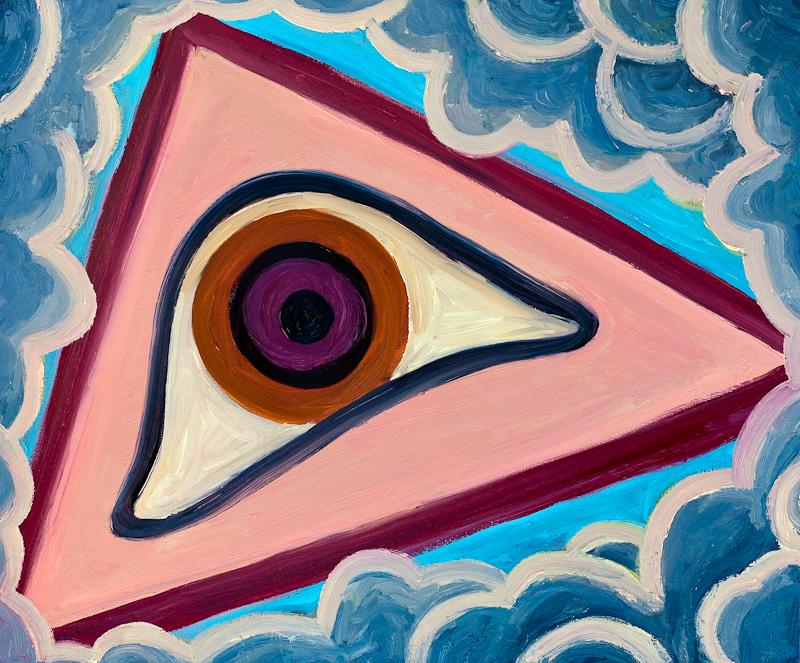
Oil on canvas. 24" by 20". June, 2011.
I’ve always been intrigued by a certain image that one sees in old European churches—an eye inside a triangle. This icon also appears, of course, on the dollar bill. It’s meant to represent the all-seeing eye of God or perhaps the divine light within every object. In researching my novels with Bruegel and Bosch as characters, I got the impression that medieval people really did think God was watching them. So here I’ve painted the eye as looking down through clouds—like a spy-satellite. I made the “skin” in this image pink as a kind of joke on the fact that God is sometimes visualized as an old white man. What expression does the eye seem to have? I’d say it looks engrossed, with a possibility of becoming judgmental.
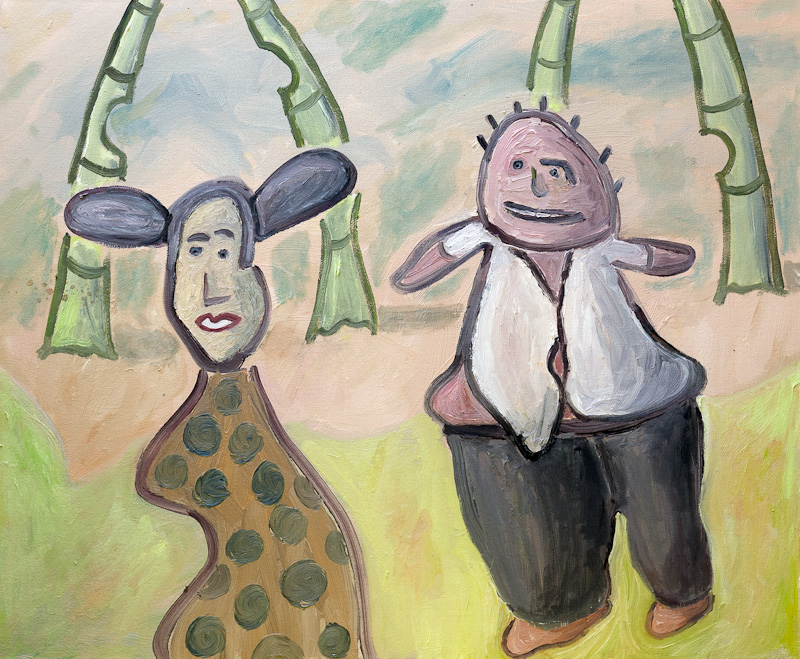
Oil on canvas. 24" by 20". October, 2012.
I grew up in Louisville, Kentucky, so the title of this picture is a bit of a parodistic self-image riff. In other words, that‘s could be me on the right , shirt all untucked and with no fingers on my hands. The woman might be my muse. Another interpretation is that the two figures are characters from the novel, The Big Aha, which I was working on when I made the painting. In making this picture, I thought it would be interesting to put in some figures that looked like children‘s drawings, so I worked from a messy sketch I‘d made. The colors are more pastel than usual for me, and there‘s a bit of a Japanese quality.
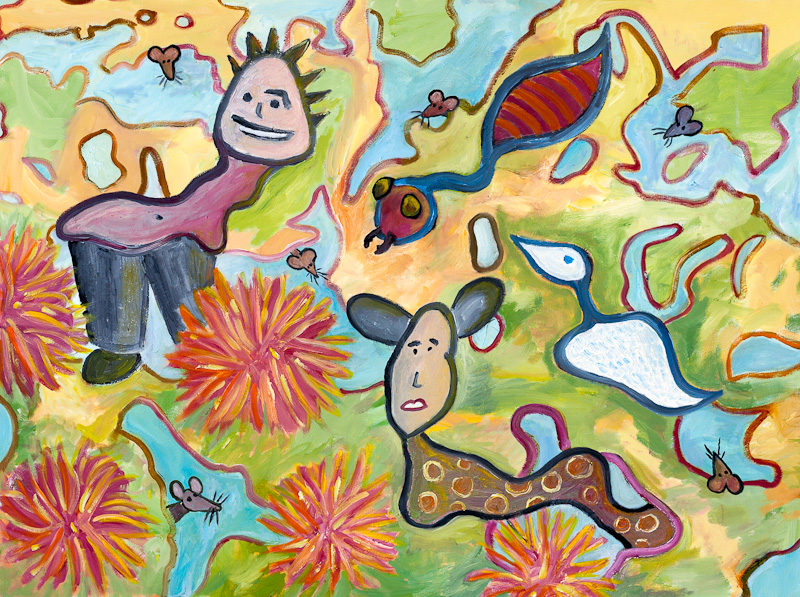
Oil on canvas. 40" by 30". November, 2012.
This painting started out with the abstract background pattern, which I made using leftover paint from Louisville Artist. I decided to put in some figures in, and I thought I‘d like to reuse the Louisville Artist figures. In the novel, The Big Aha, that I was working on at this time, the two characters (at this point named Zad and Loulou) had spent a night in bed in in telepathic contact with each other. And I wanted to give an impression of an odd, dreamy night. The six little rats correspond to some subdimensional creatures that might be scuttling around inside people‘s dreams. And the other creatures are just there for fun.
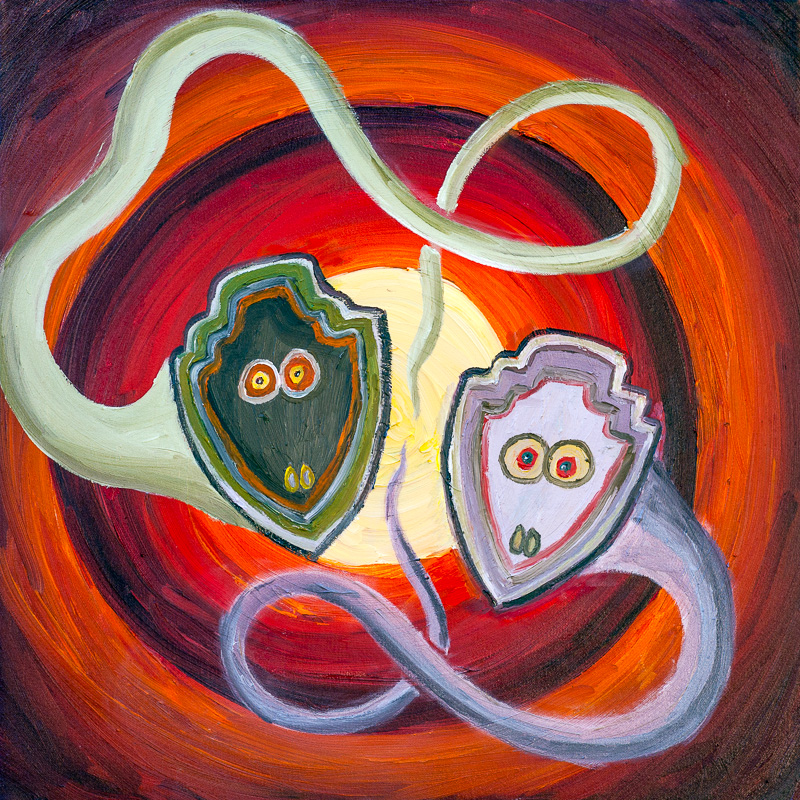
Oil on canvas. 24" by 25". March, 2013.
Working on my novel The Big Aha, I was trying to visualize a pair of warring supernatural beings in the background, and I came up with these guys. They‘re like lizards, a little bit, with long tails going off into the beyond. The background is based on the start sequence seen in old Warner Brothers cartoons of the Merrie Melodies or Loony Toons ilk—a colorful tunnel or perhaps a sequence of doors.
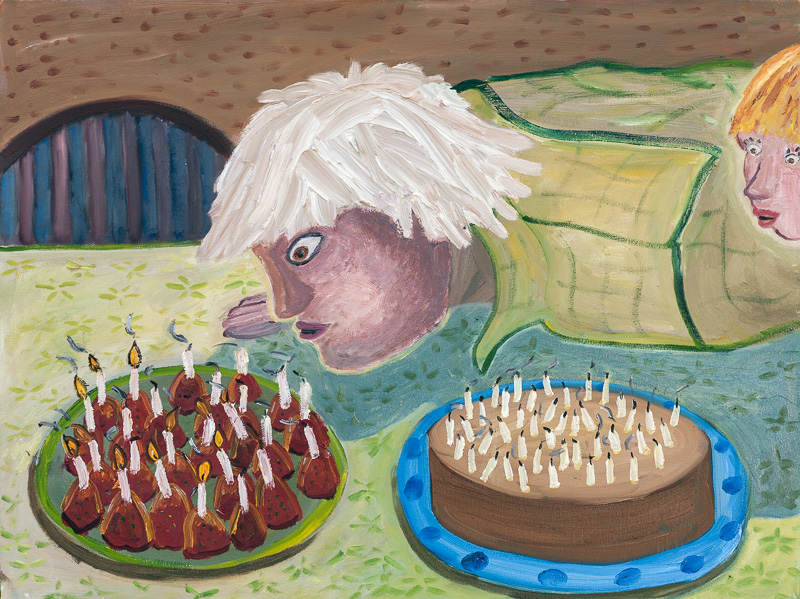
Oil on canvas. 24" by 18". March, 2013.
I based this painting on a photo taken of me on my birthday. Grandpa has 67 candles --- 42 on the cake and 25 stuck into strawberries. A granddaughter is helping him. I like Grandpa‘s hair, and the patterns that in the tablecloth.
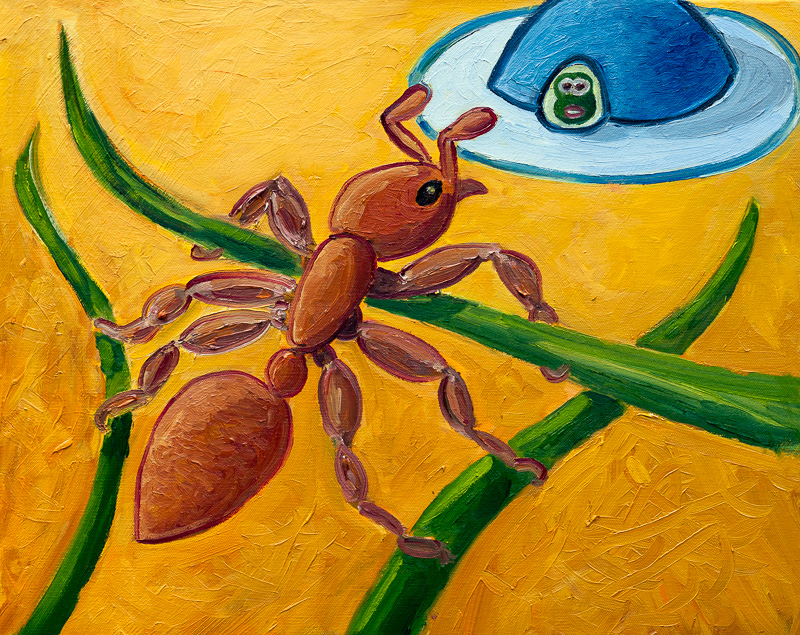
Oil on canvas. 20" by 16". June, 2013.
Somebody mentioned that they‘d like to see me do another ant painting. I searched the web for good images of ants and I found a nice clear drawing in an exterminator‘s ad. After I‘d painted the ant, I wasn‘t sure what else to put in, although I was thinking it would be nice to have a tiny UFO—another of my recurrent motifs. The ant‘s body was at an odd angle, and then I had the idea of having her standing on three blades of grass, which made for a nice composition.
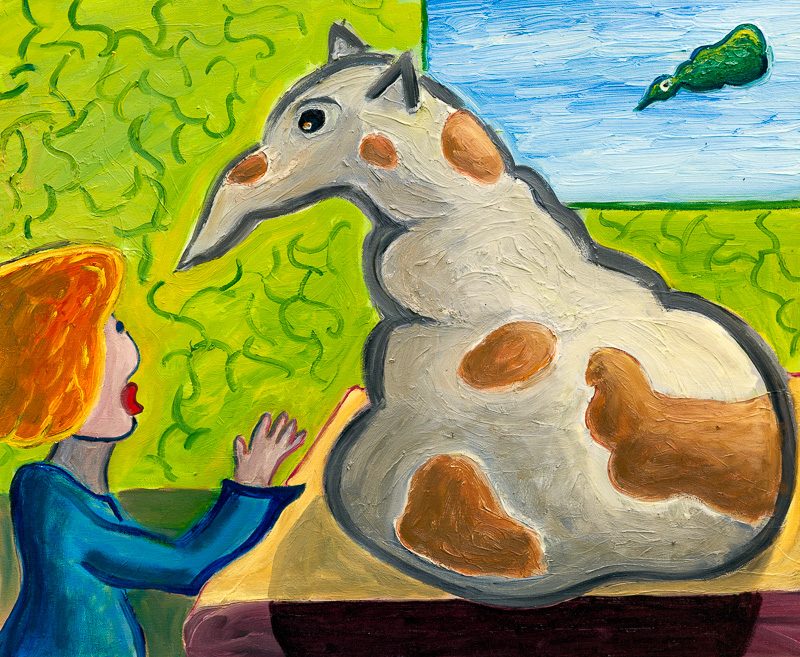
Oil on canvas. 24" by 20". June, 2013.
I always like the idea of a painting that seems like an illustration of some unknown proverb or fable. At a metaphorical level, the gub might symbolize some kind of marriage problem. At a more factual level, the painting relates to my novel, The Big Aha, which features unprepossessing yet god-like alien beings called gubs. The piebald gub shown here is named Duffie, and he‘s in love with a green female gub named Sedusa—you can glimpse her in the sky outside the window. The gub is perched on my character Jane‘s bed, and he isn‘t particularly welcome there, as he‘s somewhat shabby and unclean.
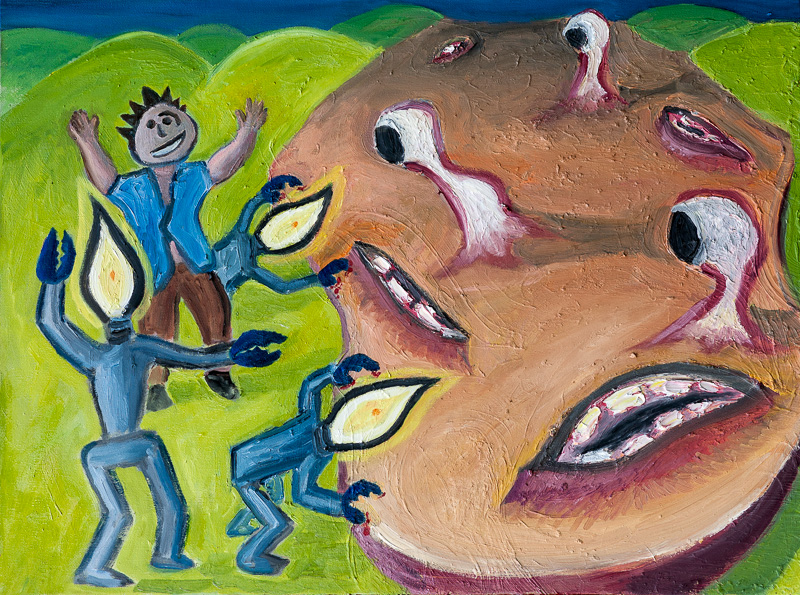
Oil on canvas. 24" by 18". July, 2013.
This is another of my paintings for my SF novel, The Big Aha. The picture has to do with a scene where my hero has sicced some creatures called Mr. Normals on a sinister giant alien slug called a myoor. In the process of making this painting, I decided to make the Mr. Normals look like Gyro Gearloose‘s Little Bulb in the old Donald Duck comics. The way I painted the hero matches my two earlier paintings 93: Louisville Artist and 94: Night of Telepathy. In a certain very loose sense these are self-portraits.
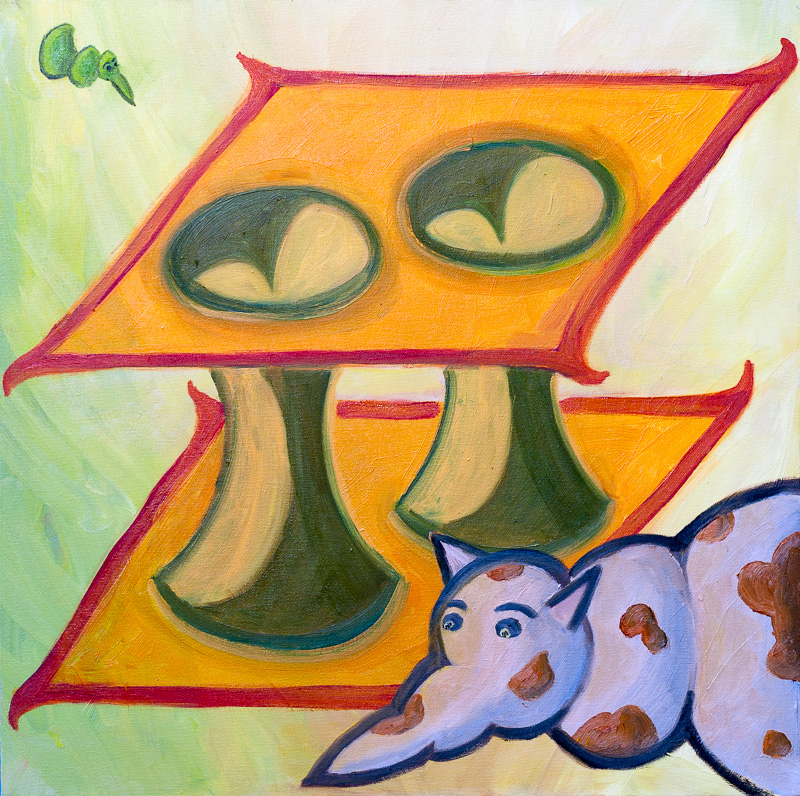
Oil on canvas. 22" by 22". July, 2013.
Yet another painting relating to my novel, The Big Aha. This painting started with a depiction of two wormholes, also known as Einstein-Rosen bridges. Wormholes can act as tunnels connecting two parallel universes. For the purpose of illustrating this concept, I‘m depicting the universes as simple planes in this painting. Although the purely geometric version of this painting looked nice, I felt it needed some life. So I went ahead and included two of the alien creatures that I‘m calling gubs in The Big Aha. I like how alertly the green gub is watching the spotted one.
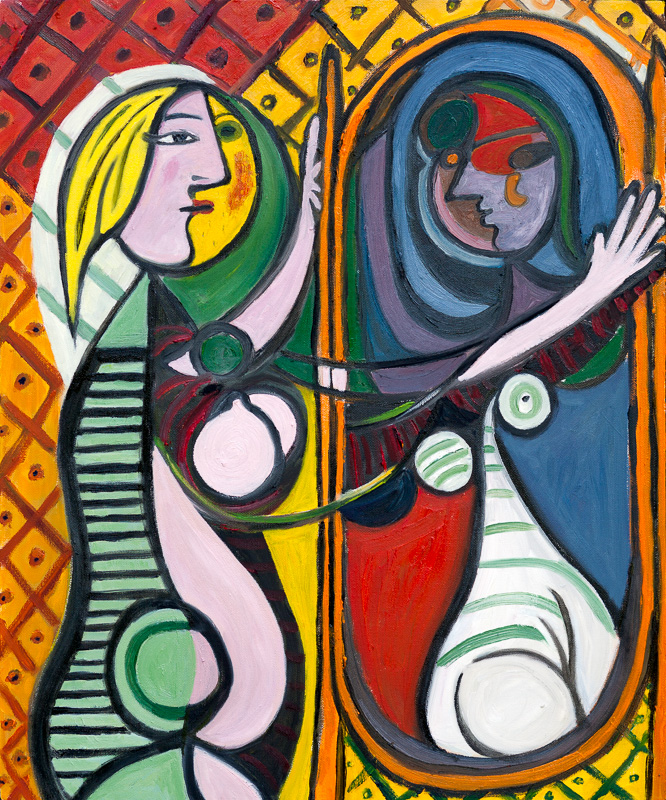
Oil on canvas. 20" by 24". August, 2013.
This has always been a favorite painting of Sylvia‘s, and I love it as well. It was lots of work to copy it, as so many details kept unfolding. I‘d never quite understood the face of the shadow woman on the right, but I learned how to see it. Also I‘d never before realized that the woman on the left is pregnant. Her hands can‘t penetrate in the mirror world, but it looks as if some sketchy, skinny arms might be reaching out. For my final sessions, I put the original out of sight and focused on making my version smooth and balanced. Fun. If only I had enough momentum to keep painting like this on my own!
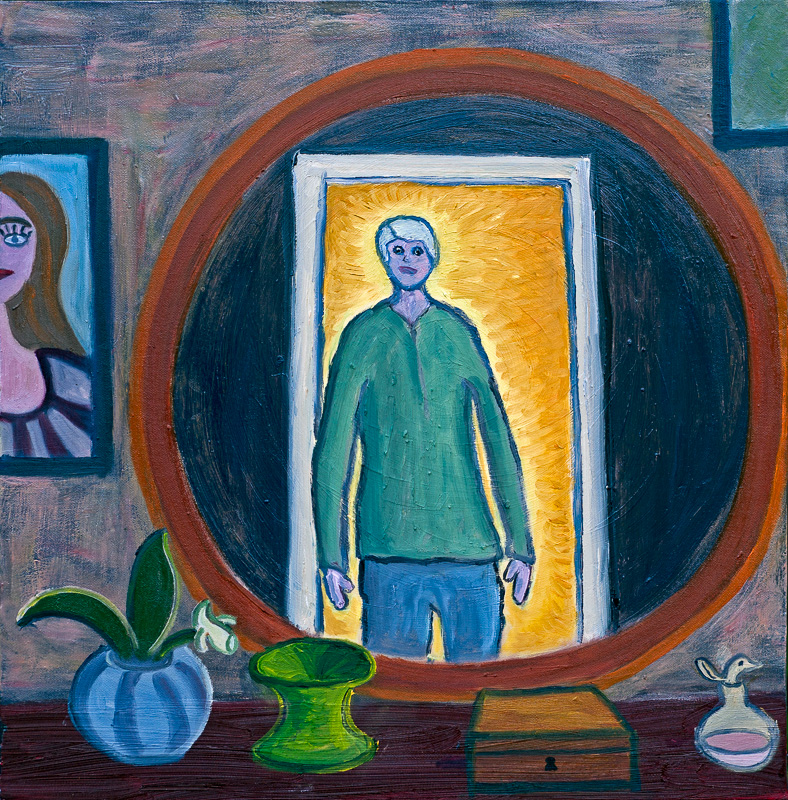
Oil on canvas. 22" by 22". July, 2013.
This is a painting of our bedroom, showing Sylvia‘s mirror and some of the things on her dressing-table. That painting on the left is by her, it‘s called Kate Croy. I got the idea for the painting when I was coming into our room, and it was dark, and the hall-light behind me was on, haloing my silhouette in light, and I saw myself in the mirror. I like the little objects on the dressing-table, they‘re like symbolic icons in a medieval portrait—but they mainly represent aspects of Sylvia. That green shape is a bridge between two realities, carried over from 100: Gubs and Wormholes.
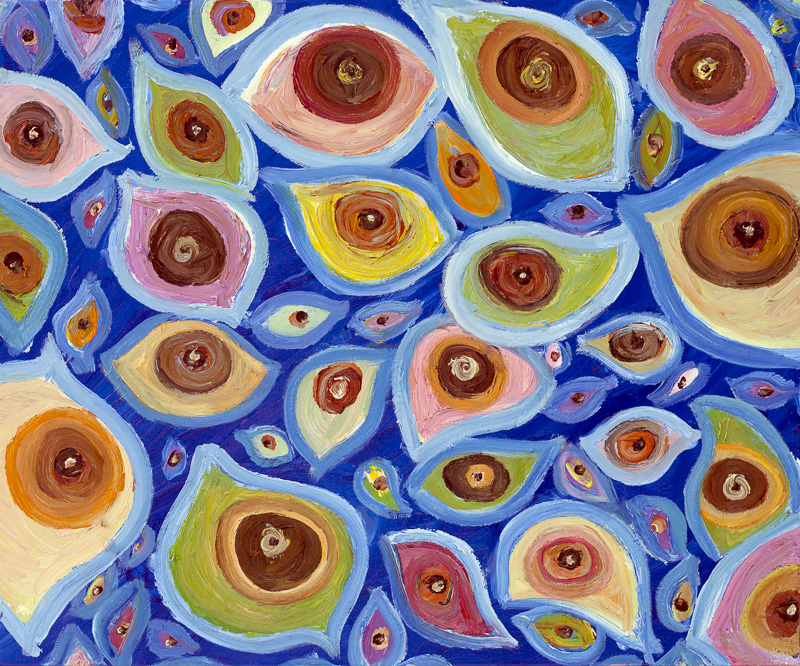
Oil on canvas. 20" by 24". October, 2013.
This was an easy painting to make I just did a lot of eyes. I didn’t particularly try to make them scary. I was more interested in them looking alert. I had fun with the colors, getting all the shades to be fairly even intensities of mild pastel colors.
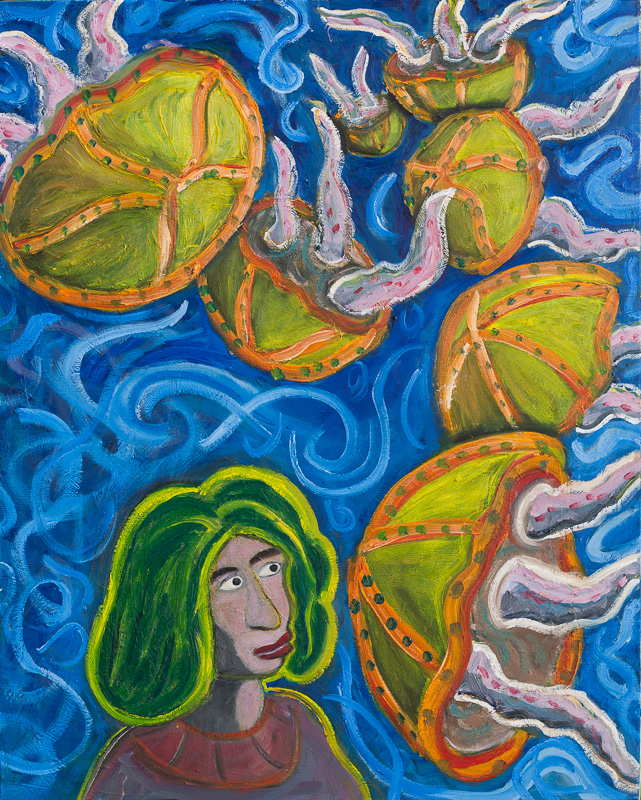
Oil on canvas. 24" by 30". December, 2013.
At the Monterey Bay Aquarium, my wife and I admired a big tank of sea nettle jellyfish. I took a photo of her by the tank, and at first I wanted to paint that. But in the end, the woman didn’t look at all like my wife, and the painting’s viewpoint suggests that either we’re looking out from inside the tank at the woman, or maybe the jellyfish are floating around in mid-air. I gave the woman green hair and made her kind of punky. I think she’s talking with that big jellyfish.
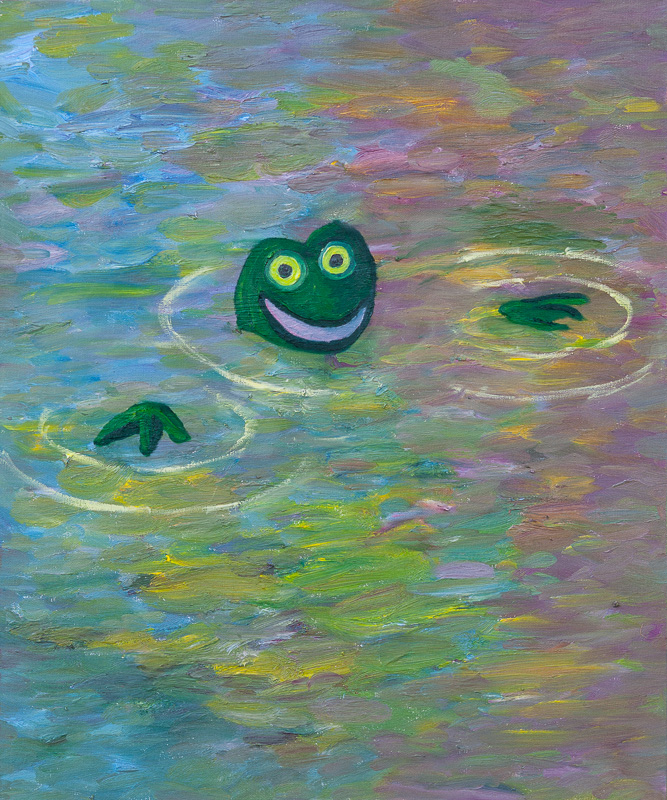
Oil on canvas. 20" by 24". January, 2014.
This painting started out as a horizontal canvas of a Monet-style scene with trees and cliff or a sky…made up of vertical daubs of paint left over from Woman With Jellyfish.. I let the landscape dry for two weeks, then had the idea of turning the picture to a vertical orientation, and now the horizontal daubs were water. On a quick inspiration, I painted in the head and webbed hands of a “frog man.” He looks friendly, but I don’t think I’d jump into the water with him.
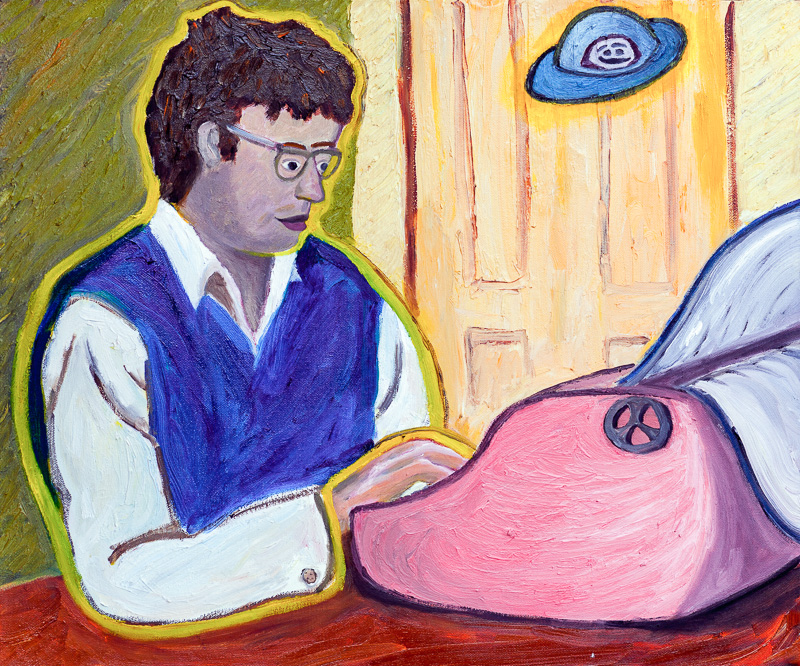
Oil on canvas. 24" by 20". February, 2014.
The painting is based on a 1983 photo of me. I was working on Kerouac-style novel called All The Visions—I typed it on a single long scroll of paper. I still have that rose red IBM Selectric typewriter in my basement. The acme of modern writing equipment in 1983. I wrote a lot of books on that thing.
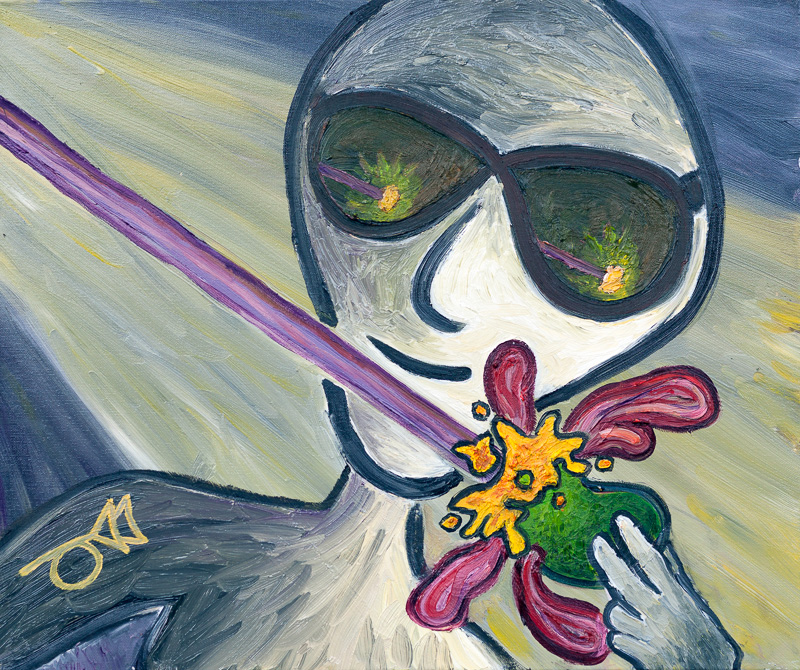
Oil on canvas. 24" by 20". February, 2014.
I made this painting while I was working on an SF story, also called “Laser Shades. ” The story was for inclusion in an art book, The Superlative Light, by the photographer Robert Shults. The book shows photos of a petawatt laser lab, where “petawatt” means that the laser beams being generated are insanely powerful. I wasn’t quite sure how to end my story, this painting was my way of previsualizing a climactic scene. The guy is wearing special laser-proof shades and he’s (rather unwisely) holding a fetal “egg” in the path of a powerful laser beam. That zapped egg is going to hatch out some kind of weird person, so look out!
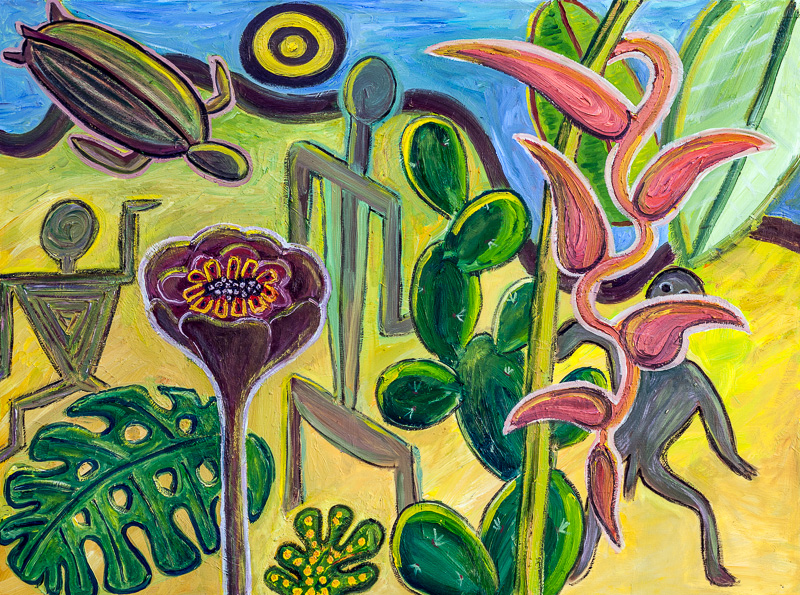
Oil on canvas. 40" by 30". March, 2014.
Petroglyph Man shows three big plants and three petroglyphs, although the guy on the right is perhaps morphing into something more. This painting has to do with an experience I had on a trip to the big island of Hawaii in 2007—I had stepped on a petroglyph carving and I was imagining that it might come to life. I paintined this picture while working on a short story called "Petroglyph Man" as well.
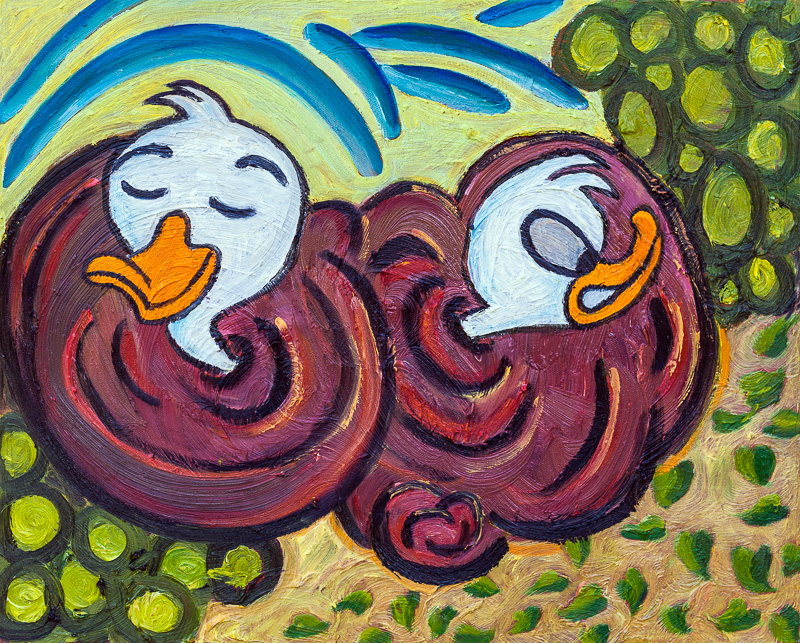
Oil on canvas. 20" by 16". April, 2014.
I went back to the Carl Barks drawings of Donald Duck for this one. I used a lot of impasto to build up the tornado-like clouds. The two ducks might be two people you know, or the warring dyad within yourself, or the cosmic yin/yang. Or all of the above. Which are you today...the calm duck or the angry duck?
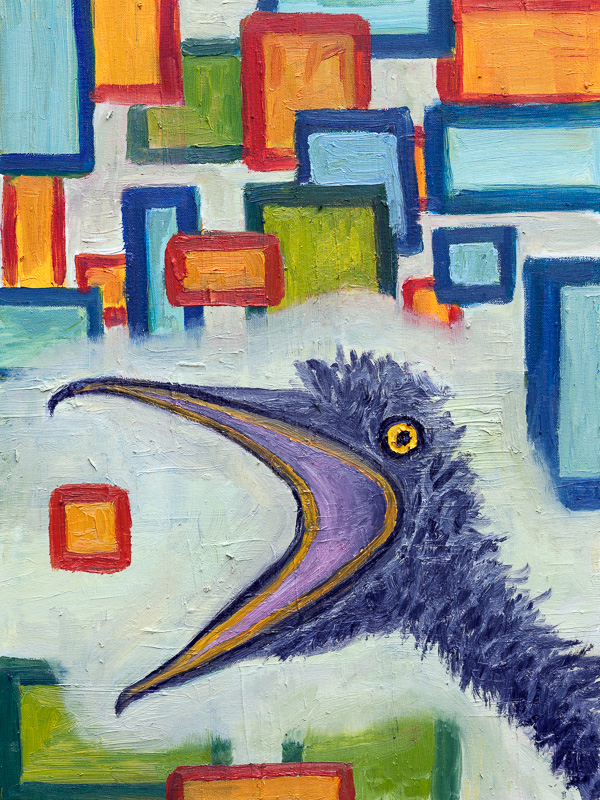
Oil on canvas. 18" by 24". May, 2014.
I like how the bird is about to eat a yellow square from the underlying pattern of squares and rectangles. Maybe he’s come into this abstract world from the funky analog world and he’s eating it. I had painted the background pattern a couple of weeks earlier, and then one morning I saw an article in the paper, with a photo of a hungry baby black-crested night heron, and I added him to the picture.
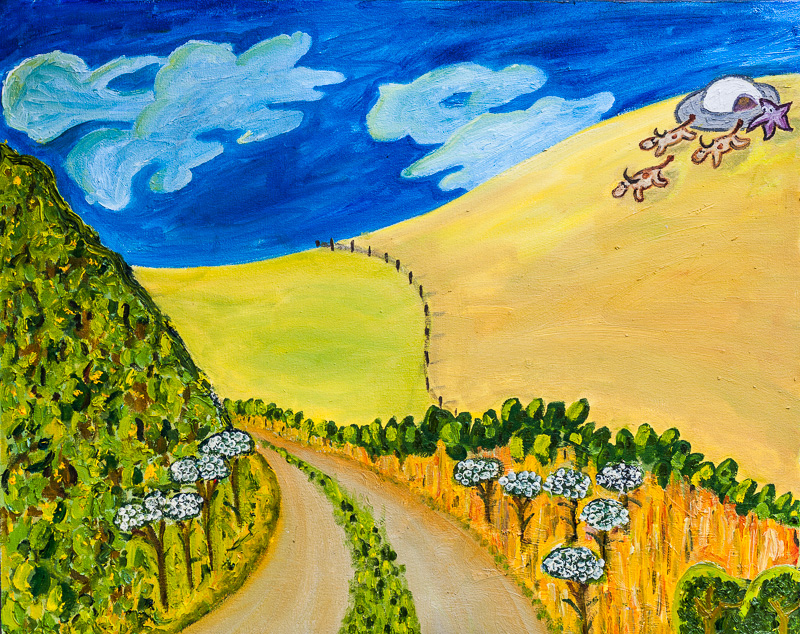
Oil on canvas. 30" by 24". June, 2014.
This landscape shows the hills above Alum Rock Park in East San Jose. I felt the picture needed something extra, so I went for a saucer and a hungry, starfish-shaped alien. And everyone knows how aliens feel about cows. Even the cows know! I painted the cows a little large for how far away they’re meant to be—but these cows are important, and I wanted to give the viewer a good look at them. They kind of make me laugh.
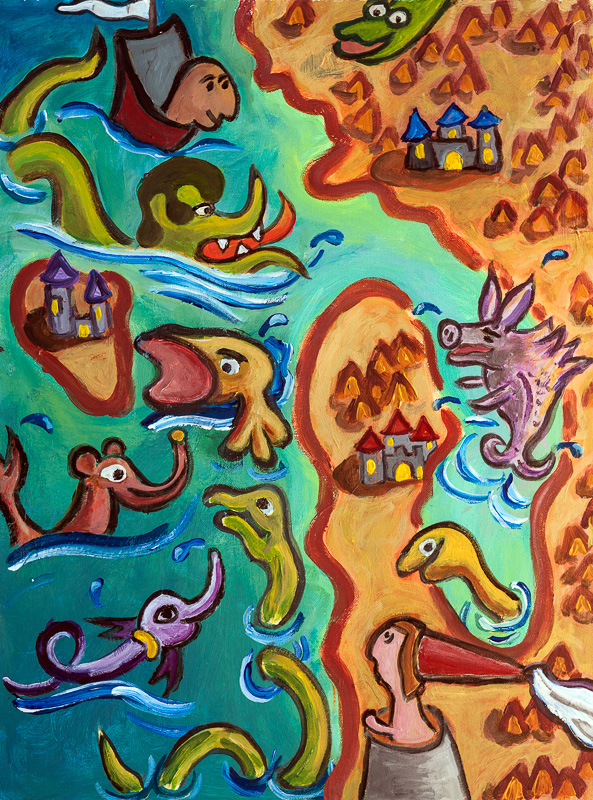
Acrylic on canvas. 18" by 24". June, 2014.
I made this painting after studying a picture book about the monsters that appear in the blank spaces of medieval and Renaissance maps. It amused me to learn the “sea pig” was often included. To amp up the picture I added a questing youth and a maiden in a tower. I like her expression. For her, maybe that guy in the boat is just another sea monster.